Page 1

CCD-TR311/TR311E/TR411E/TR412E/TR511E/
TR512E/TR640E/TR730E/TR840E/TR845E
RMT-708/717
SERVICE MANUAL
Photo : CCD-TR840E
: RMT-708
B MECHANISM
SPECIFICATIONS
Video camera recorder
System
Video recording system
2 Rotary heads
Helical scanning FM system
Audio recording system
Rotary heads, FM system
Video signal
CCD-TR311 : NTSC color, EIA
standards
CCD-TR311E/TR411E/TR511E/
TR512E/TR640E/TR730E/TR840E/
TR845E : PAL color, EIA standerds
Usable cassette
8mm video format cassette
CCD-TR311/TR311E/TR411E/TR412E/
TR511E/TR512E/TR640E/TR730E :
standard 8
CCD-TR840E/TR845E :
Hi8 or standard 8
Recording / Playback time
(using 90 min. cassette)
SP mode: 1 hour and 30 minutes
LP mode: 3 hours
Fastforward/rewind time
(using 90 min. cassette)
Approx. 5 min.
Image device
CCD (Charge Coupled Device)
Viewfinder
Electronic viewfinder
CCD-TR311/TR311E/TR411E/TR412E/
TR511E/TR640E/TR840E/TR845E :
Monochrome
CCD-TR512E/TR730E :
Color 113,578 (521 x 218)
Lens
Combined power zoom lens
Filter diameter 1 7/16 in. (37 mm)
CCD-TR411E (AEP, UK) :
16 x (Optical), 32 x (Digital)
CCD-TR412E (AEP) :
16 x (Optical), 64 x (Digital)
CCD-TR311/TR311E :
16 x (Optical), 100 x (Digital)
CCD-TR411E (EE, NE, RU) :
16 x (Optical), 160 x (Digital)
CCD-TR412E (EE, NE, RU) :
16 x (Optical), 200 x (Digital)
CCD-TR511E (AEP, UK)/TR640E
(AEP, UK)/TR840E (AEP, UK)/
TR845E : 18 x (Optical), 72 x (Digital)
CCD-TR511E (EE, NE, RU, E, HK,
AUS, CN)/TR512E/TR640E (EE, NE,
RU)/TR730E/TR840E (EE, NE, RU,
AUS) : 18 x (Optical), 220 x (Digital)
Focal distance
CCD-TR311/TR311E/TR411E/
TR412E :
3/16 - 2 5/8 in. (4.1 - 65.6 mm)
CCD-TR511E/TR512E/TR640E/
TR730E/TR840E/TR845E :
3/16 - 8 in. (4.1 - 73.8 mm)
When converted to a 35 mm still
camera
CCD-TR311/TR311E/TR411E/
TR412E :
1 9/16 - 24 7/8 in. (39.4 - 630 mm)
CCD-TR511E/TR512E :
1 9/16 - 28 in. (39.4 - 709 mm)
CCD-TR640E/TR730E/TR840E/
TR845E :
1 7/8 - 33 1/2 in. (47.2 - 850 mm)
Color temperature
Auto
Minimum illumination*
CCD-TR311/TR311E/TR411E/TR412E :
0.4 lux at F1.4 (Visible minimum low
light 0.2 lux)
CCD-TR511E/TR512E :
0.4 lux at F 1.4
CCD-TR640E/TR730E/TR840E/
TR845E : 0.7 lux at F 1.4
CCD-TR511E/TR512E/TR640E/
TR730E/TR840E/TR845E :
0 lux (in NightShot mode)**
* Minimum illumination
**Object invisible for the dark can be
Illumination range
CCD-TR311/TR311E/TR411E/
TR412E/TR511E/TR512E :
0.4 lux to 100,000 lux
CCD-TR640E/TR730E/TR840E/
TR845E : 0.7 lux to 100,000 lux
Recommended illumination
More than 100 lux
CCD-TR311/TR311E/TR411E/TR412E/TR511E/TR512E/TR640E/TR730E
HVIDEO CAMERA RECORDER
CCD-TR411E/TR412E/TR511E/TR640E/TR840E/
TR845E
UK Model
AEP Model
CCD-TR411E/TR511E/TR640E/TR840E
East European Model
North European Model
Russian Model
CCD-TR411E/TR412E/TR511E/TR640E/TR840E
E Model
CCD-TR311/TR311E/TR511E/TR512E/TR730E
Hong Kong Model
CCD-TR311E/TR511E
Australian Model
CCD-TR311E/TR511E/TR512E/TR840E
Tourist Model
CCD-TR311/TR311E
Chinese Model
CCD-TR311E/TR511E/TR512E
For MECHANISM ADJUSTMENTS, refer to
the “8mm Video MECHANICAL ADJUSTMENT
MANUAL VII” (9-973-801-11).
Input and output connectors
S video input/output
(CCD-TR840E/TR845E only)
4-pin mini DIN
Luminance signal :
1 Vp-p, 75 ohms, unbalanced
CCD-TR311 :
Chrominance signal :
0.286 Vp-p, 75 ohms, unbalanced
CCD-TR311E/TR411E/TR412E/
TR511E/TR512E/TR640E/TR730E/
TR840E/TR845E :
Chrominance signal :
expresses the light level a camcorder
requines to produce a picture. Visible
minimum low light expresses the light
level to produce a visible signal.
shot with infrared lighting.
0.3 Vp-p, 75 ohms, unbalanced
Video input
(CCD-TR840E : AUS only)/output
Phono jack :
1 Vp-p, 75 ohms, unbalanced
— Continued on next page —
hVIDEO CAMERA RECORDER
CCD-TR840E/TR845E
MICROFILM
Page 2

Audio input
(CCD-TR840E : AUS only)/output
CCD-TR311/TR311E/TR411E/
TR412E/TR511E/TR512E/TR640E :
Monaural, Phone jack, 327 mV
CCD-TR730E/TR840E/TR845E :
Phono jacks (2: stereo L and R)
327 mV, (at output impedance 47
kilohms) impedance less than 2.2
kilohms
RFU DC OUT
Special minijack, DC 5V
Headphone jack(CCD-TR730E/
TR840E/TR845E only)
Stereo minijack (ø 3.5 mm)
LANC control jack
Stereo mini-minijack (ø 2.5 mm)
MIC jack
Minijack, 0.388mV low impedance with
2.5 to 3.0 V DC, output impedance 6.8
kilohms (ø 3.5 mm)
CCD-TR311/TR311E/TR411E/
TR412E/TR511E/TR512E/TR640E :
Monaural type
CCD-TR730E/TR840E/TR845E :
Stereo type
Intelligent accessory shoe
(CCD-TR730E/TR840E/TR845E only)
8-pin connector
General
Power requirements
7.2 V (battery pack)
8.4 V (A C power adaptor)
Average power consumption
(when using the battery pack)
During camera recording
CCD-TR311E/TR311E/TR411E/
TR412E/TR511E/TR512E : 2.5 W
CCD-TR640E : 2.6 W
CCD-TR730E/TR840E/TR845E : 2.7 W
Operating temperature
32°F to 104°F(0°C to 40°C)
Storage temperature
-4°F to +140°F(-20°C to +60°C)
Dimensions (Approx.)
CCD-TR512E/TR370E :
4 1/4 x 4 1/4 x 7 5/8 in.
(107 x 107 x 193 mm)(w/h/d)
CCD-TR311/TR311E/TR411E/
TR412E/TR511E/TR640E/TR840E/
TR845E :
4 1/4 x 4 1/4 x 8 1/4 in.
(107 x 107 x 209 mm)(w/h/d)
Mass (Approx.)
CCD-TR311/TR311E/TR411E/
TR412E/TR511E (EE, NE, RU, E, HK,
AUS, CN) : 1 lb 11 oz (790 g)
CCD-TR511E (AEP, UK)/TR512E/
TR640E/TR730E/TR840E/TR845E : 1
lb 12 oz (800 g)
excluding the battery pack, lithium
battery, cassette and shoulder strap
CCD-TR311/TR311E/TR411E/
TR412E/TR511E (EE, NE, RU, E, HK,
AUS, CN) : 2 lb (930 g)
CCD-TR511E (AEP, UK)/TR512E/
TR640E/TR730E/TR840E/TR845E : 2
lb 1 oz (940 g)
including the battery pack NP-F330,
lithium battery CR2025, cassette and
shoulder strap
Microphone
CCD-TR311/TR311E/TR411E/
TR412E/TR511E/TR512E/TR640E :
Monaural type
CCD-TR730E/TR840E/TR845E :
Stereo type
Supplied accessories
See page 4.
AC power adaptor
Power requirements
100 -240 V AC, 50/60 Hz
Power consumption
23 W
Output voltage
DC OUT: 8.4 V, 1.5 A in operating mode
Operating temperature
32°F to 104°F(0°C to 40°C)
Storage temperature
-4°F to +140°F(-20°C to +60°C)
Dimensions (Approx.)
5 x 1 9/16 x 2 1/2 in. (125 x 39 x 62
mm)(w/h/d) excluding projecting parts
Mass (Approx.)
9.8 oz (280 g) excluding power cord
Design and specifications are subject to
change without notice.
SAFETY CHECK-OUT
After correcting the original service problem, perform the following
safety checks before releasing the set to the customer:
1. Check the area of your repair for unsoldered or poorly-soldered
connections. Check the entire board surface for solder splashes
and bridges.
2. Check the interboard wiring to ensure that no wires are “pinched”
or contact high-wattage resistors.
3. Look for unauthorized replacement parts, particularly transistors,
that were installed during a previous repair. Point them out to
the customer and recommend their replacement.
4. Look for parts which, though functioning, show obvious signs
of deterioration. Point them out to the customer and recommend
their replacement.
SAFETY-RELATED COMPONENT WARNING !!
COMPONENTS IDENTIFIED BY MARK ! OR DOTTED LINE WITH
MARK ! ON THE SCHEMATIC DIAGRAMS AND IN THE P ARTS
LIST ARE CRITICAL TO SAFE OPERATION. REPLACE THESE
COMPONENTS WITH SONY PARTS WHOSE PART NUMBERS
APPEAR AS SHOWN IN THIS MANUAL OR IN SUPPLEMENTS
PUBLISHED BY SONY.
5. Check the B+ voltage to see it is at the values specified.
6. Flexible Circuit board Repairing
• Keep the temperature of the soldering iron around 270°C during
repairing.
• Do not touch the soldering iron on the same conductor of the
circuit board (within 3 times).
• Be careful not to apply force on the conductor when soldering
or unsoldering.
– 2 –
Page 3

Note1 : EE,NE,RU model is 160X
Note2 : EE,NE,R U model is 200X
Note3 : EE,NE,R U model is 220X
EE : East European Model
• Abbreviation
NE : North European Model
RU : Russian Model
HK : Hong Kong Model
AUS : Australian Model
JE : Tourist Model
CN : Chinese Model
Remark
CCD-
TR511E
E, HK,
CCD-
TR511E
AEP , UK,
CCD-
TR412E
AEP , EE,
CCD-
TR411E
AEP , UK,
CCD-
TR311E
E, A US,
CCD-
TR311
E, JE
AUS, CN
PAL
TYPE D
RMT-708G¬
EE, NE, RU
PAL
TYPE D
RMT-708G¬
NE, RU
PAL
TYPE D
RMT-708G¬
EE, NE, RU
PAL
TYPE DGG¬16X
HK, CN, JE
PAL
TYPE DGG¬16X
NTSC
TYPE EGG¬16X
16X : LSV601A, 18X : LSV600A
18X
220X
510H¬GGG
18X
72X(Note3)
510H¬GGG
16X
64X(Note2)
510HGGGG
32X(Note1)
510HGGGG
100X
510HGGGG
100X
510HGGGG
¬ : LSV600A
MonoGGGG¬G¬G
MonoGGGG¬G¬G
MonoGGGG¬GGG
MonoGGGG¬GGG
MonoGGGG¬GGG
MonoGGGG¬GGG
¬ : with VF-99 board
¬ : with MF-8500 block
Remark
¬
CCD-
TR845E
AEP
PAL
TYPE H
RMT-717¬G
¬
CCD-
TR840E
AUS
PAL
TYPE F
RMT-708¬G
CCD-
TR840E
AEP , UK,
EE, NE, RU
PAL
TYPE B
EE, NE, RU
TYPE G
PAL
TYPE C
TYPE A
RMT-708¬G
RMT-708G¬
RMT-708G¬
RMT -708G¬
G
G
G
G
CCD-
TR730EEPAL
CCD-
TR640E
CCD-
TR512E
AEP , UK,
E, A US,CNPAL
¬ : with S VIDEO terminal
16X : LSV601A, 18X : LSV600A
¬ : LSV600A
¬ : with SE-65 board SE451, 452, IC451
¬ : with VC-195 board IC204 is CXD3131
¬ : with VC-195 board IC204 is CXD3131
¬ : with VC-195 board IC204
18X
72X
760H¬¬GG
18X
220X
760H¬¬GG
18X
72X(Note3)
760H¬¬GG
18X
220X
760H¬¬¬¬
18X
72X(Note3)
760H¬¬GG
18X
220X
510H¬GGG
Stereo¬¬GG¬¬G¬
Stereo¬G¬G¬¬G¬
Stereo¬GGG¬¬G¬
Stereo¬GG¬G¬GG
MonoGGGG¬G¬G
MonoGGG¬GG¬G
¬ : with VC-195 board IC701
¬ : with FK-8500 block S005, 007
¬ : with VF-119, 120 board, LB-54 board
¬ : with VF-99 board
¬ : with VC-195 board CN909
¬ : with CF-49 board Q003, 005
¬ : with MF-8500 block
¬
¬
¬
¬
¬
¬
Digital
Model
Destination
Color System
Classification
Remote Commander
Hi8
Standard 8
Lens Optical
CCD
Night shot
Table for difference of function
Steady shot
Photo mode
Digital effect
Audio system
TBC&DNR
Time code
VTR REC
Color EVF
B/W EVF
Intelligent acssessory shoe
Normal acssessory shoe
LCD indicator backlight
Manual focus
Model
Destination
Color System
– 3 –
Digital
Classification
Remote Commander
Hi8
Standard 8
Lens Optical
CCD
Night shot
Steady shot
Photo mode
Digital effect
Audio system
TBC&DNR
Time code
VTR REC
Color EVF
B/W EVF
Intelligent acssessory shoe
Normal acssessory shoe
LCD indicator backlight
Manual focus
Page 4

Supplied accessories
1
3
7
1 Wireless Remote Commander (1)
RMT-708 : Except CCD-TR311/TR311E/TR411E/TR845E
RMT-717 : CCD-TR845E
4
8
2
56
9
2 AC-L10A/L10B/L10C AC power adaptor
3 NP-F330 Battery pack (1)
4 CR2025 Lithium Battery (1)
The lithium battery is already installed in your camcorder.
5 Size AA (R6) battery for Remote Commander (2)
6 A / V connecting cable (1)
Stereo : CCD-TR730E/TR840E/TR845E
Monaural : Except CCD-TR730E/TR840E/TR845E
7 Shoulder strap (1)
8 21 pin adaptor (1)
CCD-TR411E/TR412E/TR511E/TR640E/TR840E/TR845E
9 2 pin conversion adaptor (1)
CCD-TR311/TR311E : E, HK, JE/TR511E : E, HK/TR512E : E/TR730E : E
• Abbreviation
HK : Hong Kong Model
JE : Tourist Model
– 4 –
Page 5

SERVICE NOTE
1. POWER SUPPL Y DURING REPAIRS
In this unit, about 10 seconds after power is supplied (8.4V) to the
battery terminal using the service power cord (J-6082-223-A), the
power is shut off so that the unit cannot operate.
This following two methods are available to pr ev ent this. Take note
of which to use during repairs.
Method 1.
Connect the servicing remote commander RM-95 (J-6082-053-B)
to the LANC jack, and set the remote commander switch to the
“ADJ” side.
Method 2.
Use the DC IN terminal. (Use the AC power adaptor.)
Battery terminal
Battery switch
‘
DC IN terminal
2. TO T AKE OUT A CASSETTE WHEN NOT EJECT (FORCE EJECT)
1 Refer to 2-1. to remove the front panel block.
2 Refer to 2-2. to remove the cabinet (R) block.
3 Refer to 2-7. to remove the battery panel block.
4 Refer to 2-9. to remove the cabinet (L) block.
5 Add +5V from the DC POWER SUPPLY and unload with a
pressing the cassette lid.
6
Pull the timing belt in the direction of arrow A
with a pinsette while pressing the cassette lid
(take care not to damage) to adjust the
bending of a tape.
A
Pinsette
Timing belt
Battery SIG terminal
Press the cassette lid not to rise the
cassette compartment
[DC power supply]
(+5V)
Battery terminal
’
7
Let go your hold the cassette
lid and rise the cassette
compartment to take out a cassette.
Timing belt
– 5 –
+
Loading motor
Adjust the bending of a tape
–
Page 6

SELF-DIAGNOSIS FUNCTION
e
1. Self-diagnosis Function
When problems occur while the unit is operating, the self-diagnosis
function starts working, and displays on the viewfinder what to do.
This function consists of two display; self-diagnosis display and
service mode display.
Details of the self-diagnosis functions are provided in the Instruction
manual.
Viewfinder
C : 3 1 : 1 1
Blinks at 3.2 Hz
C
Repair by :
C : Corrected by customer
H : Corrected by dealer
E : Corrected by service engineer
3 1 1 1
Block
Indicates the appropriate step to be taken
E. g.
31 ... Reload the tape.
32 ... Turn on power again.
Detail Code
2. Self-diagnosis display
When problems occur while the unit is operating, the counter of the
viewfinder shows a 4-dig it display consisting of an alphabet and
numbers, which blinks at 3.2 Hz. This 5-character display indicates
the “repaired by:”, “block” in which the problem occurred, and
“detailed code” of the problem.
Display window
Refer to page7
Self-Diagnosis Code tabl
3. Service Mode Display
The service mode display shows up to six self-diagnosis codes shown in the past.
3-1. Display Method
While pressing the “STOP” key, set the switch from OFF to “VTR or PLAYER”, and continue pressing the “STOP” key for 5 seconds
continuously. The service mode will be displayed, and the counter will show the backup No. and the 5-character self-diagnosis codes.
Viewfinder
[3] C : 3 1 : 1 1
Light up
[3]
Backup No.
Order of previous errors
3-2. Switching of Backup No.
By rotating the control dial, past self-diagnosis codes will be shown in order. The backup No. in the [] indicates the order in which the
problem occurred. (If the number of problems which occurred is less than 6, only the number of problems which occurred will be shown.)
[1] : Occurred first time [4] : Occurred fourth time
[2] : Occurred second time [5] : Occurred fifth time
[3] : Occurred third time [6] : Occurred the last time
C : 3 1 : 1 1
Self-diagnosis codes
Control dial
3-3. End of Display
Turning OFF the power supply will end the service mode display.
Note: The self-diagnosis display data will be backed up by the coin-type lithium battery. When this coin-type lithium battery is
disconnected, the self-diagnosis data will be lost by initialization.
– 6 –
Page 7

4. Self-diagnosis Code T able
Self-diagnosis Code
Block
Function
Repaired by:
C
21
C
22
C
23
C
31
C
31
C
31
C
31
C
31
C
31
C
31
C
31
C
31
C
31
C
31
C
31
C
31
C
32
C
32
C
32
C
32
C
32
C
32
C
32
C
32
C
32
C
32
C
32
C
32
C
32
E
61
E
61
E
62
E
62
Detailed
Code
00
00
00
10
11
20
21
22
23
30
31
40
41
42
43
44
10
11
20
21
22
23
30
31
40
41
42
43
44
00
10
00
01
Condensation.
Video head is dirty.
Non-standard battery is used.
LO AD direction. Loading does not
complete within specified time
UNLOAD direction. Loading does not
complete within specified time
T reel side tape slacking when unloading.
S reel side tape slacking when unloading.
T reel fault
S reel fault
FG fault when starting capstan
FG fault during normal capstan operations
FG fault when starting drum
PG fault when starting drum
FG fault during normal drum operations
PG fault during normal drum operations
Phase fault during normal drum operations
LO AD direction loading motor time-out
UNLOAD direction loading motor time-
out
T reel side tape slacking when unloading.
S reel side tape slacking when unloading.
T reel fault
S reel fault
FG fault when starting capstan
FG fault during normal capstan operations
FG fault when starting drum
PG fault when starting drum
FG fault during normal drum operations
PG fault during normal drum operations
Phase fault during normal drum operations
Difficult to adjust f ocus
(Cannot initialize focus.)
Zoom operations fault
(Cannot initialize zoom lens.)
Handshake correction function does not
work well.(With pitch angular velocity
sensor output stopped)
Handshake correction function does not
work well.(With y aw angular v elocity
sensor output stopped)
Symptom/State Correction
Remove the cassette, and insert it again after one hour.
Clean with the optional cleaning cassette.
Use the InfoLITHIUM battery.
Load the tape again, and perform operations from the beginning.
Load the tape again, and perform operations from the beginning.
Load the tape again, and perform operations from the beginning.
Load the tape again, and perform operations from the beginning.
Load the tape again, and perform operations from the beginning.
Load the tape again, and perform operations from the beginning.
Load the tape again, and perform operations from the beginning.
Load the tape again, and perform operations from the beginning.
Load the tape again, and perform operations from the beginning.
Load the tape again, and perform operations from the beginning.
Load the tape again, and perform operations from the beginning.
Load the tape again, and perform operations from the beginning.
Load the tape again, and perform operations from the beginning.
Remove the battery or power cable, connect, and perform operations
from the beginning.
Remove the battery or power cable, connect, and perform operations
from the beginning.
Remove the battery or power cable, connect, and perform operations
from the beginning.
Remove the battery or power cable, connect, and perform operations
from the beginning.
Remove the battery or power cable, connect, and perform operations
from the beginning.
Remove the battery or power cable, connect, and perform operations
from the beginning.
Remove the battery or power cable, connect, and perform operations
from the beginning.
Remove the battery or power cable, connect, and perform operations
from the beginning.
Remove the battery or power cable, connect, and perform operations
from the beginning.
Remove the battery or power cable, connect, and perform operations
from the beginning.
Remove the battery or power cable, connect, and perform operations
from the beginning.
Remove the battery or power cable, connect, and perform operations
from the beginning.
Remove the battery or power cable, connect, and perform operations
from the beginning.
Inspect the lens block focus reset sensor (Pin !ª of CN551 of VC-195
board) when focusing is performed when the focus dial is rotated in the
focus manual mode and the focus motor drive circuit (IC552 of VC-195
board) when the focusing is not performed.
Note : Use the remote commander RM-95 only for the model without
the focus dial.
Inspect the lens block zoom reset sensor (Pin @¡ of CN551 of VC-195
board) when zooming is performed when the zoom lens is operated and
the zoom motor drive circuit (IC552 of VC195 boar d) when zooming is
not performed.
Inspect pitch angular velocity sensor (SE451 of SE-65 board) peripheral
circuits.
Inspect yaw angular velocity sensor (SE452 of SE-65 board) peripheral
circuits.
– 7 –
Page 8

TABLE OF CONTENTS
SERVICE NOTE
1. Power Supply During Repairs ......................................... 5
2. To Take out a Cassette when not Eject (Force Eject).......5
Self-Diagnosis Function
1. Self-diagnosis function ....................................................6
2. Self-diagnosis Display ..................................................... 6
3. Service Mode Display...................................................... 6
3-1. Display Method................................................................6
3-2. Switching of Backup No.................................................. 6
3-3. End of Display ................................................................. 6
4. Self-diagnosis Code Table ...............................................7
1. GENERAL
Using this manual ......................................................................1-1
Checking supplied accessories ..................................................1-1
Installing and Charging the battery pack ...................................1-1
Inserting a cassette.....................................................................1-3
Camera recording ......................................................................1-3
Hints for better Shooting ...........................................................1-4
Checking the recorded picture ...................................................1-5
Connections for playback ..........................................................1-5
Playing back a tape ....................................................................1-6
Using alternative power sources ................................................1-7
Changing the mode settings ......................................................1-8
Shooting with backlighting .......................................................1-9
Using the FADER function .....................................................1-10
Shooting in the dark (NightShot) ............................................1-10
Using the wide mode function.................................................1-11
Using the PROGRAM AE function.........................................1-11
Focusing manually...................................................................1-12
Enjoying picture effect ............................................................1-12
Adjusting the exposure ............................................................1-13
Superimposing a title ...............................................................1-13
Making your own titles............................................................1-14
Recording with the date/time...................................................1-14
Optimizing the recording condition.........................................1-15
Releasing the STEADY SHOT function .................................1-15
Searching the boundaries of recorded date..............................1-15
Returning to a pre-registered position .....................................1-16
Locating the marking position .................................................1-16
Writing the RC time code on a recorded tape .........................1-17
Editing onto another tape.........................................................1-18
Charging the lithium battery in the camcoder .........................1-18
Resetting the date and time......................................................1-18
Simple setting of clock by time difference..............................1-19
Usable cassettes and playback modes .....................................1-19
Tips for using the battery pack ................................................1-20
Maintenance information and precautions ..............................1-21
Using your camcorder abroad .................................................1-22
Self-diagnosis display..............................................................1-22
Identifying the parts.................................................................1-23
Warning Indicators ..................................................................1-25
2. DISASSEMBLY
2-1. Removal of Front Panel Block.........................................2-1
2-2. Removal of Cabinet (R) Block.........................................2-2
2-3. Removal of EVF Block-1.................................................2-2
2-4. Removal of TR Cover, CF-49 Board and LCD Block .....2-2
2-5. Removal of EVF Block-2
(LB-54, VF-119 and VF-120 Boards) ..............................2-3
2-6. Removal of EVF Block-3 (VF-99 Board)........................2-3
2-7. Removal of Battery Panel Block......................................2-4
2-8. Removal of Cassette Lid Assembly .................................2-4
2-9. Removal of Cabinet (L) Block.........................................2-4
2-10. Removal of Control Switch Block (FK-8500) .................2-4
2-11. Removal of Zoom Lens Block .........................................2-5
2-12. Removal of DD-105 and PJ-81 Boards............................2-5
2-13. Removal of VC-195 and SE-65 Boards ...........................2-5
2-14. Service Position ...............................................................2-6
2-15. Circuit Boards Location ...................................................2-7
3. BLOCK DIAGRAMS
3-1. Overall Block Diagram ....................................................3-1
3-2. Camera/Video Block Diagram.........................................3-5
3-3. VTR/Camera Control Block Diagram .............................3-9
3-4. Servo Block Diagram.....................................................3-12
3-5. Mode Control Block Diagram........................................3-15
3-6. Audio Block Diagram ....................................................3-19
3-7. Color EVF Block Diagram ............................................3-23
3-8. B/W EVF Block Diagram ..............................................3-27
3-9. Power Block Diagram ....................................................3-29
4. PRINTED WIRING BOARDS AND SCHEMA TIC
DIAGRAMS
4-1. Frame Schematic Diagram.................................................4-1
4-2. Printed Wiring Boards and Schematic Diagrams...............4-6
• CD-181 (CCD Imager) Board .........................................4-7
• SE-65 (Steady Shot) Board .............................................4-9
• VC-195 (Camera, Y/C Processor, IN/OUT,
REC/PB Head Amp, Servo/System Control, Servo,
Audio, Mode Control) Board ........................................4-13
• VC-195 (Camera 1) Board ............................................4-18
• VC-195 (Camera 2) Board ............................................4-21
• VC-195 (Y/C Processor) Board ....................................4-25
• VC-195 (IN/OUT) Board ..............................................4-29
• VC-195 (REC/PB Head Amp) Board............................4-33
• VC-195 (Servo/System Control) Board ........................4-37
• VC-195 (Servo) Board ..................................................4-40
• VC-195 (Audio) Board ..................................................4-43
• VC-195 (Mode Control) Board .....................................4-47
• PJ-81 (AV IN/OUT) Board............................................4-51
• Control Switch Block (FK-8500/SS-8500) ...................4-54
• MA-311 (Stereo Mic, Laser Link) Board ......................4-55
• CF-49 (Control) Board ..................................................4-60
• VF-99 (B/W EVF (B/W EVF Model)) Board ...............4-68
• VF-119 (Color EVF (Color EVF Model)) Board ..........4-71
• VF-120 (Color EVF (Color EVF Model)) Board ..........4-76
• LB-54 (Back Light) Board ............................................4-76
• DD-105 (Power) Board .................................................4-82
– 8 –
Page 9

5. ADJUSTMENTS
5-1. CAMERA SECTION ADJUSTMENTS..........................5-1
1-1. Preparations before Adjustment (Camera Section) ..........5-1
1-1-1. List of Service Tools .................................................5-1
1-1-2. Preparations ...............................................................5-2
1-1-3. Precautions ................................................................5-4
1. Setting the Switch .....................................................5-4
2. Adjusting Procedure..................................................5-4
3. Subject.......................................................................5-4
1-1-4. Adjusting Remote Commander .................................5-5
1. Using the adjusting remote commander....................5-5
2. Precautions upon using the adjusting
remote commander....................................................5-5
1-1-5. Data Processing .........................................................5-6
1-2. Initialization of D, E, F Page Data....................................5-7
1. Initialization of D, E, F Page Data ............................5-7
2. Modification of D, E, F Page Data...........................5-7
3. D Page Table .............................................................5-8
4. F Page Table ..............................................................5-9
5. E Page Table ............................................................5-11
1-3. Camera System Adjustments..........................................5-13
1. G-CAM flip Adjustment .........................................5-13
2. Hall Adjustment ......................................................5-14
3. Flange Back Adjustment .........................................5-15
3-1. Flange Back Adjustment (1) ...................................5-15
3-2. Flange Back Adjustment (2) ...................................5-15
4. Flange Back Check .................................................5-16
5. Picture Frame Setting..............................................5-16
6. Color Reproduction Adjustment .............................5-17
7. IRIS IN/OUT Adjustment .......................................5-18
8. MAX GAIN Adjustment.........................................5-18
9. Auto White Balance Standard Data Input ...............5-19
10. Auto White Balance Adjustment.............................5-19
11. White Balance Check..............................................5-20
12. Angular Velocity Sensor Sensitivity Adjustment ....5-21
1-4. Color Electronic Viewfinder System Adjustments
(CCD-TR512E/TR730E)................................................5-22
1. EVF Initial Data Input.............................................5-22
2. VCO Adjustment (VF-119 board) ...........................5-23
3. Bright Adjustment (VF-119 board) .........................5-23
4. Contrast Adjustment (VF-119 board) .....................5-24
5. Backlight Comsumption Current Adjustment
(VF-120 board) .......................................................5-24
6. White Balance Adjustment (VF-119 board) ...........5-24
1-5. Monochrome Electronic Viewfinder System Adjustments
(CCD-TR311/TR311E/TR411E/TR412E/TR511E/TR640E/
TR840E/TR845E)...........................................................5-25
1-5-1. Horizontal Slant Check ...........................................5-25
1-5-2. Centering Adjustment .............................................5-25
1-5-3. Focus Adjustment ....................................................5-25
1-5-4. Aberration Adjustment ............................................5-26
1-5-5. Horizontal Amplitude Adjustment (VF-99 board) ..5-26
1-5-6. Vertical Amplitude Adjustment (VF-99 board).......5-27
1-5-7. Brightness Adjustments (VF-99 board) ..................5-27
1-5-8. Horizontal Amplitude, Vertical Amplitude,
Focus Check ............................................................5-27
5-2. MECHANICAL SECTION ADJUSTMENT.................5-28
2-1. Operating without a Cassette ..........................................5-28
2-2. Tape path Adjustment .....................................................5-28
1. Preparations for adjustments ...................................5-28
5-3. VIDEO SECTION ADJUSTMENTS.............................5-29
3-1. Preparations before Adjustment ..............................5-29
3-1-1. Equipments to be Used ...........................................5-29
3-1-2. Precautions in Adjusting .........................................5-30
3-1-3. Adjusting Connectors ..............................................5-30
3-1-4. Connecting the Equipments ....................................5-31
3-1-5. Alignment Tape .......................................................5-31
3-1-6. Input/Output Level and Impedance.........................5-33
3-1-7. Recording Mode (Standard 8/Hi8) switching
(Hi8 model) .............................................................5-33
3-1-8. Service Mode ..........................................................5-33
1. Test mode setting..................................................... 5-33
2. Emergency memory address ................................... 5-34
2-1. EMG CODE (Emergency Code).............................5-34
2-2. MSW Codes ............................................................5-35
3. Bit value discrimination ..........................................5-36
4. Switch check (1)......................................................5-36
5. Switch check (2)......................................................5-37
6. Headphone jack check ............................................5-37
7. Input/output selection check ...................................5-37
8. LED, LCD (display window) check........................5-38
9. Record of use check ................................................5-38
3-2. System Control System Adjustment .......................5-39
1. Initialization of D, E, F Page Data ..........................5-39
2. Battery End Adjustment (VC-195 board) ............... 5-39
3-3. Servo System Adjustments......................................5-40
1. CAP FG Offset Adjustment (VC-195 board) ..........5-40
2. Switching Position Adjustment (VC-195 board) ....5-40
3-4. Video System Adjustments ..................................... 5-41
1. 28 MHz Origin Oscillation Adjustment
(VC-195 board) .......................................................5-41
2. AFC f0 Adjustment (VC-195 board) ......................5-42
3. Filter f0 Adjustment (VC-195 board)......................5-42
4. Y OUT Level Adjustment (VC-195 board).............5-43
5. C OUT Level Adjustment (VC-195 board) ............. 5-43
6. RP Filter f0 Adjustment (VC-195 board)................5-43
7. Hi8 REC Y Current Adjustment
(VC-195 board) (CCD-TR840E/TR845E) ...............5-44
8. Standerd8 REC Y Current Adjustment (VC-195 board)
(CCD-TR311/TR311E/TR411E/TR412E/TR511E/
TR512E/TR640E/TR730E) ..................................... 5-45
9. Hi8 REC L Level Adjustment
(VC-195 board) (CCD-TR840E/TR845E) ...............5-46
10. Standerd8 REC L Level Adjustment (VC-195 board)
(CCD-TR311/TR311E/TR411E/TR412E/TR511E/
TR640E/TR730E) ....................................................5-47
11. REC C Current Adjustment (VC-195 board) ..........5-48
3-5. Stereo Audio System Adjustment
(CCD-TR730E/TR840E/TR845E) ..........................5-49
1. 1.5 MHz Deviation Adjustment (VC-195 board)....5-50
2. 1.7 MHz Deviation Adjustment (VC-195 board)....5-51
3. BPF f0 Adjustment (VC-195 board) .......................5-52
3-6. Monaural Audio System Adjustment
(CCD-TR311/TR311E/TR411E/TR412E/TR511E/
TR512E/TR640E) ....................................................5-52
1. 1.5 MHz Deviation Adjustment (VC-195 board)....5-53
2. BPF Adjustment (VC-195 board) ...........................5-53
3-7. Arrangement Diagram for Adjustment Parts...........5-54
– 9 –
Page 10

6. REP AIR P ARTS LIST
6-1. Exploded Vie ws .......................................................6-1
6-1-1. Cabinet (L) Block Assembly....................................6-1
6-1-2. Front Panel Block Assembly .....................................6-2
6-1-3. Cabinet (R) Block Assembly ...................................6-3
6-1-4. EVF Block Assembly (B/W EVF)
(Except CCD-TR512E/TR730E) .............................6-4
6-1-5. EVF Block Assembly (Color EVF)
(CCD-TR512E/TR730E) .........................................6-5
6-1-6. Main Boards Block Assembly .................................6-6
6-1-7. Battery Panel and Lens Block Assembly .................6-7
6-1-8. Zoom Lens Block Assembly ....................................6-8
6-1-9. Cassette Compartment Assembly ............................6-9
6-1-10. LS Chassis Assembly .............................................6-10
6-1-11. Mechanism Chassis Assembly ...............................6-11
6-2. Electrical Parts List ................................................6-12
– 10 –
Page 11

Page 12

Page 13

Page 14

Page 15

Page 16

Page 17

Page 18

Page 19

Page 20

Page 21

Page 22

Page 23

Page 24

Page 25

Page 26

Page 27

Page 28

Page 29

Page 30

Page 31

Page 32

Page 33

Page 34

Page 35

Page 36

CCD-TR311/TR311E/TR411E/TR412E/TR511E/TR512E/
TR640E/TR730E/TR840E/TR845E
SECTION 2
DISASSEMBLY
The equipment can be removed using the following procedure.
VIDEO CAMERA RECORDER
2-1.FRONT PANEL BLOCK
2-2.CABINET (R) BLOCK
2-7.BATTERY PANEL BLOCK
2-8.CASSETTE LID ASSEMBLY
2-9.CABINET (L) BLOCK
2-11. ZOOM LENS BLOCK
2-13. VC-195/SE-65 BOARDS
2-5.EVF BLOCK-2
2-6.EVF BLOCK-3
2-3.EVF BLOCK-1
The means that each model has different operating procedure.
2-10. CONTROL SWITCH BLOCK
(FK-8500)
NOTE :Follow the disassembly procedure in the numerical order given.
2-1. REMOVAL OF FRONT PANEL BLOCK
2-7.CASSETTE LID ASSEMBLY
2-4.TR COVER, CF-49 BOARD
CONTROL SWITCH BLOCK
(MF-8500), LCD BLOCK
2-12. DD-105/PJ-81 BOARDS
CCD-TR311/TR311E/TR411E/TR412E
2
Cabinet (N)
1
Two screws (M2x4)
7
FP-629 flexible board
CN303, 20P
Claw
5
Two screws (M2x4)
3
Screw (M2x4)
6
Front panel block
4
Screw (M2x4)
1
7
FP-629 flexible board
CN303, 20P
Except CCD-TR311/TR311E/TR411E/TR412E
Two screws (M2x4)
5
3
Claw
Two screws (M2x4)
2
Cabinet (S) (870)
Screw (M2x4)
6
Front panel block
4
Screw (M2x4)
2-1
Page 37

2-2. REMOVAL OF CABINET (R) BLOCK
2
l
Note : Be sure to that the pin of the Lens assembly is put into the
hole of the IR knob when attaching.
(CCD-TR511E/TR512E/TR640E/TR730E/TR840E/TR845E)
2-3. REMOVAL OF EVF BLOCK-1
3
Three screws
(M2x4)
4
Cabinet (R) block
IR knob
Pin
5
Flat cable (FFC-236)
CN911, 50P
2
Two screws (M2x4)
1
Two screws (M2x4)
VF flexible retainer sheet
4
Tapping screw
1
Flexible board
CN007, 20P
3
Tapping screw
5
VF base
7
Three tapping
screws
6
Tilt-up the EVF block to
the direction of arrow.
2-4. REMOVAL OF TR COVER, CF-49 BOARD AND LCD BLOCK
!¢
FP-680 flexible board
CN009, 24P
(Remove the four solders.)
!£
LCD holder
!™
Two tapping screws
5
Two tapping screws
4
Flat cable (FFC-236)
CN001, 50P
9
Two tapping
screws
!¡
CN009
!∞
!º
CF-49 board
8
Four tapping screws
Back light
CCD- TR840E/
TR845E
Claw
7
TR cover
!§
Liquid crystal display pane
Phase adjustment
S024
S015
IR cover
Link plate spring
CCD- TR-511E/TR512E/
TR-640E/TR730E/
TR840E/TR845E
1
Flexible connector
CN002, 8P
2
Two tapping screws
6
Four tapping screws
3
Control switch block (MF-8500)
2-2
Page 38

2-5. REMOVAL OF EVF BLOCK-2 (LB-54, VF-119 AND VF-120 BOARDS)
8
VF-120 board
9
LB-54 board
!¡
Cushion
!™
LCX024AK-5
CN5402, 16P
!£
LCD cushion (1)
!¢
VF-119 board
7
VF light interception sheet
1
Tilt-up the EVF block to the direction of arrow A.
4
VF insullating sheet
5
FP-638 flexible board
CN5401,20P
6
FP-638 flexible board
CN5301,8P
2
Two screws (M2x3)
3
Remove the EVF rear cabinet assembly
to the direction of arrow
B
.
A
B
!º
Back light cushion
Turn the cushion (Sponge rubber) face to the
LB-54 board side for installation.
()
Four claws
Three claws
2-6. REMOVAL OF EVF BLOCK-3 (VF-99 BOARD)
7
CRT assembly
3
Remove the EVF rear cabinet assembly
to the direction of arrow
2
Three screws (M2x3)
B
.
B
A
6
CRT holder assmebly
4
VF electrostatic sheet
8
VF-99 board
5
Flexible flat cable(FCC-235)
CN901,4P
1
Tilt-up the EVF block to the direction of arrow A.
2-3
Page 39

)
2-7. REMOVAL OF BATTERY PANEL BLOCK 2-8. REMOVAL OF CASSETTE LID ASSEMBLY
1
Two screws (M2x4)
2
Cassette lid assembly
3
Connector
CN501, 5P
2
Battery panel block
1
Two screws (M2x4)
2-9. REMOVAL OF CABINET (L) BLOCK
2
Cabinet (L) block
3
Flexible connector
CN934,12P
1
Screw (M2x3
2-10. REMOVAL OF CONTROL SWITCH BLOCK
(FK-8500)
1
Remove the Control switch block
Screwdriver(
2
Flexible connector
CN935, 10P
(FK-8500) in the direction of arrow
-
)
with pushing the claw.
Two claws
Two claws
2-4
Page 40

2-11. REMOV AL OF ZOOM LENS BLOCK 2-12. REMOVAL OF DD-105 AND PJ-81 BOARDS
EXCEPT CCD-TR311/TR311E/
TR411E/TR412E
CCD-TR730E/TR840E/
TR845E
!¡
FP-620 flexible board
CN909,10P
5
FP-623 flexible board
CN501, 10P
6
Lens flexible board
CN551, 23P
7
Two screws
(M2x3)
8
Shoe bracket
3
Screw (M2x3)
CN909
1
Screw
(M2x3)
!º
Shoe assembly
9
Screw (M2x3)
2
Screw
(M2x3)
2
Three screws (M2x3)
3
DD-105 board
6
PJ-81 board
CN914, 48P
1
FP-622 flexible board
CN932, 16P
4
FP-621 flexible board
CN101, 12P
4
Zoom lens block
2-13. REMOVAL OF VC-195 AND SE-65 BOARDS
1
2
Flexible board
CN101, 16P
from video head
3
Flexible board
CN104, 10P
from drum motor
4
FP-248 flexible board
CN103, 12P
FP-220 flexible board
CN105, 8P from loading motor
!™
VC-195 board
!º
5
Two screws (M2x4)
7
Three screws (M2x3)
FP-629 flexible board
CN903, 23P
!¡
Screw (M2x3)
8
FP-621 flexible board
CN902, 12P
9
FP-620 flexible board
(VC side) CN904, 10P
(SE side) CN650, 10P
!£
Four screws (M2x3)
5
FP-221 flexible board
CN102, 15P
6
FP-622 flexible board
CN912, 16P
2-5
!¢
SE-65 board
CCD-TR640E/TR730E/
TR840E/TRE845E
Page 41

2-14. SERVICE POSITION
k
Preparation : Refer to previous section “DISASSEMBLY”, and
connect as shown in the figure after each parts has
been removed.
Extension cord 48P (J-6082-382-A)
DD-105 board : CN914 — VC-195 board : CN931
CPC-jig (J-6082-281-A)
VC-195 board : CN910, 16P
Control switch block
(FK-8500)
Battry panel block
Cabinet (L) block
VC-195 board
Screw (M2x3)
Cabinet (R) bloc
DD-105 board
PJ-81 board
Front panel block
2-6
Page 42

2-15. CIRCUIT BOARDS LOCATION
(
)
VF-99
(B/W EVF)
LB-54
(BACK LIGHT)
VF-120
(COLOR EVF)
VC-195
CAMERA, Y/C PROCESSOR, IN/OUT,
REC/PB HEAD AMP, SERVO/SYSTEM CONTROL,
SERVO, AUDIO, MODE CONTROL
VF-119
(COLOR EVF)
DD-105
(POWER)
SE-65
(STEADY SHOT)
CD-181
(CCD IMAGER)
CF-49
(CONTROL)
MA-311
(STEREO MIC)
PJ-81
AV IN/OUT
2-7
E
Page 43

3-1. OVERALL BLOCK DIAGRAM
CCD-TR311/TR311E/TR411E/TR412E/TR511E/TR512E/
TR640E/TR730E/TR840E/TR845E
SECTION 3
BLOCK DIAGRAMS
3-1 3-2
3-3
3-4
Page 44

CCD-TR311/TR311E/TR411E/TR412E/TR511E/TR512E/
TR640E/TR730E/TR840E/TR845E
3-2. CAMERA/VIDEO BLOCK DIAGRAM
IC401
CAMERA REC
0.3Vp-p
PB
IC001
IC001
0.3Vp-p
H
2V
5 21
TRIG : IC001
0.4Vp-p
7
CAMERA REC
0.4Vp-p
H
IC202
PB
IC202
16
V
40
IC401
1.3Vp-p
H
7
CAMERA REC
H
IC502
1.3Vp-p
26
CAMERA REC
3.2Vp-p
0.14usec
IC502
—
7Vp-p
H
3 4
IC401
7Vp-p
H
,
1 2
CAMERA REC
NTSC
: 14.32 MHz
PAL
: 14.18 MHz
IC501
11 12
2.3Vp-p
,
CAMERA REC
: 28.636 MHz
NTSC
: 28.375 MHz
PAL
IC501
5
2.3Vp-p
PB
IC502
0.4Vp-p
H
36
2 10
0.4Vp-p
CAMERA REC
H
IC202
0.5Vp-p
13
CAMERA REC
3.5Vp-p
0.14usec
IC204
—
23 30
CAMERA REC
IC001
PB
V
IC001
11
H
3
0.4Vp-p
PB
V
IC001
0.4Vp-p
17
CAMERA REC
2V
IC001
44 48
3Vp-p
,
CAMERA REC
IC001
2.9Vp-p
21
2V
CAMERA REC
Q001
7Vp-p
C
4.12 MHz
CAMERA REC
3.5Vp-p
CAMERA REC
IC501
3Vp-p
H
44
0.14usec
IC204
—
12 15
CAMERA REC
3Vp-p
IC501
V
45
H
IC151 62 (
H
IC151
IC151
)
1.6Vp-p
1.8Vp-p
60
1.4Vp-p
H
64
H
IC151
0.46Vp-p
3
CAMERA REC
H
IC202
6
CAMERA REC
NTSC : 3.58 MHz
PAL : 4.43MHz
IC202 66
0.84Vp-p
3.1Vp-p
CAMERA REC
H
IC202
CAMERA REC
3Vp-p
H
IC201
20
0.34Vp-p
3
CAMERA REC
H
IC202
0.9Vp-p
33
CAMERA REC
V
IC201
3Vp-p
19
3-5
IC151 29 (
2.1Vp-p
1.8Vp-p
H
IC151
H
)
1.4Vp-p
H
IC151
17
25
IC151
0.32Vp-p
H
5
CAMERA REC
0.18Vp-p
H
IC202
26
CAMERA REC
H
IC202
0.18Vp-p
23
CAMERA REC
IC202
3Vp-p
V
81
CAMERA REC
7.16 MHz
IC201
3.2Vp-p
8
PB
3Vp-p
H
IC202
80
3-6 3-7
3-8
Page 45

3-3. VTR/CAMERA CONTROL BLOCK DIAGRAM
20 MHz
IC402 1
CCD-TR311/TR311E/TR411E/TR412E/TR511E/TR512E/
TR640E/TR730E/TR840E/TR845E
1.7Vp-p
IC402
IC402
3Vp-p
3Vp-p
70
3Vp-p
13usec
3Vp-p
4V
48
2V
IC402
,
55 57
2V
IC402
47
3-9
3-10
3-11
Page 46

CCD-TR311/TR311E/TR411E/TR412E/TR511E/TR512E/
TR640E/TR730E/TR840E/TR845E
3-4. SERVO BLOCK DIAGRAM
2.8msec
IC402
3Vp-p
3Vp-p
116
IC402
13usec
69
506 kHz
IC801 64
0.76Vp-p
5.6msec
IC451 1 2 29,,
1.2Vp-p
2V
IC402
3Vp-p
117
1.2msec
IC402
3Vp-p
115
3Vp-p
13usec
IC402
68
507 kHz
IC801 4
0.76Vp-p
3-12
3-13 3-14
Page 47

3-5. MODE CONTROL BLOCK DIAGRAM
20 MHz
IC604
CCD-TR311/TR311E/TR411E/TR412E/TR511E/TR512E/
TR640E/TR730E/TR840E/TR845E
1.5Vp-p
41
CCD-TR311/TR311E/TR411E/TR412E/TR511E/TR512E/
TR640E/TR730E/TR840E/TR845E
32 kHz
IC604
2.6Vp-p
52
CAMERA REC
H
IC701
3Vp-p
16
3-15 3-16 3-17 3-18
Page 48

CCD-TR311/TR311E/TR411E/TR412E/TR511E/TR512E/
TR640E/TR730E/TR840E/TR845E
3-6. AUDIO BLOCK DIAGRAM
PB
0.4Vp-p
V
IC301
24
CAMERA REC
V
IC301
0.36Vp-p
29
CAMERA REC
3.58 MHz
IC301 32
0.26Vp-p
CAMERA REC
2V
IC301
2.9Vp-p
21
3-19
3-20 3-21
3-22
Page 49

3-7. COLOR EVF BLOCK DIAGRAM
IC5401
CCD-TR311/TR311E/TR411E/TR412E/TR511E/TR512E/
TR640E/TR730E/TR840E/TR845E
7.5Vp-p
2H
IC5401
7.2Vp-p
2H
20
22
IC5301
7.6Vp-p
2H
IC5401
24
3Vp-p
H
IC5401
14
12Vp-p
H
15
2.4Vp-p
H
IC5301
4
IC5404
3Vp-p
V
45
IC5404
3.4Vp-p
1.84 MHz
IC5404 23 24
,
7.852 kHz
IC5404 20 21
3Vp-p
,
11.06 MHz
IC5404 41
3Vp-p
H
22
2.7Vp-p
IC5404
3Vp-p
V
18
3-23
3-24
3-25
Page 50

CCD-TR311/TR311E/TR411E/TR412E/TR511E/TR512E/
H
1Vp-p
IC901
11
H
2.2Vp-p
IC901
13
TR640E/TR730E/TR840E/TR845E
CCD-TR311/TR311E/TR411E/TR412E/TR511E/TR512E/
TR640E/TR730E/TR840E/TR845E
3-8. B/W EVF BLOCK DIAGRAM
3-26
3-27 3-28
Page 51

3-9. POWER BLOCK DIAGRAM
CCD-TR311/TR311E/TR411E/TR412E/TR511E/TR512E/
TR640E/TR730E/TR840E/TR845E
3-29 3-30 3-31 3-32 E
Page 52
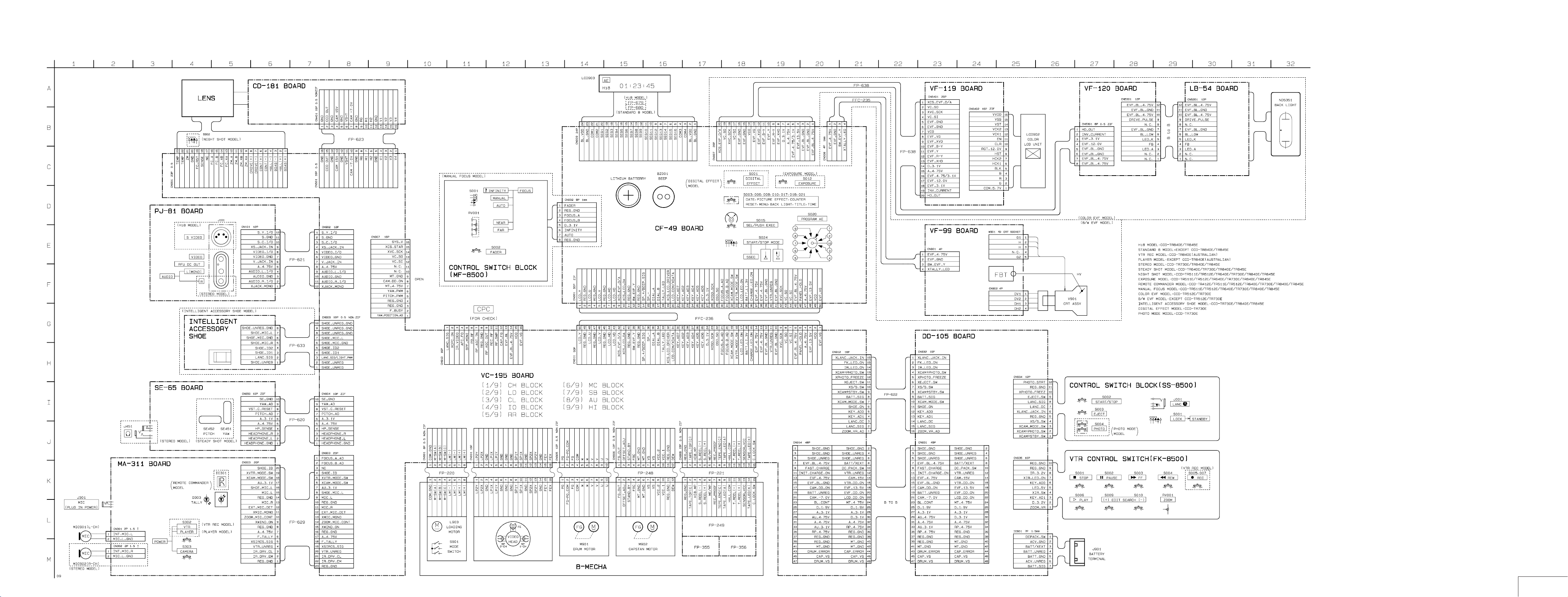
PRINTED WIRING BOARDS AND SCHEMATIC DIAGRAMS
4-1. FRAME SCHEMATIC DIAGRAM
SECTION 4
CCD-TR311/TR311E/TR411E/TR412E/TR511E/TR512E/
TR640E/TR730E/TR840E/TR845E
4-1 4-2
4-3
4-4
FRAME
Page 53

CCD-TR311/TR311E/TR411E/TR412E/TR511E/TR512E/
CD-181BOARD
CAMERA REC
H
7Vp-p
IC401
1 2
1
2
3
,
H
7Vp-p
IC401
3 4
H
1.3Vp-p
IC401
7
,
1234
A
B
09
CD-181 BOARD (SIDE B) CD-181 BOARD (SIDE A)
1-668-930-
12 22
1
2
3
VF-119
(COLOR EVF)
CD-181
(CCD IMAGER)
MA-311
(STEREO MIC)
CF-49
(CONTROL)
PJ-81
(AV IN/OUT)
DD-105
(POWER)
TR640E/TR730E/TR840E/TR845E
CCD-TR311/TR311E/TR411E/TR412E/TR511E/TR512E/
TR640E/TR730E/TR840E/TR845E
4-2. PRINTED WIRING BOARDS AND SCHEMA TIC DIAGRAMS
THIS NOTE IS COMMON FOR PRINTED WIRING BOARDS AND SCHEMATIC DIAGRAMS.
(In addition to this, the necessary note is printed in each block.)
• For printed wiring boards.
• b : Pattern from the side which enable seeing.
(The other layer's patterns are not indicated.)
• Circled numbers refer to waveforms.
• Through hole is omitted.
• There are few cases that the part printed on diagram isn’t
mounted in this model.
• Chip parts.
Transistor Diode
C
Q
BE
546
Q
132
564
Q
312
Q
312
54
21
Q
534
3
21
3213
21
• For schematic diagrams.
• All capacitors are in µF unless otherwise noted. pF: µµF.
50 V or less are not indicated except for electrolytics and tantalums.
• Chip resistor are 1/16W unless otherwise noted.
kΩ : 1000Ω, MΩ : 1000kΩ.
• Caution when replacing chip parts.
New parts must be attached after removal of chip.
Be careful not to heat the minus side of tantalum capacitor, because
it is damaged by the heat.
• Some chip part will be indicated as follows.
Example C541 L452
22U 10UH
TA A 2520
(
Â
Kinds of capacitor
Temperature
chracteristics
• Constants of resistors, capasitors, ICs and etc with XX indicate
tha they are not used. In such cases, the unused circuits may be
indicated.
• Parts with differ according to the model/destination. Refer to
the mount table for each function.
• All variable and adjustable resistors have characteristic curve B,
unless otherwise noted.
• Signal name
XEDIT n EDIT PB/XREC n PB/REC
• 2 : non flammable resistor.
• 1 : fusible resistor.
• H : panel designation.
• A : B+ Line
• B : B– Line
• J : IN/OUT direction of (+, –) B LINE.
• C : adjustment for repair.
• Circled numbers refer to waveforms.
The components identified by
mark !or dotted line with mark
! are critical for safety .
Replace only with part number
specified.
When indicating parts by reference number, please include the
board name.
Â
External dimensions (mm)
Les composants identifiés par
une marque ! sont critiques
pour la sécurité.
Ne les remplacer que par une
piéce portant le numéro spécifié.
• Measuring conditions voltage value and waveform.
• The object is color bar chart of pattern box.
• Voltages and dc between ground and measurement points.
Readings are taken with a digital multimeter (DC 10MΩ).
• Voltages variations may be noted due to normal production
tolerances.
1.Connection
Pattern box
Lens reference plane
surface Imaging surface
of CCD imager
(IC401 on CD-181 board)
2.Adjust the distance so that the output waveform of Fig. a and the
Fig. b can be obtain.
Yellow
B
Fig. a (Video output terminal output waveform)
A
Cyan
White
Green
Yellow
Fig. b (Picture on monitor TV)
1.5m
H
White
Cyan
Green
Magenta
A=B
Electron beam
scanned frame
Red
Blue
Magenta
Red
Blue
A
B
CRT picture frame
CD-181 (CCD IMAGER) PRINTED WIRING BOARD
– Ref No. CD-181 BOARD: 3,000 series –
CD-181 BOARD
C401 A-3
C403 B-3 C405 A-3 C406 A-3 C407 B-3
CN401 B-4 IC401 A-1 L401 B-1 Q402 B-3 R401 A-3
R404 B-3 R405 A-3
• For Printed Wiring Boards.
There are few cases that the part isn't mounted in this model is
printed on this diagram.
• Chip transistor
C
Q
BE
Note on the CCD imager replacement
• The CCD imager is not mounted for the already mounted
CD-181 board supplied as the repair parts.
When replacing the CD-181 board, remove the CCD imager
from the old board and install on the new board.
• Perform all adjustments of the camera block when the CCD
imager has been replaced.
• Handle the CCD imager with attention such as MOS IC as it
may be broken by static electricity in the structure.
Also, prevent the receiving light section from dust attached
and strong light.
4-5
CCD IMAGER
CD-181
4-6
4-7
4-8
Page 54
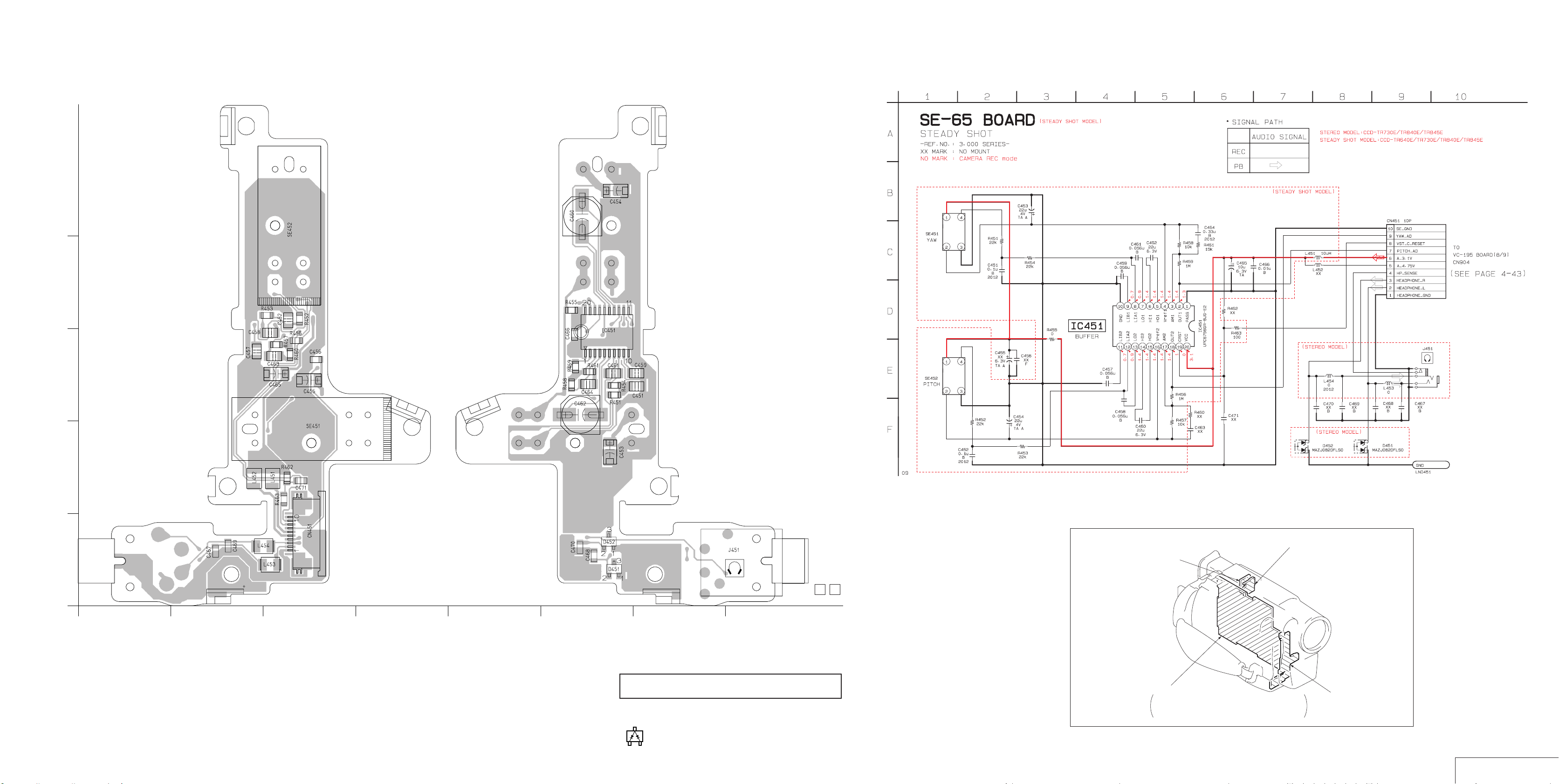
SE-65 (STEADY SHOT) PRINTED WIRING BOARD
VF-120
(COLOR EVF)
SE-65
(STEADY SHOT)
LB-54
(BACK LIGHT)
VC-195
CAMERA, Y/C PROCESSOR, IN/OUT,
REC/PB HEAD AMP, SERVO/SYSTEM CONTROL,
SERVO, AUDIO, MODE CONTROL
– Ref No. SE-65 BOARD: 3,000 series –
CCD-TR311/TR311E/TR411E/TR412E/TR511E/TR512E/
TR640E/TR730E/TR840E/TR845E
SE-65 BOARD (SIDE B) SE-65 BOARD (SIDE A)
E
D
C
SE-65 BOARD
C451 C-6
C452 D-3 C453 B-6 C454 E-6 C455 C-3 C456 C-3 C457 C-2 C458 C-3 C459 C-6 C460 E-6 C461 C-6 C462 C-6 C463 C-3 C464 C-6 C465 C-3 C466 C-6 C467 A-2 C468 A-6 C469 A-2 C470 A-6 C471 B-3
CN451 A-3 D451 A-6
D452 A-6 IC451 C-6 J451 A-8 L451 B-3
L452 B-2 L453 A-3 L454 A-2
R451 C-6 R452 D-3 R453 D-3 R454 C-6 R455 D-6 R456 C-3 R457 C-3 R458 C-6 R459 C-6 R460 C-3 R461 C-6 R462 B-3 R463 B-3
SE451 B-3 SE452 D-3
B
A
09
12345678
1-668-932-
12 22
• For Printed Wiring Boards.
There are few cases that the part isn't mounted in this model is
printed on this diagram.
• Chip diode
3
4-9
21
4-10
4-11
STEADY SHOT
SE-65
Page 55
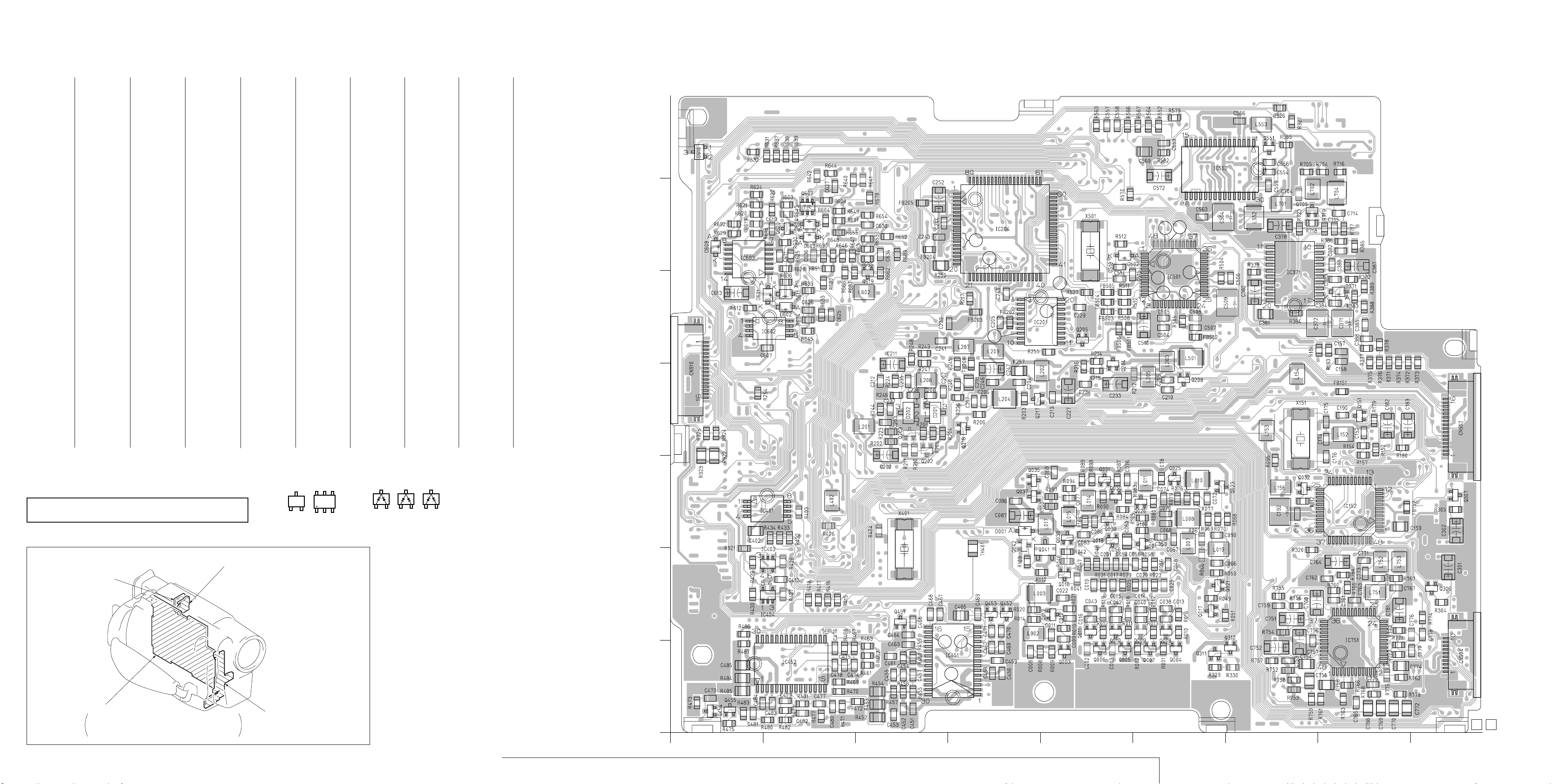
CCD-TR311/TR311E/TR411E/TR412E/TR511E/TR512E/
123456789
A
B
C
D
E
F
G
09
VC-195 BOARD (SIDE B)
1-668-928-
11 21
56
5758
28
29
25
26
27
1
2 3
4
5
6
TR640E/TR730E/TR840E/TR845E
CCD-TR311/TR311E/TR411E/TR412E/TR511E/TR512E/
TR640E/TR730E/TR840E/TR845E
VC-195 BOARD
(SIDE B)
C002 A-5 C003 A-5 C008 A-4 C009 B-5 C011 B-5 C012 B-5 C013 B-6 C014 B-6 C015 B-5 C016 B-5 C017 B-5 C019 B-5 C020 B-6 C022 B-5 C025 B-6 C038 B-6 C040 B-6 C042 B-5 C043 B-5 C048 B-6 C050 C-6 C051 B-5 C054 B-5 C056 B-5 C058 B-6 C060 C-5 C066 B-6 C067 C-6 C068 C-6 C069 C-5 C070 C-6 C072 C-6 C074 C-6 C076 C-5 C077 C-5 C080 C-5 C083 C-5 C086 C-4 C087 C-4 C090 C-6 C152 D-8 C157 E-8 C158 D-8 C159 C-8 C174 D-8 C175 D-8 C176 D-8 C182 D-8 C183 D-8 C190 D-8 C191 C-7 C192 C-7 C202 D-3 C203 D-3 C204 D-4 C205 E-4 C206 D-4 C207 D-3 C208 D-3 C209 D-6 C210 D-6 C211 D-3 C212 D-3
C213 D-5 C217 D-4 C218 D-4 C227 D-5 C229 E-5 C232 D-3 C233 D-5 C234 D-5 C235 D-3 C236 D-3 C239 E-4 C241 E-3 C243 F-3 C244 F-3 C245 D-4 C246 D-4 C247 D-4 C249 E-4 C252 F-3 C301 B-9 C312 C-9 C371 E-8 C372 E-8 C378 F-7 C380 E-7 C381 E-7 C382 F-8 C383 E-8 C384 E-8 C385 E-8 C387 F-8 C388 E-8 C402 C-1 C413 B-2 C451 A-3 C452 A-3 C453 A-3 C454 A-3 C455 A-3 C456 A-4 C457 A-3 C458 A-4 C459 A-4 C460 A-4 C461 A-3 C462 A-4 C463 A-3 C464 B-3 C465 B-4 C466 B-3 C467 B-3 C468 B-3 C469 B-4 C470 B-4 C471 B-4 C473 A-1 C474 A-2 C475 A-2 C476 A-2 C477 A-2 C478 A-2 C479 A-2 C480 A-2
C481 A-1 C482 A-2 C483 A-2 C484 A-2 C485 A-1 C504 E-6 C505 E-6 C506 E-7 C507 E-6 C508 E-6 C509 E-7 C510 E-6 C514 E-5 C515 E-5 C518 F-5 C553 G-6 C554 G-7 C556 G-7 C557 G-5 C558 G-5 C559 F-7 C563 F-6 C564 F-7 C566 G-7 C569 G-6 C572 F-6 C603 F-1 C607 E-2 C610 F-2 C611 F-2 C613 E-1 C625 E-2 C626 E-2 C627 F-2 C630 F-3 C634 F-3 C636 F-2 C704 F-7 C714 F-8 C715 F-8 C751 B-6 C752 A-7 C753 A-7 C754 A-7 C755 A-7 C756 A-7 C757 A-7 C758 A-8 C759 B-6 C760 B-6 C761 B-8 C762 B-8 C763 B-8 C764 B-8 C765 A-8 C766 A-8 C767 B-8 C768 B-8 C769 A-8 C770 A-8 C771 B-8 C772 A-8 C773 B-8
C774 A-8 C775 A-8 C776 B-8 C777 A-8 C778 B-9 C781 B-8
CN904 A-9 CN907 D-9 CN910 D-1
D001 C-4 D201 D-3 D202 D-3 D371 E-8 D502 F-5 D601 E-2 D602 E-2 D604 F-2 D608 F-1 D609 F-2 D611 E-2 D910 G-1
FB202 E-4 FB203 E-4 FB204 F-3 FB205 F-3 FB206 D-4 FB501 E-5 FB502 E-6 FB503 E-5 FB504 E-5 FB505 E-5 FB506 E-5
IC152 C-8 IC201 E-5 IC204 F-4 IC371 E-7 IC401 C-2 IC403 B-2 IC404 B-2 IC451 A-4 IC452 A-2 IC501 E-6 IC552 G-6 IC602 E-2 IC751 A-8
L002 B-4 L003 B-4 L007 C-6 L008 C-6 L010 C-6 L011 C-6 L014 C-5 L015 C-5 L017 C-5 L019 B-6 L152 D-8 L153 D-7 L154 D-7
L156 C-7 L201 D-3 L202 D-4 L203 D-6 L204 D-4 L205 D-6 L206 D-3 L207 E-4 L209 E-4 L402 C-2 L501 E-6 L552 F-7 L553 G-7 L602 E-3 L701 F-7 L702 F-7 L704 F-8 L751 B-8 L752 B-8 L753 B-8
Q003 A-5 Q004 A-6 Q005 A-5 Q006 A-5 Q007 A-6 Q008 B-6 Q009 B-6 Q010 B-5 Q011 B-5 Q012 B-5 Q016 B-5 Q017 B-6 Q018 C-5 Q019 C-6 Q021 B-6 Q023 C-6 Q025 C-6 Q026 C-6 Q030 C-5 Q031 C-5 Q032 C-7 Q035 C-4 Q037 C-4 Q038 C-5 Q039 C-5 Q041 B-5 Q042 C-4 Q151 D-8 Q202 D-3 Q203 D-3 Q204 D-5 Q205 E-5 Q208 D-6 Q217 D-4 Q218 D-4 Q306 B-9 Q307 C-9 Q311 A-6 Q312 A-7 Q451 B-3 Q452 B-4 Q453 B-4
Q454 A-1 Q455 A-1 Q551 G-7 Q607 F-2 Q619 E-3 Q620 F-2 Q705 F-7
R001 A-6 R002 A-6 R008 A-4 R009 A-5 R010 B-6 R011 B-5 R012 B-5 R013 B-6 R014 B-4 R015 B-5 R016 B-6 R017 B-6 R018 B-5 R019 B-5 R020 B-4 R021 B-5 R023 B-6 R025 B-6 R029 B-5 R031 B-5 R040 B-5 R041 B-5 R042 B-5 R047 B-5 R048 B-5 R049 B-6 R050 B-6 R051 B-6 R056 B-6 R058 B-6 R066 B-6 R067 C-6 R068 C-7 R069 C-5 R069 C-6 R070 C-6 R076 C-6 R077 C-6 R078 C-6 R079 C-6 R080 C-6 R083 C-5 R084 C-5 R087 C-5 R088 C-5 R090 C-5 R094 C-5 R095 C-7 R097 C-5 R100 C-5 R104 C-5 R105 C-6 R106 C-6 R109 B-4 R110 B-5
R112 C-7
R152 D-8
R154 D-8
R157 D-8
R179 D-8
R180 D-8
R183 E-8
R184 E-8
R202 D-3
R203 D-4
R204 D-3
R205 D-3
R206 D-4
R208 D-3
R210 D-3
R211 D-3
R212 D-6
R214 D-5
R215 D-5
R216 D-5
R217 E-4
R223 D-3
R224 D-3
R226 D-4
R240 D-4
R244 D-3
R246 D-3
R247 D-3
R248 E-3
R249 E-3
R250 F-3
R254 D-1
R255 E-5
R257 D-4
R304 B-9
R305 C-9
R329 A-6
R330 A-7
R371 D-8
R372 D-8
R373 D-9
R374 D-8
R375 D-8
R376 D-8
R377 E-8
R378 E-8
R379 E-7
R382 E-8
R383 E-8
R384 E-7
R385 F-8
R386 F-8
R386 F-8
R388 E-8
R389 E-8
R403 C-2
R404 C-3
R415 B-2
R416 B-2
R417 B-2
R418 B-2
R426 C-2
R427 B-2
R428 B-2 R429 B-1 R430 B-1 R432 C-2 R433 C-2 R434 C-2 R452 A-3 R453 A-3 R454 A-3 R455 A-3 R456 A-3 R457 A-3 R459 A-3 R460 A-3 R461 A-3 R462 A-3 R463 A-3 R467 A-2 R468 A-2 R469 A-2 R470 A-2 R471 A-2 R472 A-3 R473 A-1 R475 A-1 R477 A-2 R479 A-2 R480 A-2 R481 A-2 R482 A-2 R483 A-1 R484 A-1 R485 A-1 R486 B-1 R487 A-1 R504 E-6 R505 E-6 R508 E-5 R510 E-5 R511 E-5 R512 F-5 R527 E-5 R552 G-6 R555 G-7 R563 G-5 R564 G-6 R566 G-5 R567 G-6 R570 F-5 R579 G-6 R582 G-6 R603 F-2 R604 F-2 R608 F-2 R612 E-1 R618 F-1 R619 F-1 R620 F-1 R621 F-1 R622 F-2 R624 F-1 R625 F-2 R627 E-2
R628 E-2 R629 F-1 R630 F-2 R631 G-2 R632 G-1 R633 E-2 R634 E-2 R635 E-2 R636 E-2 R637 G-2 R638 G-2 R639 G-2 R640 F-2 R641 F-3 R642 F-2 R643 F-2 R644 F-2 R645 E-2 R646 F-2 R647 F-2 R648 F-2 R649 F-2 R651 F-2 R652 F-3 R653 F-3 R654 F-3 R655 F-2 R662 E-3 R663 F-3 R665 F-3 R678 F-3 R686 E-2 R687 E-2 R689 F-3 R690 F-2 R691 E-2 R692 F-1 R704 G-8 R705 G-7 R716 G-8 R717 F-8 R718 F-7 R719 F-8 R723 F-7 R752 A-7 R753 A-7 R754 B-6 R755 B-6 R757 A-7 R758 A-7 R759 A-7 R760 B-8 R761 A-8 R762 A-8 R763 A-8 R764 B-8 R765 B-8 R766 A-8 R767 B-8 R768 A-8 R770 A-8 R771 A-8 R772 A-8
R773 B-8 R774 B-9 R775 A-8 R921 B-1 R922 D-1 R923 D-1 R924 D-1 R925 D-1 R926 G-7 R927 G-7
RB12 C-8
RB151 D-8
TH401 B-4 X151 D-7
X401 B-3 X501 F-5
VC-195 (CAMERA, Y/C PROCESSOR, IN/OUT, REC/PB HEAD AMP, SERVO/SYSTEM CONTROL, SERVO, AUDIO, MODE CONTROL) PRINTED WIRING BOARD
– Ref No. VC-195 BOARD: 1,000 series –
• For Printed Wiring Boards.
• This board is four-layer print board. However, the patterns of
layers 2 to 3 have not been included in the diagram.
There are few cases that the part isn't mounted in this model is
printed on this diagram.
LB-54
(BACK LIGHT)
VC-195
CAMERA, Y/C PROCESSOR, IN/OUT,
REC/PB HEAD AMP, SERVO/SYSTEM CONTROL,
SERVO, AUDIO, MODE CONTROL
VF-120
(COLOR EVF)
SE-65
(STEADY SHOT)
4-12
• Chip transistor • Chip diode
C
Q
BE
546
Q
132
3
21321321
CAMERA, Y/C PROCESSOR, IN/OUT, REC/PB HEAD AMP, SERVO/SYSTEM CONTROL, SERVO, AUDIO, MODE CONTROL
VC-195 (SIDE B)
4-144-13
Page 56
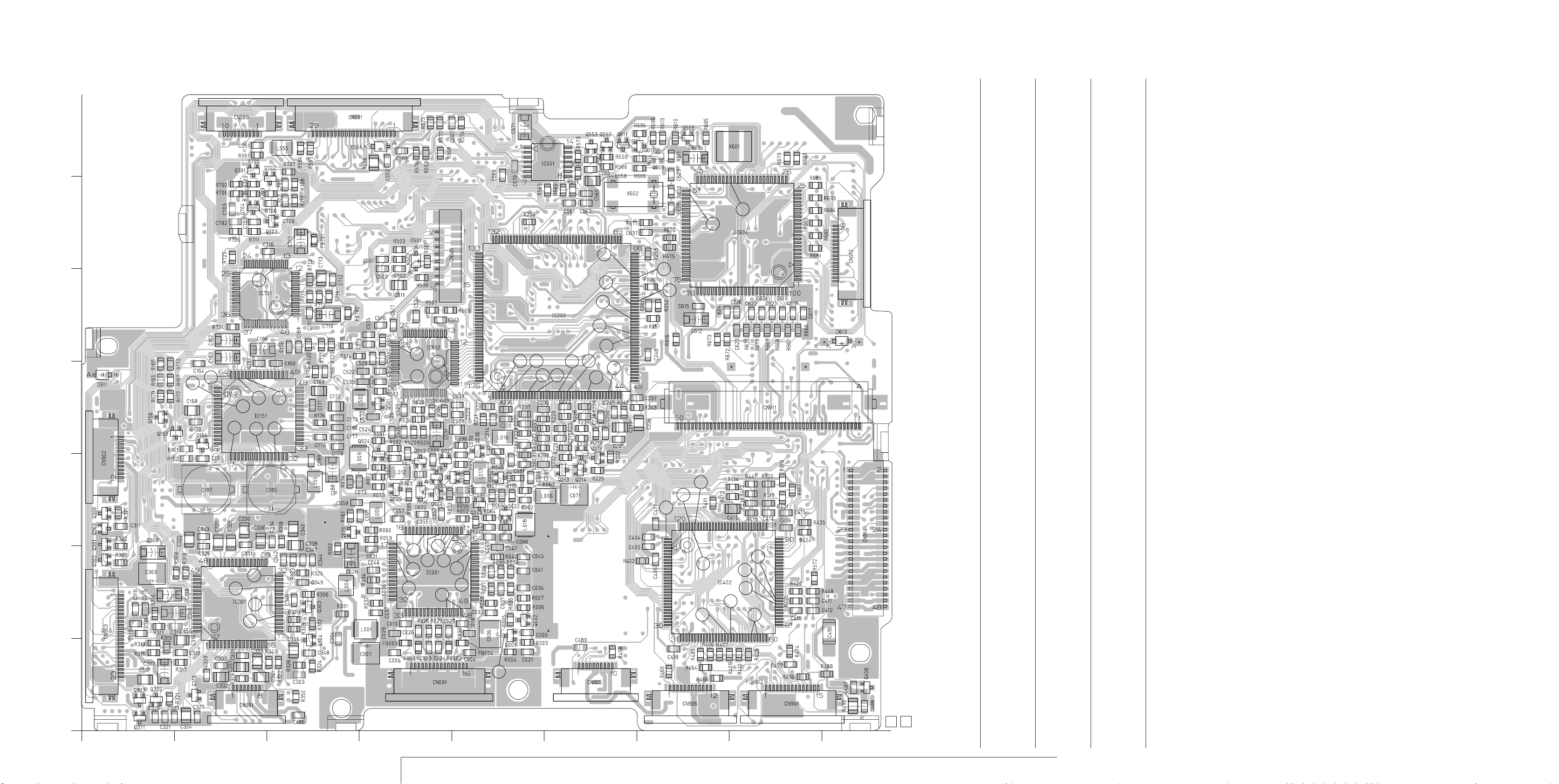
VC-195 BOARD (SIDE A)
G
F
E
32
30
D
C
B
A
09
10 11 12 13 14 15 16 17 18
32
61
31
59
62
60
33
44
34
CCD-TR311/TR311E/TR411E/TR412E/TR511E/TR512E/
TR640E/TR730E/TR840E/TR845E
68
69
24
23
21
20
19
18
8
7
9
10 11
12 13
14
15
17
16
33
34
36
38
37
35
39
40
43
42
41
45
4-15 4-16
CAMERA, Y/C PROCESSOR, IN/OUT, REC/PB HEAD AMP, SERVO/SYSTEM CONTROL, SERVO, AUDIO, MODE CONTROL
46
22
53
55
47
54
48
VC-195 (SIDE A)
52
51
50
49
1-668-928-
11 21
VC-195 BOARD
(SIDE A)
C001 A-13 C004 A-14 C004 B-13 C005 B-14 C006 B-14 C007 A-13 C010 B-13 C018 B-14 C021 A-14 C023 A-13 C024 A-13 C026 B-13 C027 B-13 C028 B-12 C029 B-13 C030 B-14 C031 B-13 C032 B-13 C033 B-14 C034 B-14 C035 C-14 C036 B-13 C037 B-14 C039 B-14 C041 B-14 C045 B-14 C046 C-14 C047 B-14 C049 C-14 C052 C-13 C053 C-14 C055 C-13 C057 C-13 C059 C-12 C061 C-13 C062 C-14 C065 C-14 C071 C-15 C073 C-13 C075 C-13 C078 C-14 C079 C-13 C081 C-14 C082 C-14 C084 D-14 C085 C-14 C088 C-14 C089 C-13 C156 E-12 C160 D-12 C161 E-12 C162 E-11 C163 E-11 C164 D-11 C166 D-12 C168 D-11 C169 D-12 C170 D-11 C171 D-12 C172 D-12 C173 D-12 C177 D-12 C178 D-12 C179 D-12 C180 D-12 C181 C-11 C184 D-11 C185 C-12 C186 E-11 C187 C-11 C188 C-12 C189 C-12 C201 E-16 C214 D-14 C215 D-15 C219 D-15 C220 D-14 C221 D-14 C222 D-14 C223 D-15 C224 D-15 C225 D-15 C226 D-16 C228 D-15 C230 D-14 C237 D-16 C245 D-15 C248 E-16 C250 D-15 C303 A-12 C304 A-12 C306 B-10 C307 A10 C308 B-10 C309 B-10 C310 B-10 C311 C-10 C312 A10 C313 B-10 C314 A-11 C315 B-10 C316 B-10 C317 A-11 C318 B-10 C319 B-11 C320 A10 C321 A10 C322 C-11 C323 A-11 C324 A-11 C324 A-12 C325 C-11 C326 C-11 C327 A-11
C328 C-11 C330 C-11 C331 C-11 C332 A-11 C333 A-11 C334 C-12 C335 A-11 C336 C-11 C337 A-11 C338 B-12 C339 A-11 C340 C-12 C341 A-11 C342 B-12 C343 C-11 C344 B-12 C345 A-12 C346 B-12 C347 B-12 C348 A-12 C349 B-12 C404 C-16 C405 B-16 C406 B-16 C410 C-17 C411 B-17 C412 B-17 C414 C-17 C415 C-17 C416 C-17 C417 C-16 C418 A-16 C419 B-17 C420 C-17 C472 A-17 C486 A-12 C487 A-18 C488 A-18 C489 A-15 C490 B-18 C501 F-13 C502 E-13 C503 E-13 C511 E-13 C512 D-13 C513 E-13 C516 E-13 C517 E-13 C519 E-13 C520 E-13 C521 E-13 C522 D-13 C523 D-13 C524 D-13 C525 D-13 C526 D-13 C527 D-13 C528 D-14 C529 D-14 C530 D-14 C531 D-13 C532 D-13 C533 D-13 C534 E-13 C535 E-13 C551 G-11 C552 G-13 C555 G-15 C560 F-14 C561 F-15 C562 F-15 C565 F-15 C567 G-14 C568 G-13 C570 G-14 C571 G-14 C604 F-17 C605 G-16 C612 E-16 C615 E-16 C616 E-17 C617 E-17 C618 E-17 C619 E-17 C620 E-17 C621 E-17 C622 E-17 C623 E-17 C624 E-16 C628 F-16 C629 F-16 C637 F-16 C702 F-11 C703 F-11 C705 F-12 C706 F-12 C707 F-12 C708 F-12 C709 F-11 C710 E-12 C711 E-12 C712 E-12 C713 E-12 C716 F-12 C717 F-12
CN001 A-13 CN501 F-14 CN551 G-12 CN901 A-11 CN902 C-10 CN903 B-10 CN905 A-15 CN906 A-16
CN908 A-17 CN909 G-11 CN911 D-17 CN912 F-18 CN914 B-18
D002 C-13 D501 F-13 D551 G-13 D610 E-18 D911 D-10
FB001 A-13 FB002 A-13 FB003 A-13 FB004 A-14 FB201 E-16 FB701 F-12 FB702 E-12
IC001 B-13 IC151 D-11 IC202 E-15 IC301 B-11 IC402 B-16 IC502 D-13 IC551 G-15 IC701 E-11
L001 B-13 L004 B-12 L005 C-13 L006 C-15 L009 C-13 L012 C-13 L013 C-14 L016 D-14 L018 C-14 L155 C-12 L502 D-13 L555 G-12
Q001 B-14 Q002 B-14 Q020 C-12 Q022 C-14 Q024 C-13 Q027 C-13 Q028 C-13 Q029 C-13 Q033 C-14 Q034 C-14 Q036 D-14 Q040 C-14 Q043 C-13 Q044 C-13 Q153 D-11 Q154 D-11 Q156 D-10 Q213 C-15 Q214 C-15 Q215 C-15 Q216 C-15 Q301 C-10 Q302 B-10 Q303 B-12 Q304 A-12 Q305 A10 Q308 C-10 Q309 C-10 Q310 A-11 Q329 A-11 Q371 A10 Q372 A10 Q456 A-18 Q501 D-13 Q553 G-15 Q608 G-16 Q609 G-16 Q610 G-16 Q611 G-15 Q701 G-11 Q702 F-12 Q703 F-12 Q704 F-11
R003 A-14 R004 A-14 R005 B-14 R006 B-14 R007 B-14 R026 B-13 R027 B-13 R032 B-13 R033 B-14 R034 B-13 R035 B-14 R037 B-14 R038 B-14 R039 B-14 R043 C-13 R045 B-14 R046 C-14 R052 C-14 R055 C-14 R057 C-14 R059 C-13 R060 C-13 R062 B-12 R063 C-14 R064 C-14 R065 C-14 R072 C-13 R073 C-13
R074 C-12 R075 C-13 R081 D-13 R082 D-13 R085 C-13 R092 C-14 R093 C-13 R096 C-14 R098 D-14 R099 C-14 R101 D-14 R102 C-14 R103 C-14 R107 C-14 R113 C-14 R161 D-11 R162 C-11 R165 D-10 R166 D-10 R167 D-10 R170 D-10 R175 D-12 R176 D-12 R177 D-10 R178 D-10 R218 D-14 R219 D-15 R220 D-15 R222 C-15 R225 C-15 R227 D-14 R228 D-14 R229 D-14 R230 D-15 R231 D-15 R232 C-15 R233 D-14 R234 D-15 R236 D-14 R237 D-14 R238 D-15 R239 D-15 R241 D-14 R242 D-15 R243 D-16 R251 E-16 R252 E-16 R253 F-16 R256 F-14 R302 C-10 R303 B-10 R306 B-12 R308 B-11 R309 B-12 R310 B-11 R311 B-10 R312 B-12 R313 A10 R314 B-10 R315 A10 R316 A10 R317 A-11 R318 C-12 R319 A-11 R321 A10 R322 A-12 R323 B-12 R325 B-12 R326 A-12 R327 C-1 R328 B-12 R331 B-12 R343 A-12 R350 A-12 R402 B-16 R405 A-16 R406 A-16 R407 A-16 R409 A-16 R410 A-17 R411 C-16 R412 C-17 R413 C-17 R414 C-17 R419 C-17 R420 B-17 R421 B-17 R424 C-17 R425 A-17 R431 C-17 R435 C-17 R440 B-17 R441 C-17 R458 A-15 R464 A-16 R465 A-16 R466 A-16 R474 A-17 R476 A-17 R488 A-18 R490 A-18 R501 F-13 R502 F-13 R503 F-13 R507 E-13 R509 E-13 R513 D-13 R514 E-13 R521 D-13 R522 D-13 R523 D-13 R524 D-13 R525 D-13 R526 D-13
R527 B-17
R529 E-12
R551 G-11
R552 G-15
R553 G-13
R554 G-12
R556 G-13
R557 G-12
R558 F-15
R559 G-15
R560 G-15
R561 G-15
R562 G-15
R565 F-15
R568 G-13
R569 F-15
R571 F-15
R573 G-15
R574 G-14
R575 G-13
R576 G-13
R577 G-13
R605 G-16
R606 G-16
R610 G-16
R611 G-16
R613 G-16
R614 G-16
R650 F-16
R666 E-17
R667 E-17
R668 E-17
R669 E-17
R670 E-17
R671 E-17
R672 E-16
R673 E-16
R675 F-16
R676 F-16
R679 G-17
R680 G-17
R681 F-17
R682 F-17
R683 F-17
R684 F-17
R685 F-17
R693 F-17
R695 G-16
R696 G-16
R701 F-11
R702 F-11
R703 F-11
R706 F-11
R707 G-12
R708 F-12
R709 F-12
R710 F-12
R711 F-11
R712 E-12
R713 E-12
R714 E-12
R715 E-12
R720 E-12
R721 E-12
R722 E-12
R724 E-11
R725 F-11
R726 F-11
R916 E-16
R917 C-17
R918 C-17
R919 C-17
R920 C-17
X601 G-17 X602 F-15
CCD-TR311/TR311E/TR411E/TR412E/TR511E/TR512E/
TR640E/TR730E/TR840E/TR845E
4-17
Page 57

CCD-TR311/TR311E/TR411E/TR412E/TR511E/TR512E/
TR640E/TR730E/TR840E/TR845E
VC-195 BOARD (1/9)
CAMERA REC
1
: 28.636 MHz
NTSC
: 28.375 MHz
PAL
2
3
IC501
CAMERA REC
IC501
CAMERA REC
NTSC
PAL
IC501
5
: 14.32 MHz
: 14.18 MHz
11 12
,
H
26,
25
CCD-TR311/TR311E/TR411E/TR412E/TR511E/TR512E/
TR640E/TR730E/TR840E/TR845E
• For schematic diagrams.
• Refer to page 4–13 for Printed Wiring Board.
2.3Vp-p
2.3Vp-p
7Vp-p
4
5
6
7
0.14usec
8
CAMERA REC
H
IC501
CAMERA REC
H
IC501
CAMERA REC
V
IC501
45
CAMERA REC
IC502
CAMERA REC
31,
28
44
—
2 10
7Vp-p
3Vp-p
3Vp-p
3.2Vp-p
1.3Vp-p
H
IC502
26
9
4-18 4-19 4-20
PB
IC502
0.4Vp-p
H
36
CAMERA (1)
VC-195 (1/9)
Page 58

• For schematic diagrams.
• Refer to page 4–13 for Printed Wiring Board.
CCD-TR311/TR311E/TR411E/TR412E/TR511E/TR512E/
TR640E/TR730E/TR840E/TR845E
CCD-TR311/TR311E/TR411E/TR412E/TR511E/TR512E/
TR640E/TR730E/TR840E/TR845E
4-21 4-22
CAMERA (2)
VC-195 (2/9)
4-23
4-24
Page 59

CCD-TR311/TR311E/TR411E/TR412E/TR511E/TR512E/
TR640E/TR730E/TR840E/TR845E
VC-195 BOARD (3/9)
10
CAMERA REC
20
CAMERA REC
• For schematic diagrams.
• Refer to page 4–13 for Printed Wiring Board.
11
12
13
14
H
IC202
CAMERA REC
H
IC202
CAMERA REC
H
IC202
CAMERA REC
H
IC202
CAMERA REC
H
IC202
0.34Vp-p
NTSC:3.58 MHz
3
21
0.84Vp-p
6
22
0.5Vp-p
13
23
0.4Vp-p
16
24
0.18Vp-p
23
PAL:4.43 MHz
IC202 66
CAMERA REC
4V
IC202
CAMERA REC
2V
IC202
PB
H
IC202
CAMERA REC
V
IC202
3.1Vp-p
3Vp-p
71
3Vp-p
72
3Vp-p
80
3Vp-p
81
15
16
17
18
19
CAMERA REC
H
IC202
CAMERA REC
H
IC202
PB
V
IC202
CAMERA REC
V
IC202
CAMERA REC
25
CAMERA REC
8
19
20
—
12 15
3.2Vp-p
3Vp-p
3Vp-p
3.5Vp-p
0.18Vp-p
7.16 MHz
26
26
0.9Vp-p
33
27
0.4Vp-p
40
28
3Vp-p
60
29
IC201
CAMERA REC
V
IC201
CAMERA REC
IC201
CAMERA REC
0.14usec
IC204
CAMERA REC
H
H
IC202
61
Y/C PROCESSOR
VC-195 (3/9)
3Vp-p
0.14usec
IC204
—
23 30
3.5Vp-p
4-25
4-26 4-27
4-28
Page 60

• For schematic diagrams.
• Refer to page 4–13 for Printed Wiring Board.
CCD-TR311/TR311E/TR411E/TR412E/TR511E/TR512E/
TR640E/TR730E/TR840E/TR845E
VC-195 BOARD (4/9)
CAMERA REC
30
H
IC151
3
31
H
IC151
5
32
H
IC151
,
17 64
CCD-TR311/TR311E/TR411E/TR412E/TR511E/TR512E/
TR640E/TR730E/TR840E/TR845E
0.46Vp-p
0.32Vp-p
1.4Vp-p
33
34
H
IC151
H
IC151 29
IC151 62
,
25 60
(
(
2.1Vp-p
1.6Vp-p
1.8Vp-p
)
)
4-29 4-30
4-31 4-32
IN/OUT
VC-195 (4/9)
Page 61

CCD-TR311/TR311E/TR411E/TR412E/TR511E/TR512E/
TR640E/TR730E/TR840E/TR845E
• For schematic diagrams.
VC-195 BOARD (5/9)
35
CAMERA REC
45
CAMERA REC
• Refer to page 4–13 for Printed Wiring Board.
36
37
38
39
H
IC001
CAMERA REC
2V
IC001
5 21
TRIG : IC001
PB
H
IC001
PB
V
IC001
PB
V
IC001
0.3Vp-p
4.12 MHz
3
0.3Vp-p
0.4Vp-p
7
0.4Vp-p
11
0.4Vp-p
17
Q001
7Vp-p
C
40
41
42
43
44
CAMERA REC
2V
IC001
CAMERA REC
2V
IC001
CAMERA REC
V
IC001
CAMERA REC
V
IC001
CAMERA REC
21
,
44 48
61
62
2.9Vp-p
3Vp-p
0.18Vp-p
3Vp-p
H
IC701
16
REC/PB HEAD AMP
VC-195 (5/9)
3Vp-p
4-33
4-34 4-35 4-36
Page 62
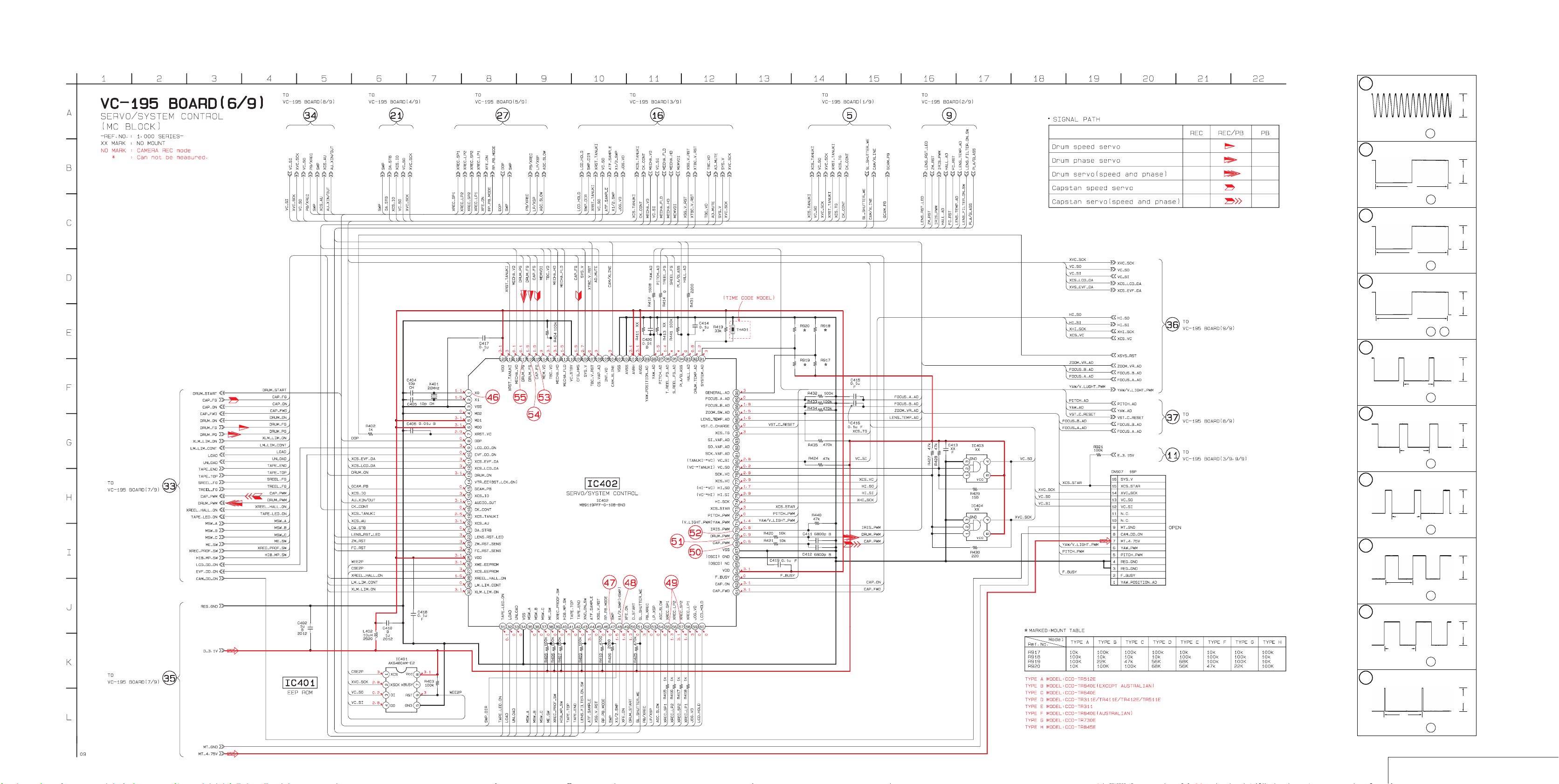
• For schematic diagrams.
VC-195 BOARD (6/9)
CAMERA REC
2V
3Vp-p
IC402
47
4V
3Vp-p
IC402
48
2V
3Vp-p
IC402
55 57
3Vp-p
IC402
68
13usec
3Vp-p
IC402
69
13usec
3Vp-p
IC402
70
46
47
48
49
50
51
52
53
54
55
IC402
1
20 MHz
1.7Vp-p
1.2msec
3Vp-p
IC402
115
2.8msec
3Vp-p
IC402
116
2V
3Vp-p
IC402
117
,
13usec
• Refer to page 4–13 for Printed Wiring Board.
CCD-TR311/TR311E/TR411E/TR412E/TR511E/TR512E/
TR640E/TR730E/TR840E/TR845E
4-37
4-38
4-39
SERVO/SYSTEM CONTROL
VC-195 (6/9)
Page 63

CCD-TR311/TR311E/TR411E/TR412E/TR511E/TR512E/
TR640E/TR730E/TR840E/TR845E
• For schematic diagrams. • Refer to page 4–13 for Printed Wiring Board.
SERVO
VC-195 (7/9)
4-40
4-41 4-42
Page 64

VC-195 BOARD (7/9)
VC-195 BOARD (8/9)
59
60
61
62
2V
2.9Vp-p
IC301
21
CAMERA REC
V
0.4Vp-p
IC301
24
PB
V
0.36Vp-p
IC301
29
CAMERA REC
CAMERA REC
IC301
32
NTSC:3.58 MHz
PAL:4.43 MHz
0.26Vp-p
CAMERA REC
56
5.6msec
IC451 1 2 29
,,
57
2V
IC451
11
58
2.8msec
IC451
18
CCD-TR311/TR311E/TR411E/TR412E/TR511E/TR512E/
TR640E/TR730E/TR840E/TR845E
• For schematic diagrams.
• Refer to page 4–13 for Printed Wiring Board.
1.2Vp-p
3Vp-p
3Vp-p
4-43 4-44
4-45
4-46
AUDIO
VC-195 (8/9)
Page 65
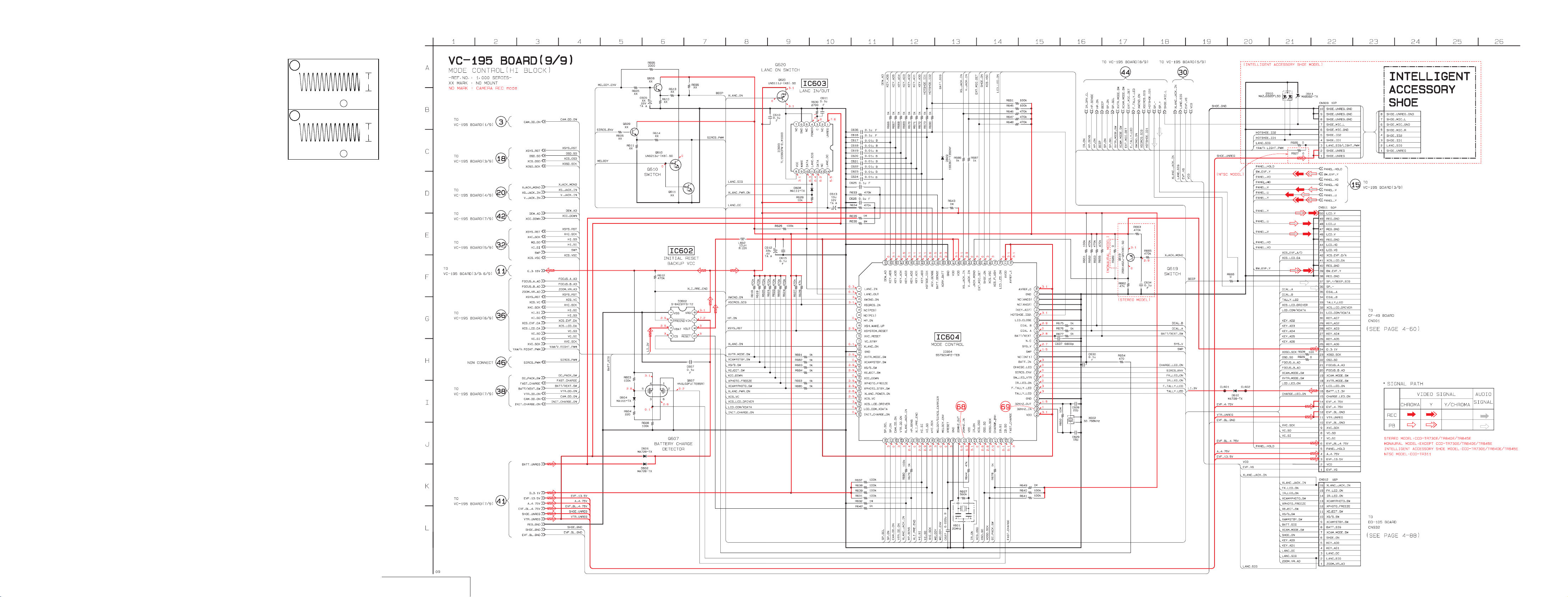
CCD-TR311/TR311E/TR411E/TR412E/TR511E/TR512E/
TR640E/TR730E/TR840E/TR845E
CCD-TR311/TR311E/TR411E/TR412E/TR511E/TR512E/
TR640E/TR730E/TR840E/TR845E
• For schematic diagrams. • Refer to page 4–13 for Printed Wiring Board.
VC-195 BOARD (9/9)
68
1.5Vp-p
20 MHz
IC604 41
69
2.6Vp-p
32 kHz
IC604 52
4-47
MODE CONTROL
VC-195 (9/9)
4-48 4-49
4-50
Page 66

PJ-81 (A V IN/OUT) PRINTED WIRING BOARD
(
)
– Ref No. PJ-81 BOARD: 3,000 series –
CCD-TR311/TR311E/TR411E/TR412E/TR511E/TR512E/
TR640E/TR730E/TR840E/TR845E
PJ-81 BOARD (SIDE B)
C
PJ-81 BOARD (SIDE A)
B
PJ-81 BOARD
C101 C-4
C102 C-4 C103 C-3 C104 C-3 C105 C-1 C106 C-2 C107 C-1 C108 C-1 C109 C-5 C110 C-5 C111 C-1
CN101 C-2 D101 C-1
D102 C-3 D103 C-4 D105 C-5 D106 C-5 D107 C-5
J101 A-3
L101 C-3
L102 C-3 L103 C-2 L104 C-2
Q101 C-5 Q102 C-4
R101 C-4 R102 C-4 R103 C-4 R104 C-4 R105 C-4 R106 C-5 R107 C-5 R108 C-5 R109 C-3
A
09
1234 5
VF-119
(COLOR EVF)
DD-105
(POWER)
CD-181
(CCD IMAGER)
CF-49
(CONTROL)
MA-311
(STEREO MIC)
1-668-931-
12 22
• For Printed Wiring Boards.
There are few cases that the part isn't mounted in this model is
printed on this diagram.
• Chip diode
3
21321321
PJ-81
AV IN/OUT
4-51
4-52
4-53
AV IN/OUT
PJ-81
Page 67
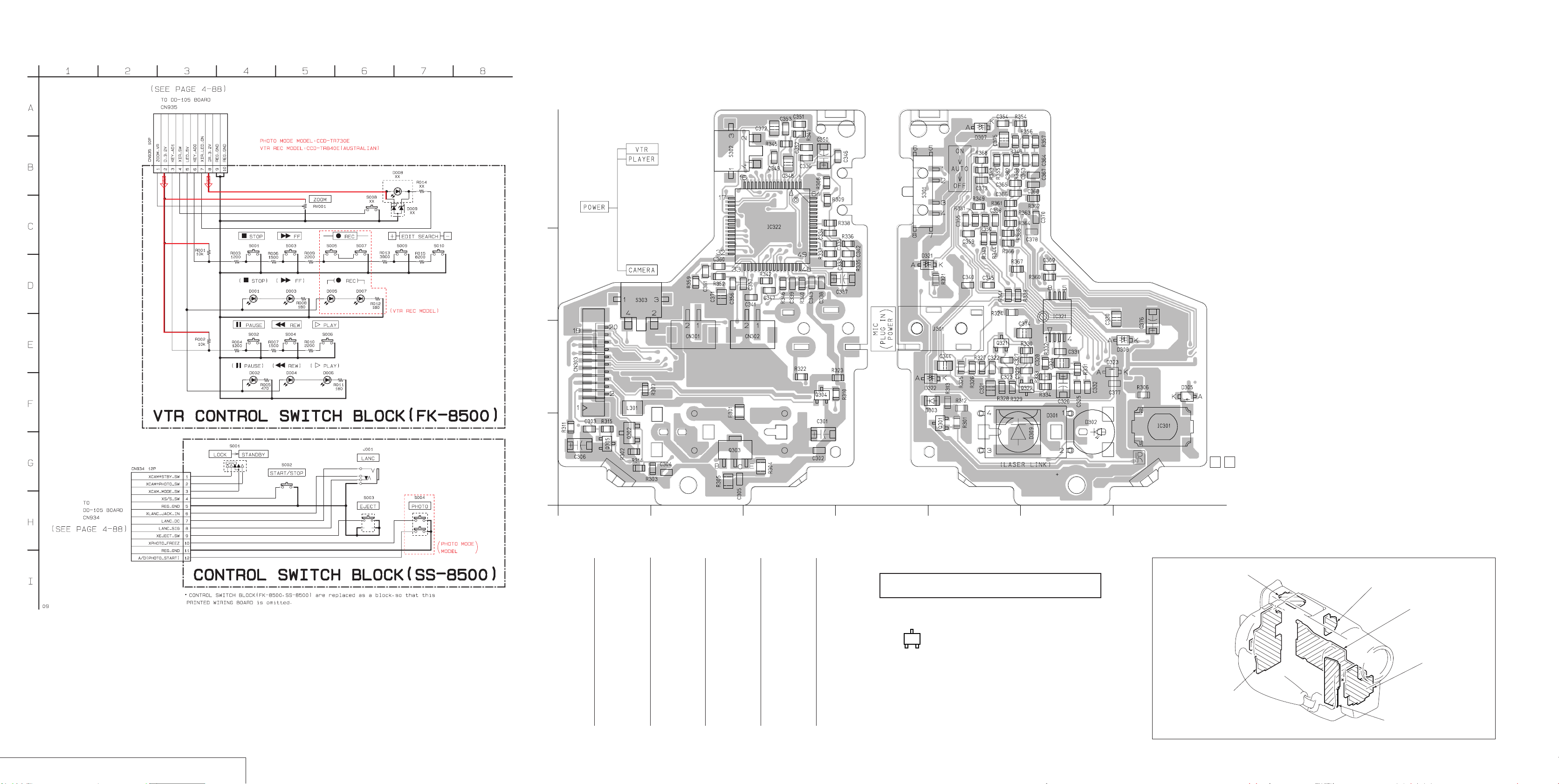
CCD-TR311/TR311E/TR411E/TR412E/TR511E/TR512E/
VF-119
(COLOR EVF)
CD-181
(CCD IMAGER)
MA-311
(STEREO MIC)
CF-49
(CONTROL)
PJ-81
(AV IN/OUT)
DD-105
(POWER)
TR640E/TR730E/TR840E/TR845E
MA-311 (STEREO MIC) PRINTED WIRING BOARDS
– Ref No. MA-311 BOARD: 3,000 series –
MA-311 BOARD (SIDE B) MA-311 BOARD (SIDE A)
D
C
B
A
09
MA-311 BOARD
C301 A-3
C302 A-3 C303 A-1 C304 A-2 C305 A-2 C306 A-1 C321 B-5 C322 B-5 C323 B-5 C324 B-6 C325 B-6 C326 B-6 C327 B-5 C328 B-6 C329 B-6 C330 C-7 C331 B-6 C332 B-6 C333 C-3 C334 C-3 C335 C-3 C336 D-3 C337 C-4 C338 C-3 C339 C-3 C340 C-5 C341 C-3 C342 C-4 C343 C-3
1234567
C344 B-5 C345 C-5 C346 D-4 C347 C-3 C348 D-3 C349 D-3 C350 D-3 C351 D-3 C352 D-3 C353 D-3 C354 D-5 C355 D-5 C356 C-2 C357 C-2 C358 D-5 C359 C-5 C360 C-2 C361 C-2 C362 D-5 C363 D-6 C364 D-6 C365 D-5 C366 D-5 C367 D-6 C368 D-6 C369 C-6 C370 D-6 C371 C-2 C372 D-3
C373 D-5 C374 B-6 C375 D-5 C376 B-7 C377 B-6 C378 C-6
CN301 B-2 CN302 B-3 CN303 B-1
D301 A-6 D302 A-6 D303 B-5 D305 B-7 D307 D-5 D308 B-7 D309 A-5 D322 B-5 D323 B-6
IC301 A-7 IC321 C-6 IC322 D-3
J310 B-5
L301 B-1
Q301 A-5 Q302 A-1 Q303 A-2 Q304 B-3 Q305 A-1 Q321 B-5 Q322 B-6
R301 A-5 R302 A-1 R303 A-2 R304 A-3 R305 A-2 R306 B-7 R307 B-1 R308 D-3 R309 D-3 R310 B-3 R311 A-1 R312 B-5 R313 B-5 R314 A-1 R315 A-1 R321 C-5 R322 B-3 R323 A-4 R324 C-5 R325 B-5 R326 B-5
R327 B-5 R328 B-5 R329 B-5 R330 B-6 R331 B-6 R332 B-6 R333 B-6 R334 B-6 R335 C-4 R336 C-4 R337 C-3 R338 D-3 R339 C-5 R340 C-3 R341 C-5 R342 C-3 R343 C-5 R344 C-5 R345 D-3 R346 C-3 R347 D-3 R348 D-5 R349 D-5 R350 D-5 R351 D-5 R352 C-2 R353 D-5 R354 D-5 R355 D-5
R356 D-6 R357 D-6 R358 D-5 R359 C-2 R360 C-6 R361 D-5 R362 D-6 R363 D-5 R364 D-5 R365 C-5 R366 C-5 R367 C-5 R368 D-5
S301 D-4 S302 D-2 S303 C-1
• For Printed Wiring Boards.
There are few cases that the part isn't mounted in this model is
printed on this diagram.
• Chip transistor
C
Q
BE
1-668-934-
12 22
CONTROL SWITCH BLOCK, STEREO MIC
FK-8500, SS-8500
MA-311
4-54
4-55 4-56
Page 68
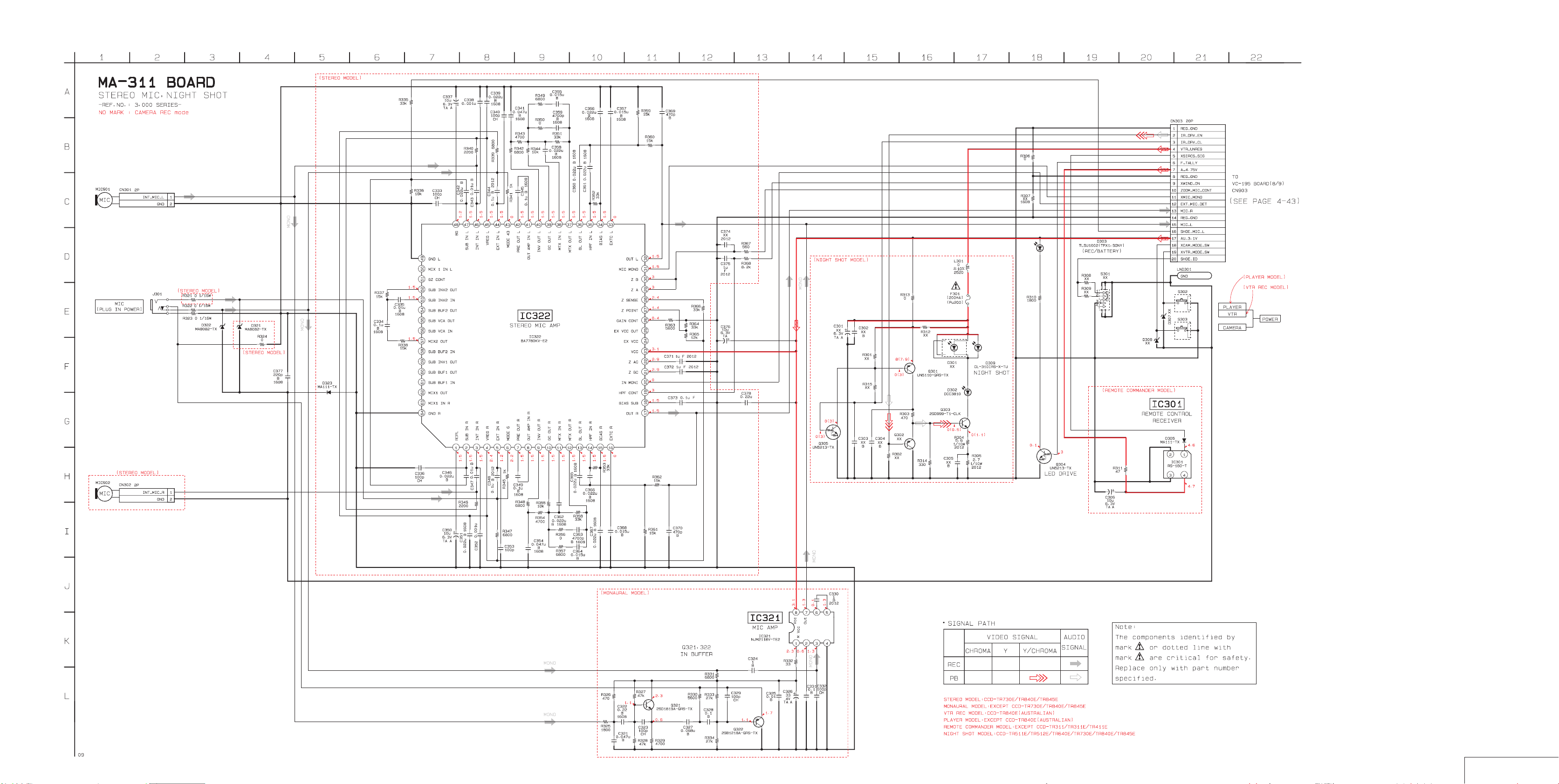
CCD-TR311/TR311E/TR411E/TR412E/TR511E/TR512E/
TR640E/TR730E/TR840E/TR845E
4-57
4-58
4-59
STEREO MIC
MA-311
Page 69
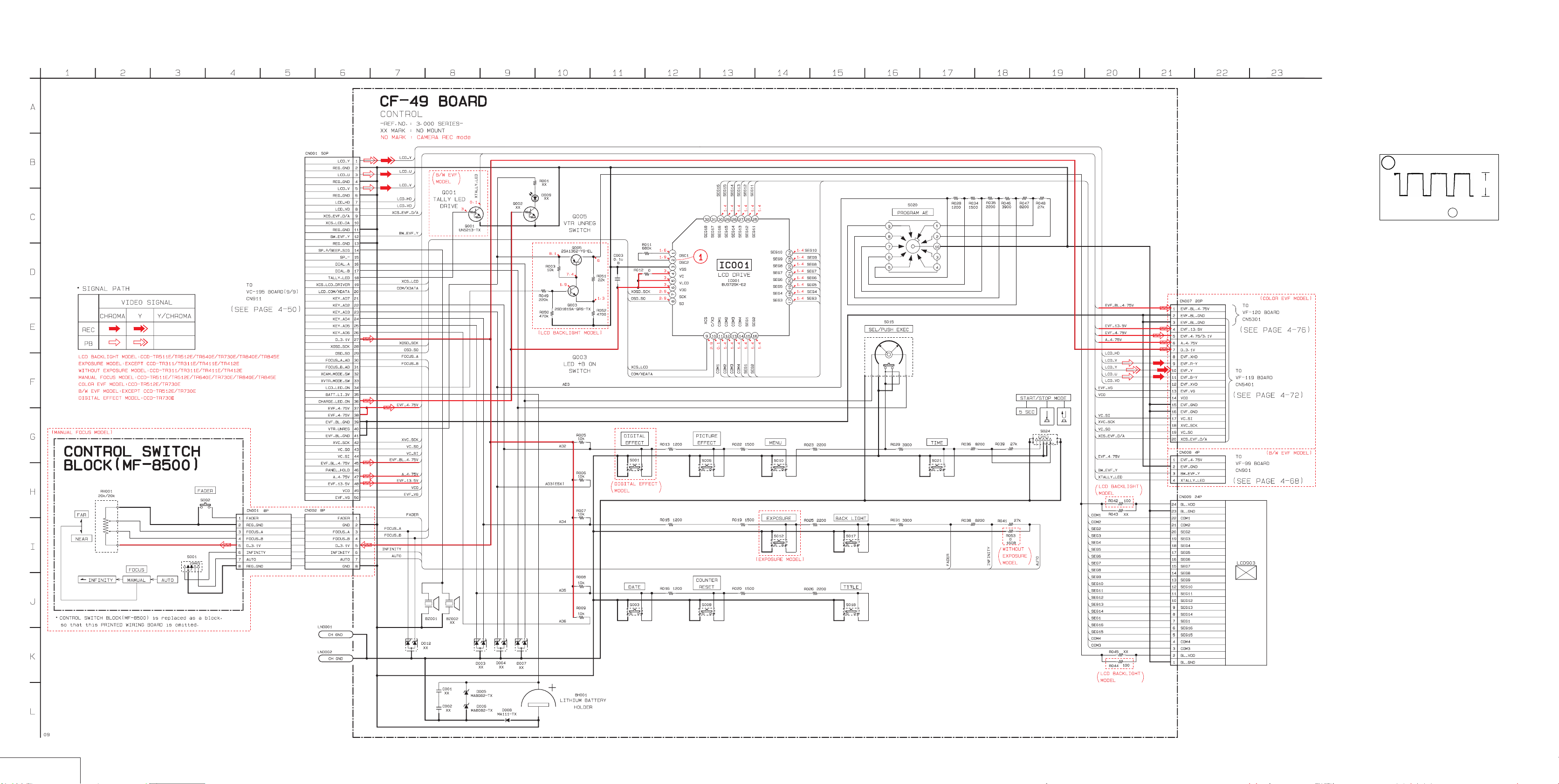
CCD-TR311/TR311E/TR411E/TR412E/TR511E/TR512E/
CF-49 BOARD
CAMERA REC
1
IC001 2
24.48 kHz
2.9Vp-p
TR640E/TR730E/TR840E/TR845E
CONTROL
CF-49
4-60
4-61 4-62
Page 70

CF-49 BOARD
123456789101112 13 14 15 16 17 18
A
B
C
D
09
CF-49 BOARD (SIDE B)
1-668-935-
12 22
CF-49 BOARD (SIDE A)
DIGITAL
EFFECT
1
VF-119
(COLOR EVF)
CD-181
(CCD IMAGER)
MA-311
(STEREO MIC)
CF-49
(CONTROL)
PJ-81
(AV IN/OUT)
DD-105
(POWER)
BH001 B-18 BZ001 B-15
BZ002 B-15 C001 B-2
C002 B-2 C003 B-12
CN002 A-14 CN007 C-14 CN008 D-14 CN009 D-6
D003 B-3 D004 C-11 D005 B-2 D006 B-2 D007 A-8 D008 B-2 D009 D-10 D012 B-5
IC001 B-12 Q001 C-15
Q002 D-10 Q003 B-12 Q005 B-12
R001 D-10 R003 B-12 R005 C-11 R006 C-11 R007 B-11 R008 B-3 R009 C-11 R011 B-12 R012 B-13 R013 C-11 R015 B-11
R016 C-4 R019 B-11 R020 C-4 R022 B-8 R023 A-8 R025 B-1 R026 C-4 R028 A-6 R029 A-14 R031 B-2 R034 A-6 R035 B-6 R038 B-2 R039 A-14 R041 B-2 R042 D-14 R043 C-14 R044 C-11 R045 C-11 R046 B-6 R047 B-8 R048 B-8 R049 C-11 R050 C-11 R051 B-12 R052 C-11 R053 B-1
S001 C-10 S003 B-3 S006 B-9 S008 D-4 S010 A-9 S012 C-10 S015 A-10 S017 B-1 S018 B-5 S020 B-7 S021 B-4 S024 A-5
CCD-TR311/TR311E/TR411E/TR412E/TR511E/TR512E/
TR640E/TR730E/TR840E/TR845E
CF-49 (CONTROL) PRINTED WIRING BOARD
– Ref No. CF-49 BOARD: 3,000 series –
• For Printed Wiring Boards.
There are few cases that the part isn't mounted in this model is
printed on this diagram.
• Chip transistor
C
Q
BE
4-63
4-64 4-65
4-66
CONTROL
CF-49
Page 71
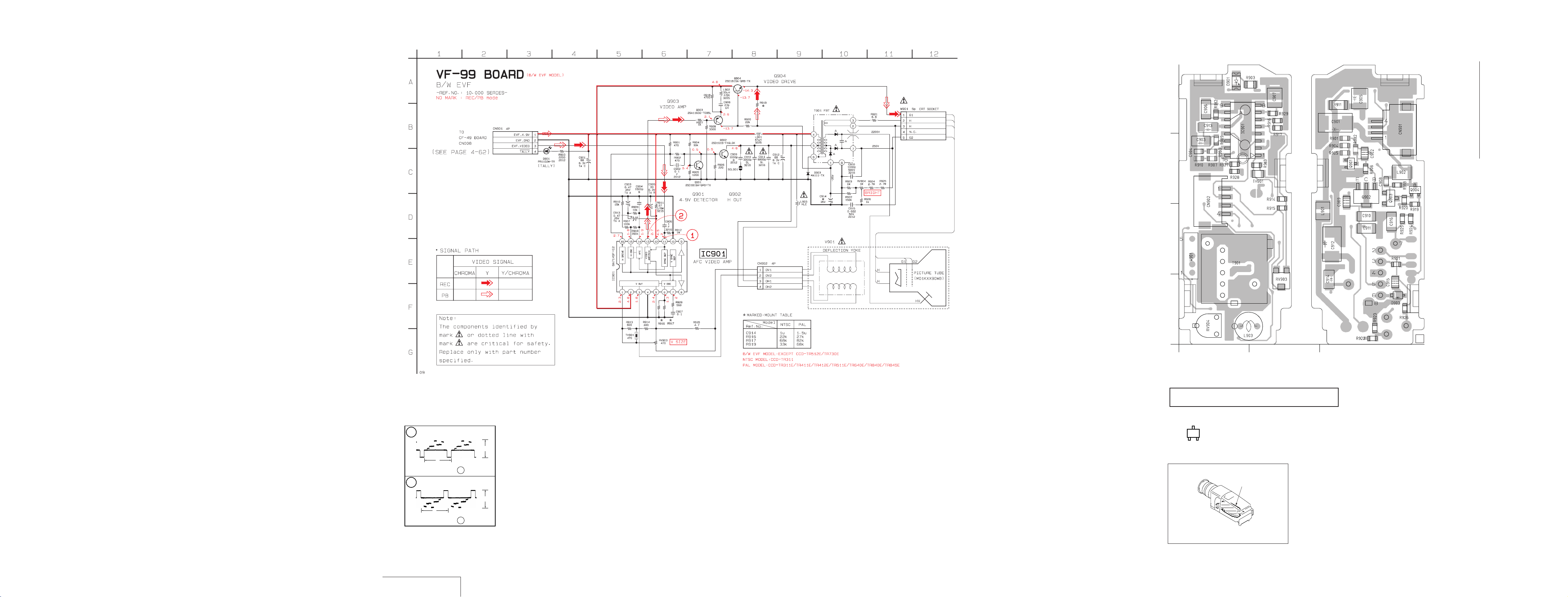
CCD-TR311/TR311E/TR411E/TR412E/TR511E/TR512E/
TR640E/TR730E/TR840E/TR845E
CCD-TR311/TR311E/TR411E/TR412E/TR511E/TR512E/
TR640E/TR730E/TR840E/TR845E
VF-99 (B/W EVF (B/W EVF MODEL)) PRINTED WIRING BOARD
– Ref No. VF-99 BOARD: 10,000 series –
VF-99 BOARD (SIDE A) VF-99 BOARD (SIDE B)
D
1
2
C
B
VF-99 BOARD
C901 D-3
C902 C-3 C903 C-1 C904 C-1 C905 D-3 C906 D-1 C907 D-2 C908 C-3 C909 C-3 C910 B-3 C911 B-3 C912 B-3 C913 D-1 C914 A-3 C915 A-3 C916 B-3
CN901 D-3 CN902 C-1
D901 D-1 D903 A-3
IC901 D-1
L901 B-3
L902 C-3 L903 A-1
Q901 C-3 Q902 C-3 Q903 C-3 Q904 C-3
R901 C-3 R902 C-3 R903 D-2 R904 C-3 R905 C-3 R906 C-3 R907 C-1 R908 C-1 R909 C-1 R910 C-1 R911 D-3 R912 D-1 R913 C-2 R914 C-2 R915 B-2 R916 D-2 R917 D-2 R918 C-3
R919 B-3 R920 C-3 R921 B-3 R922 A-3 R923 A-3 R924 B-3 R925 B-3 R926 A-3 R927 C-1 R928 C-1 R928 D-2
RV903 A-2 RV904 A-1
T901 B-1 TH901 C-2 W901 B-1
VF-99 BOARD
CAMERA REC
1
H
IC901
2
H
IC901
A
1-660-357-
09
12 3
• For Printed Wiring Boards.
• This board is four-layer print board. However, the patterns of
layers 2 to 3 have not been included in the diagram.
There are few cases that the part isn't mounted in this model is
printed on this diagram.
• Chip transistor
C
Q
1Vp-p
11
2.2Vp-p
13
BE
VF-99
(B/W EVF)
11
4-67
B/W EVF
VF-99 (B/W EVF MODEL)
4-68
4-69
4-70
Page 72
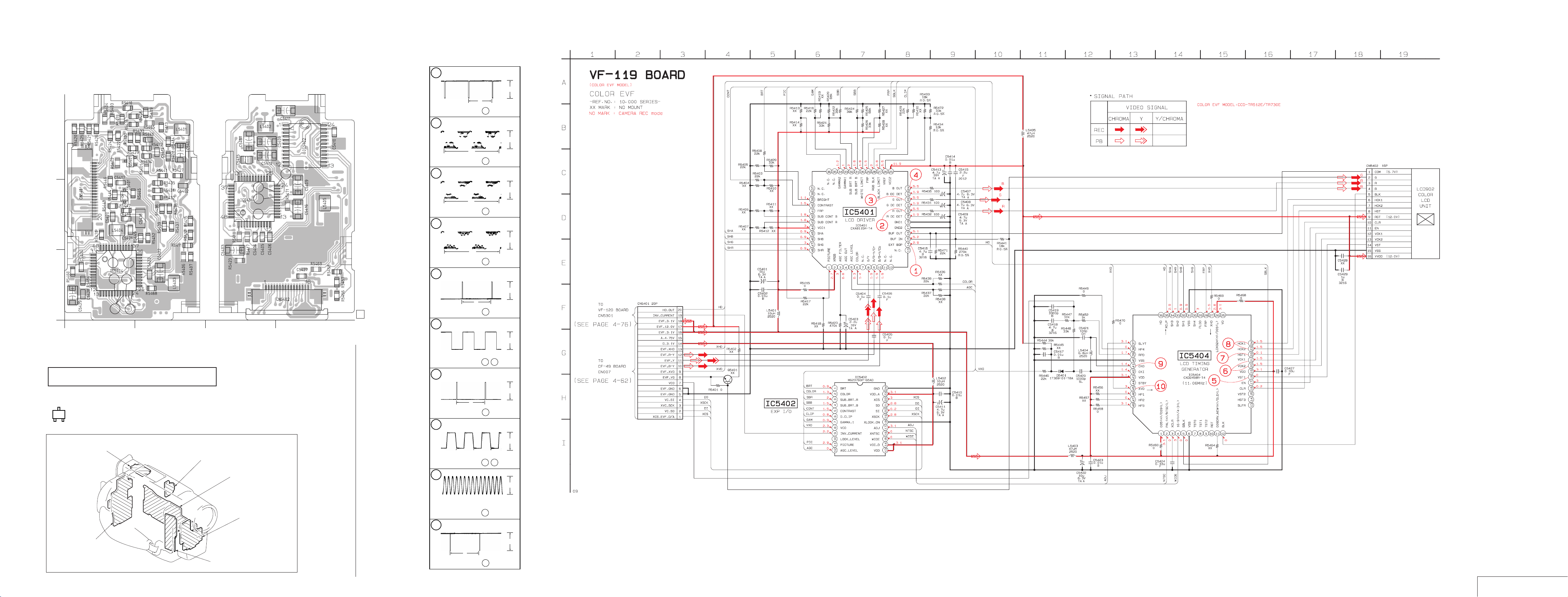
CCD-TR311/TR311E/TR411E/TR412E/TR511E/TR512E/
(
)
TR640E/TR730E/TR840E/TR845E
VF-119 (COLOR EVF (COLOR EVF MODEL)) PRINTED WIRING BOARD
– Ref No. VF-119 BOARD: 10,000 series –
VF-119 BOARD (SIDE B) VF-119 BOARD (SIDE A)
C
4
3
2
B
10
9
5
7
A
6
8
09
• For Printed Wiring Boards.
• This board is four-layer print board. However, the patterns of
layers 2 to 3 have not been included in the diagram.
There are few cases that the part isn't mounted in this model is
printed on this diagram.
• Chip transistor
C
Q
BE
123 4
VF-119
(COLOR EVF)
DD-105
(POWER)
CD-181
(CCD IMAGER)
CF-49
(CONTROL)
MA-311
(STEREO MIC)
PJ-81
AV IN/OUT
4-71 4-72
1
1-668-942-
VC-119 BOARD
C5401 C-2
C5402 B-2 C5403 A-3 C5404 B-3 C5405 B-3 C5406 B-3 C5407 C-3 C5408 C-3 C5409 B-4 C5410 C-4 C5411 C-4 C5413 C-3 C5415 C-3 C5416 B-4 C5417 B-1 C5418 B-2 C5419 B-1 C5420 B-1 C5421 B-1 C5422 A-2 C5423 A-2 C5424 A-1 C5427 A-4 C5428 A-1 C5429 A-1
CN5401 B-1
CN5402 A-4
D5401 B-1 IC5401 B-3
IC5402 C-4 IC5404 A-1
L5401 C-2 L5402 C-3 L5403 A-2 L5404 B-1 L5405 B-4
Q5401 C-1 R5401 C-2
R5402 C-1 R5403 C-1 R5404 C-1 R5405 C-2 R5406 A-2 R5407 A-2 R5408 C-1 R5409 C-2
11
R5410 C-1 R5411 B-2 R5412 B-2 R5414 C-2 R5414 C-2 R5415 B-2 R5416 C-1 R5417 B-3 R5418 B-3 R5418 C-2 R5419 C-1 R5420 C-1 R5421 C-1 R5422 C-1 R5423 A-3 R5424 C-1 R5425 C-1 R5426 C-1 R5427 C-2 R5428 C-2 R5429 C-1 R5430 C-1 R5431 B-2 R5432 B-2 R5433 C-2 R5434 C-2 R5435 B-2 R5436 B-2 R5437 B-2 R5438 B-2 R5439 B-2 R5440 C-2 R5441 C-2 R5444 B-1 R5445 B-1 R5446 B-1 R5447 B-1 R5448 B-1 R5449 B-2 R5452 B-2 R5456 A-4 R5457 A-4 R5458 A-4 R5460 A-1 R5464 A-1 R5468 A-2 R5469 A-4 R5470 B-1 R5471 B-4 R5472 C-2
VF-119 BOARD
CAMERA REC
1
IC5401
2
2H
IC5401
3
2H
IC5401
4
2H
IC5401
5
IC5404
6
7.852 kHz
IC5404 20 21
7
H
IC5404
8
1.84 MHz
IC5404 23 24
9
11.06 MHz
IC5404 41
10
V
IC5404
3Vp-p
H
14
7.2Vp-p
20
7.5Vp-p
22
7.6Vp-p
24
3Vp-p
V
18
3Vp-p
,
3Vp-p
22
3.4Vp-p
,
2.7Vp-p
3Vp-p
45
4-73
4-74
COLOR EVF
VF-119 (COLOR EVF MODEL)
Page 73
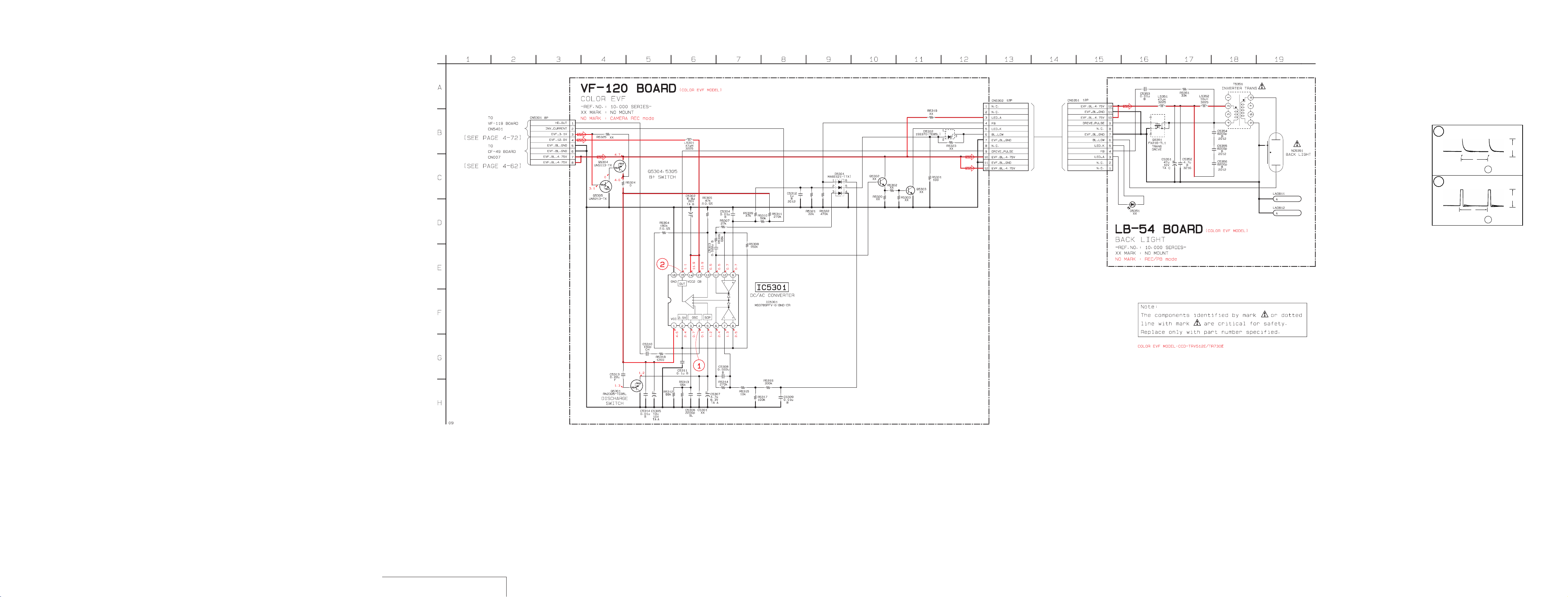
CCD-TR311/TR311E/TR411E/TR412E/TR511E/TR512E/
VF-120 BOARD
CAMERA REC
H
2.4Vp-p
IC5301
4
H
12Vp-p
IC5301
15
1
2
TR640E/TR730E/TR840E/TR845E
CCD-TR311/TR311E/TR411E/TR412E/TR511E/TR512E/
TR640E/TR730E/TR840E/TR845E
4-75
COLOR EVF, BACK LIGHT
VF-120, LB-54 (COLOR EVF MODEL)
4-76 4-77
4-78
Page 74
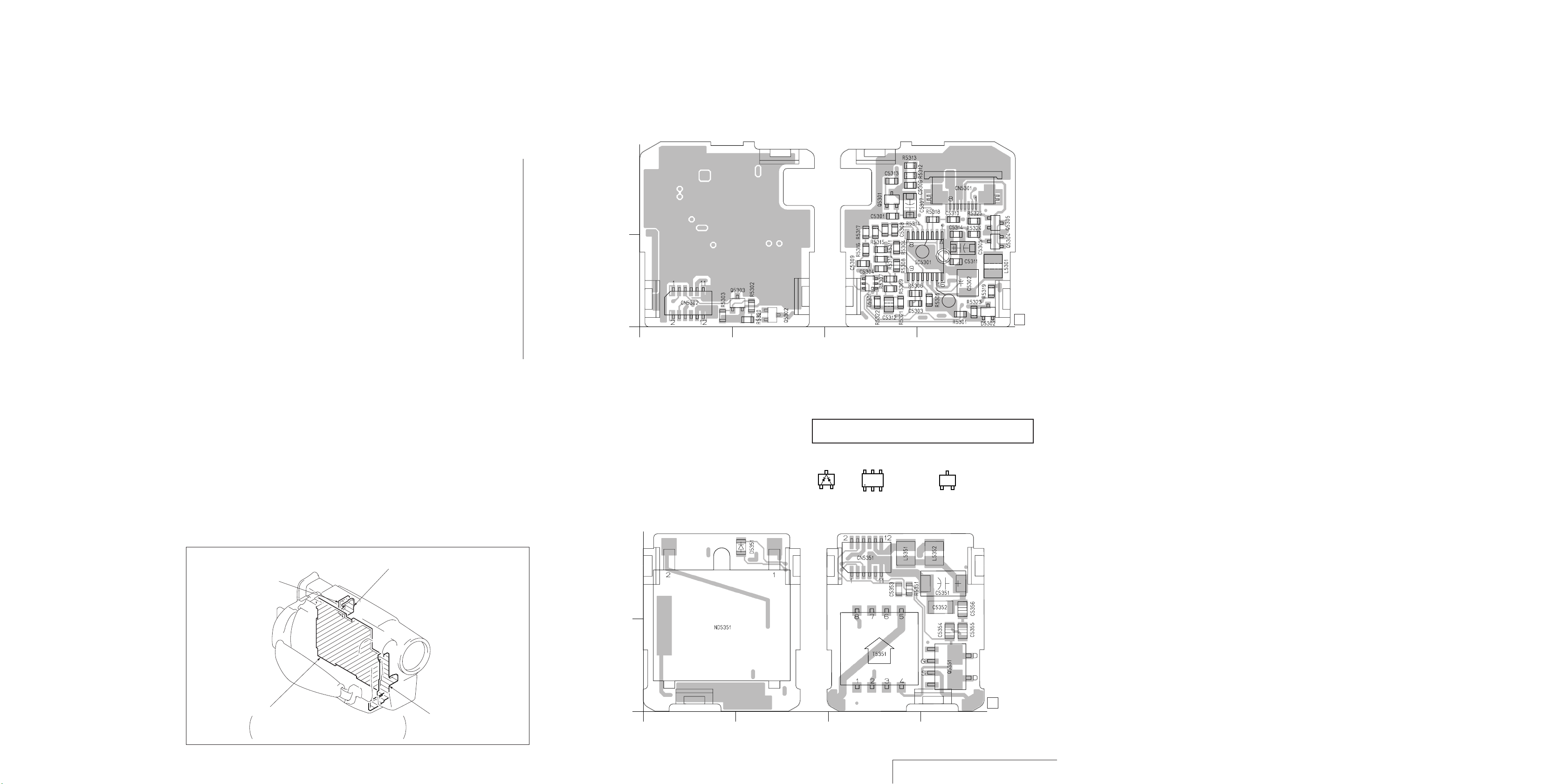
VF-120 BOARD
C5301 B-3
C5302 A-4 C5303 A-4 C5304 A-3 C5305 A-4 C5306 B-4 C5307 B-4 C5308 B-3 C5309 A-3 C5310 B-4 C5311 A-4 C5312 A-3 C5313 B-3
CN5301 B-4
CN5302 A-1
D5301 A-3 D5302 A-4
IC5301 A-4 L5301 A-4 Q5301 B-3
Q5302 A-2 Q5303 A-2 Q5304 A-4 Q5305 B-4
R5302 A-2 R5302 A-4 R5303 A-1 R5303 A-3
R5304 A-3 R5305 A-4 R5306 A-4 R5307 A-3 R5309 A-3 R5310 A-3 R5311 A-3 R5312 B-4 R5313 B-4 R5314 B-3 R5315 B-3 R5316 A-3 R5317 B-3 R5318 B-4 R5319 A-4 R5320 A-2 R5321 A-3 R5322 A-3 R5323 A-4 R5324 A-4 R5325 B-4
CCD-TR311/TR311E/TR411E/TR412E/TR511E/TR512E/
TR640E/TR730E/TR840E/TR845E
VF-120 (COLOR EVF), LB-54 (BACK LIGHT) (COLOR EVF MODEL) PRINTED WIRING BOARDS
– Ref No. VF-120 BOARD: 10,000 series, LB-54 BOARD: 10,000 series –
VF-120 BOARD (SIDE B) VF-120 BOARD (SIDE A)
B
1
A
1-668-943 -
09
1234
CCD-TR311/TR311E/TR411E/TR412E/TR511E/TR512E/
TR640E/TR730E/TR840E/TR845E
2
11
LB-54
(BACK LIGHT)
VF-120
(COLOR EVF)
LB-54 BOARD
C5351 B-4
C5352 B-4 C5353 B-3 C5354 A-4 C5355 A-4 C5356 B-4
CN5351 B-3
D5351 B-2
L5351 B-3
L5352 B-4 ND5351 A-1 Q5351 A-4 R5351 B-3 T5351 A-3
• For Printed Wiring Boards.
• This board is four-layer print board. However, the patterns of
layers 2 to 3 have not been included in the diagram.
There are few cases that the part isn't mounted in this model is
printed on this diagram.
• Chip diode • Chip transistor
3
546
D
21
132
BE
LB-54 BOARD (SIDE B) LB-54 BOARD (SIDE A)
B
C
Q
VC-195
CAMERA, Y/C PROCESSOR, IN/OUT,
REC/PB HEAD AMP, SERVO/SYSTEM CONTROL,
SERVO, AUDIO, MODE CONTROL
4-79
SE-65
(STEADY SHOT)
A
09
1234
4-80
1-668-944-
11
COLOR EVF, BACK LIGHT
VF-120, LB-54 (COLOR EVF MODEL)
4-81
Page 75
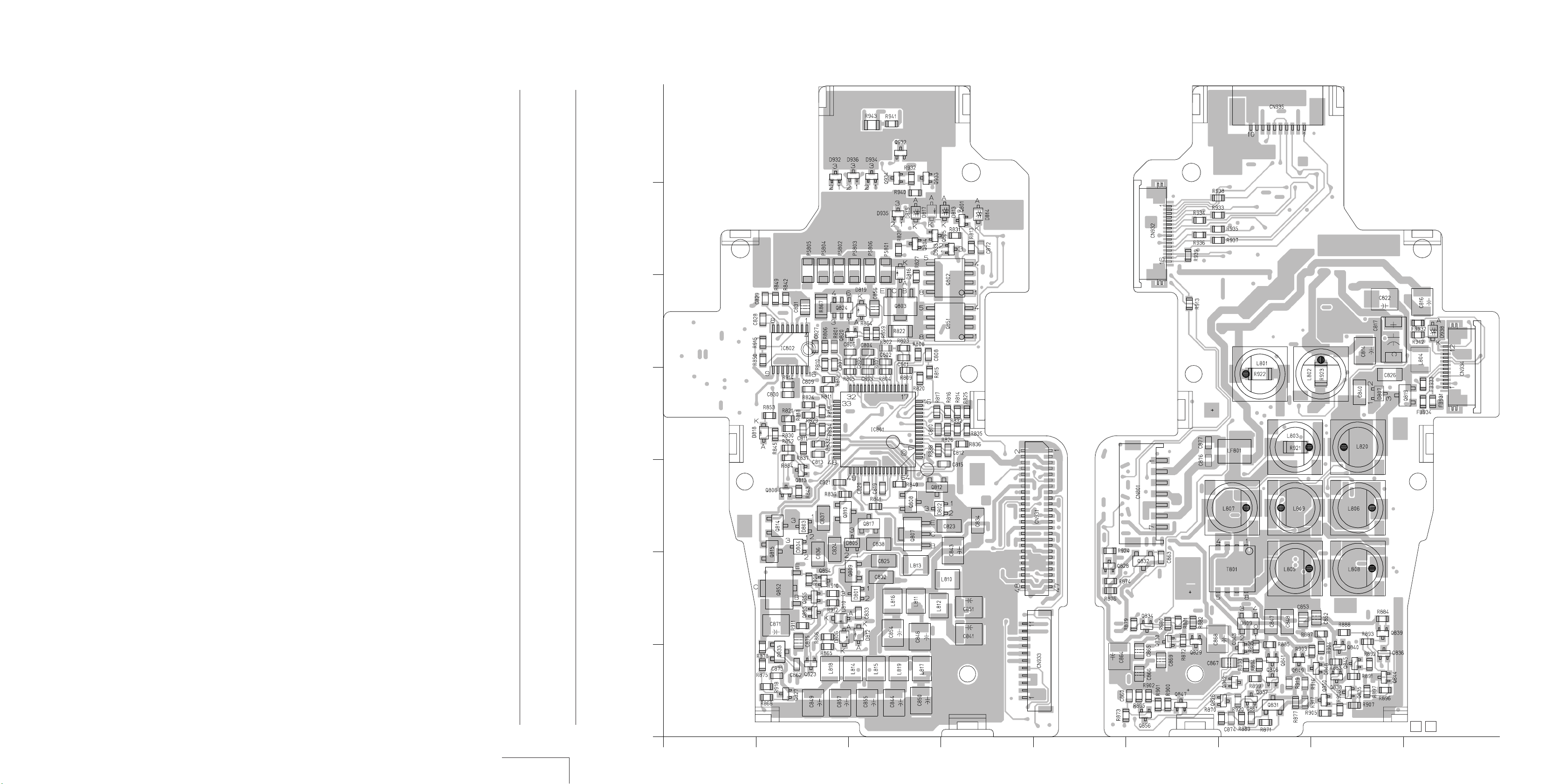
CCD-TR311/TR311E/TR411E/TR412E/TR511E/TR512E/
TR640E/TR730E/TR840E/TR845E
CCD-TR311/TR311E/TR411E/TR412E/TR511E/TR512E/
TR640E/TR730E/TR840E/TR845E
DD-105 (POWER) PRINTED WIRING BOARD
– Ref No. DD-105 BOARD: 2,000 series –
DD-105 BOARD
C801 E-3
C802 E-3 C803 D-3 C804 E-3 C805 E-3 C806 E-3 C807 E-2 C808 E-3 C809 D-2 C810 D-3 C811 D-2 C812 D-4 C813 D-2 C814 E-8 C815 C-4 C816 E-9 C817 E-8 C819 C-3 C820 C-3 C821 C-2 C822 E-8 C823 C-4 C824 C-2 C825 B-3 C826 D-8 C827 E-2 C828 E-2 C829 E-2 C830 D-2 C831 E-2 C832 B-3 C833 B-3 C834 C-4 C836 B-2 C837 C-2 C838 C-3 C840 D-8 C841 B-4 C843 C-4 C844 A-3 C846 B-3 C847 B-7 C848 B-7 C849 A-2 C850 A-3 C851 B-4 C852 B-8 C853 B-7 C854 B-3 C855 A-3 C856 E-3 C857 A-2 C860 A-6 C861 A-7 C862 A-2 C863 B-6 C864 A-5 C866 A-6 C867 A-7 C868 B-6 C869 A-6 C871 B-2 C872 F-4 C873 A-2 C874 A-7 C875 B-2 C876 C-6 C877 D-6 C885 A-6
CN801 C-6 CN931 C-5 CN932 F-6 CN933 A-4 CN934 D-9 CN935 G-7
D801 B-3 D802 C-3 D803 C-2 D804 C-2 D805 C-3 D806 B-2 D807 D-8 D809 B-7 D810 B-2 D812 B-3 D813 F-4 D814 F-4 D815 F-3 D816 E-3 D817 F-3 D818 D-2 D819 E-3 D838 E-9 D932 G-2 D933 F-4 D934 G-3 D935 F-3 D936 G-3
FB931 D-9 FB932 E-9 FB933 D-9 FB934 D-9
IC801 D-3 IC802 E-2
L801 D-7 L802 D-7 L803 D-8 L804 E-9 L805 B-7 L806 C-8 L807 C-7 L808 B-8 L809 C-7 L810 B-4 L811 B-3 L812 B-3 L813 B-3 L814 A-3 L815 A-3 L816 B-3 L817 A-3 L818 A-2 L819 A-3 L820 D-8
LF801 D-7 PS801 F-3
PS802 F-2 PS803 F-3 PS804 F-2 PS805 F-2 PS806 F-3
Q801 F-4 Q802 E-4 Q803 E-3 Q804 F-3 Q805 F-3 Q806 C-2 Q807 C-3 Q808 C-3 Q809 B-3 Q810 C-2 Q812 C-3 Q813 C-2 Q814 C-2 Q815 C-2 Q817 C-3 Q819 D-8 Q820 E-3 Q823 A-2 Q824 E-2 Q826 A-7 Q827 A-2 Q828 B-5 Q829 B-6 Q830 B-6 Q831 A-7 Q832 B-6 Q833 A-2 Q834 B-6 Q835 A-8 Q836 A-8 Q837 A-7 Q838 A-8 Q839 B-8 Q840 A-8 Q841 A-7 Q842 A-7 Q843 A-7 Q844 A-8 Q845 A-8 Q846 A-7 Q847 A-6 Q848 A-8 Q849 A-7 Q850 A-8 Q851 E-4 Q852 B-2 Q853 B-2 Q854 B-2 Q855 B-2 Q856 A-6 Q932 G-3 Q933 G-3 Q934 G-3
R801 E-2 R802 E-3 R803 E-3 R804 D-3 R805 D-3 R807 E-3 R808 E-2 R808 E-3 R809 D-3 R810 E-2 R811 D-2 R812 D-2 R813 F-4 R814 D-4 R815 D-3 R816 D-4 R817 D-3 R818 D-2 R819 D-2 R820 D-3 R821 D-2 R822 E-3 R822 D-7 R822 D-8
R823 D-7
R824 D-2
R825 D-4
R826 D-4
R827 E-3
R828 F-3
R829 D-2
R830 D-2
R831 F-4
R832 D-4
R833 D-2
R834 D-2
R835 D-4
R836 D-4
R837 D-2
R838 D-3
R839 C-2
R840 C-3
R841 C-3
R842 E-2
R843 C-2
R849 E-2
R850 E-2
R852 D-2
R853 D-2
R854 D-2
R854 D-2
R859 E-3
R864 E-3
R865 A-2
R866 B-2
R867 E-2
R868 A-2
R870 A-7
R871 A-7
R872 B-6
R873 A-5
R874 B-5
R875 A-2
R876 B-5
R877 A-7
R878 A-2
R879 B-6
R880 B-6
R881 B-6
R882 B-6
R883 A-8
R884 B-8
R885 B-7
R887 B-8
R888 B-8
R889 A-7
R890 A-7
R891 A-8
R892 A-8
R893 B-8
R894 A-7
R895 A-6
R896 A-8
R897 A-8
R898 A-7
R899 A-7
R900 A-6
R901 A-6
R902 A-6
R903 A-8
R904 A-8
R905 A-8
R906 A-8
R907 A-8
R908 B-2
R910 B-2
R911 B-2
R912 B-2
R913 E-6
R914 D-2
R915 E-2
R916 A-7
R917 A-7
R918 A-2
R919 A-7
R920 A-7
R924 C-5
R932 G-3
R933 F-7
R934 F-6
R935 F-7
R936 F-6
R937 F-7
R938 F-7
R939 F-6
R940 F-3
R941 G-3
R942 E-9
R943 G-3
T801 B-7
DD-105 BOARD (SIDE B) DD-105 BOARD (SIDE A)
G
F
E
D
1
2
C
B
A
09
123456789
1-668-929-
12 22
4-82
POWER
DD-105
4-83 4-84
Page 76

CCD-TR311/TR311E/TR411E/TR412E/TR511E/TR512E/
DD-105 BOARD
CAMERA REC
1
2
IC801 4
507 kHz
0.76Vp-p
IC801 64
506 kHz
0.76Vp-p
TR640E/TR730E/TR840E/TR845E
4-85 4-86
4-87
4-88E
POWER
DD-105
Page 77

CCD-TR311/TR311E/TR411E/TR412E/TR511E/TR512E/
ADJUSTMENTS
5-1. CAMERA SECTION ADJUSTMENTS
1-1. PREPARATIONS BEFORE ADJUSTMENT
(CAMERA SECTION)
1-1-1. List of Service Tools
• Oscilloscope
• Adjusting driver
Ref. No.
J-1
J-2
J-3
J-4
J-5
J-6
J-7
J-8
J-9
J-10
J-11
J-12
Filter for color temperature correction
(C14)
ND filter 1.0
ND filter 0.3
Pattern box PTB-450
Color chart for pattern box
Adjusting remote commander
(RM-95-remodeled partly) Note 1
Siemens star
CPC-7 jig
Power code Note 2
AFM DEV jig
Clear chart
Extension cable (16P, 0.5 mm)
Extension cable (48P, 0.8 mm)
• Color monitor
• Regulated power supply
Name
TR640E/TR730E/TR840E/TR845E
SECTION 5
Refer to page 3 as Table for distinction
functions of models and classification
• Vectorscope
• Digital voltmeter
Parts Code
J-6080-058-A
J-6080-808-A
J-6080-818-A
J-6082-200-A
J-6020-250-A
J-6082-053-B
J-6080-875-A
J-6082-382-A
J-6082-223-A
J-6082-312-A
J-6080-621-A
J-6082-357-A
J-6082-188-A
Auto white balance adjustment/check
White balance adjustment/check
White balance check
White balance check
For checking the flange back
For the color viewfinder adjustment
For adjusting the video section
For connecting the battery terminal and DC power supply
For adjusting the deviation
For extension between the CD-181 board (CN401) and
VC-195 board (CN501)
For extension between the DD-105 board (CN931) and
VC-195 board (CN914)
Usage
Note 1: If the micro processor IC in the adjusting remote
commander is not the new micro processor (UPD7503GC56-12), the pages cannot be switched. In this case, replace
with the new micro processor (8-759-148-35).
J-1 J-2
J-7J-6 J-8 J-9 J-10
J-11 J-12
J-3
Note 2: Connect the adjusting remote commander to the LANC
jack, and set the HOLD switch to the “ADJ” side , or press
the battery switch of the battery terminal using adhesive
tape, etc.
J-4 J-5
Fig. 5-1-1.
5-1
Page 78

1-1-2. Preparations
Note 1: For details of how remove the cabinet and boards, refer to
“2. DISASSEMBLY”.
Note 2: When performing only the adjustments, the lens block and
boards need not be disassembled.
1) Connect the equipment for adjustments according to Fig. 5-1-3,
4.
2) By setting the “Forced Camera Power ON mode”, the camera
power can be turned ON even if the front panel b lock (MA-311
board, power switch, microphone unit) has been remov ed. When
removing the front panel block disconnect the following
connector.
1. VC-195 board CN903 (23P 0.5mm)
3) The intelligent accessory shoe (Intelligent accessory shoe model)
need not be assembled. If removing it. disconnect the following
connector.
1. VC-195 board CN909 (10P, 0.5mm)
Note 3: As removing the cabinet (R) (removing the VC-195 board
CN911) means removing the lithium 3V power supply
(CF-49 board) , data such as date, time, user-set menus
will be lost. After completing adjustments, reset these data.
If the cabinet (R) has been removed, the self-diagnosis
data, data on history of use (total drum rotation time etc. )
will be lost. Before removing, note down the self-diagnosis
data and data on the history use. (Refer to the “Service
Mode” of “VIDEO SECTION ADJUSTMENT” for the
data on the history use.)
Pattern box
1.5m
Front of lens
Fig. 5-1-2.
Note 4: Setting the “Forced Camera Power ON” Mode
1)Select page: 0, address: 01, and set data: 01.
2)Select page: D, address: 10, set data: 01, and press the
PAUSE button of the adjusting remote commander.
The above procedure will enable the camera power to
be turned on with the front panel block removed. After
completing adjustments, be sure to exit the “Forced
Camera Power ON Mode”.
Note 5: Exiting the “Forced Camera Power ON” Mode
1)Select page: 0, address: 01, and set data: 01.
2)Select page: D, address: 10, set data: 00, and press the
PAUSE button of the adjusting remote commander.
3)Select page: 0, address: 01, and set data: 00.
5-2
Page 79
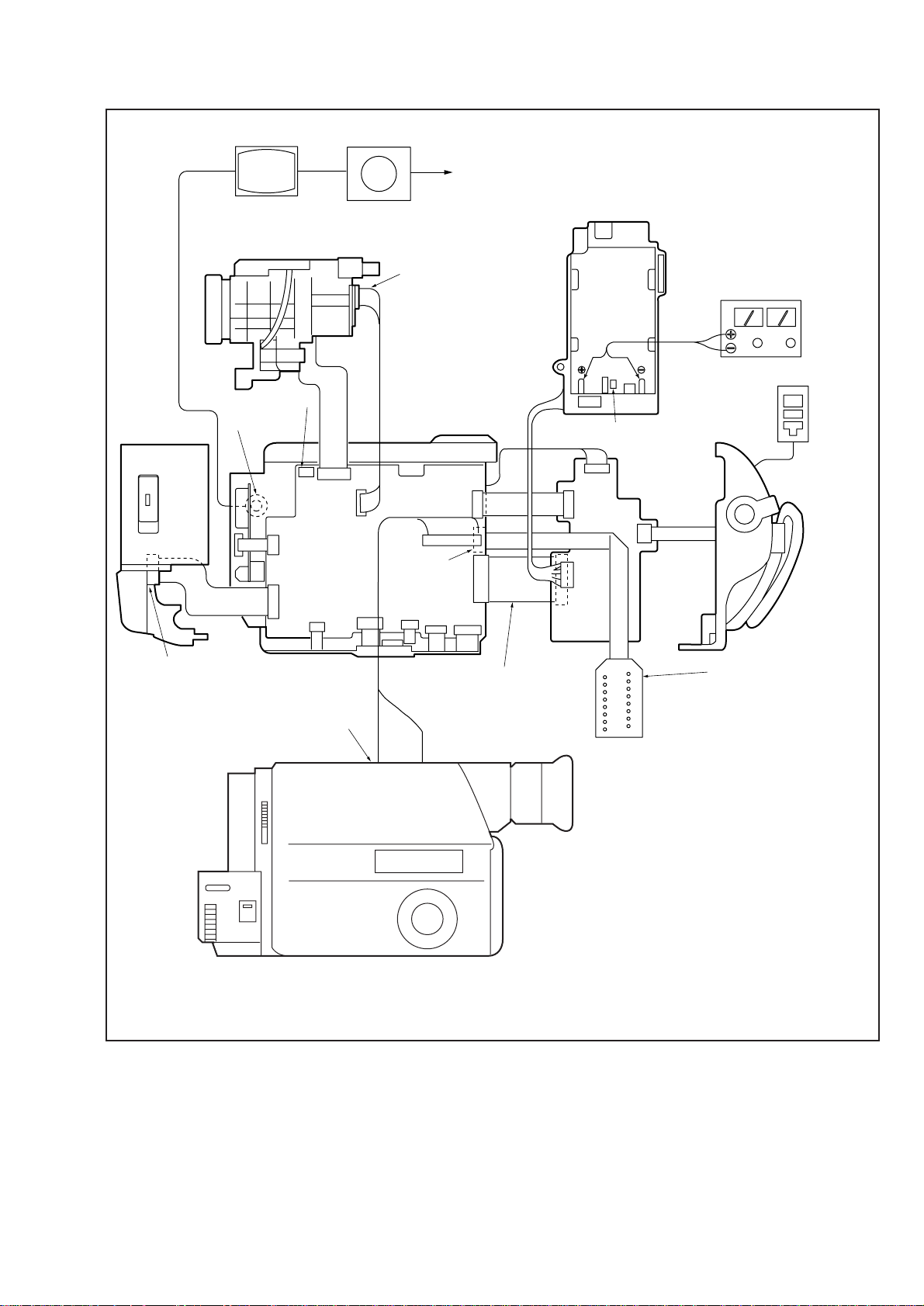
Color monitor Vector scope
Terminated at 75
Ω
Lens block
CD-181 board
CN401
Extension cable(16P)
(J-6082-357-A)
Need not connected
VIDEO terminal
CN909
CN551
CN902
CN903
CN901
CN001
CN905
CN906
CN908
CN914
CN910
CN911
CN912
Battery switch
MA-311 board
CN303
Extension cable(48P)
(J-6082-188-A)
CPC-7 jig
(J-6082-382-A)
Must be connected when
performing the VIDEO system
or color EVF system
adjustments.
CN935
CN932
CN934
CN801
CN931
DD-105
board
LANC
terminal
Adjusting
remote
commander
Regulaterd power supply
(8.4
±
0.1 Vdc)
Battery
terminal
VC-195
board
CN501
(Note 1)
CF-49 board CN001
Note 1: Connect the adjusting remote commander to the LANC
Fig. 5-1-3.
jack, and set the HOLD switch to the “ADJ” side, or press
the battery switch of the battery terminal using adhesive
tape, etc. or use the AC power adaptor.
5-3
Page 80
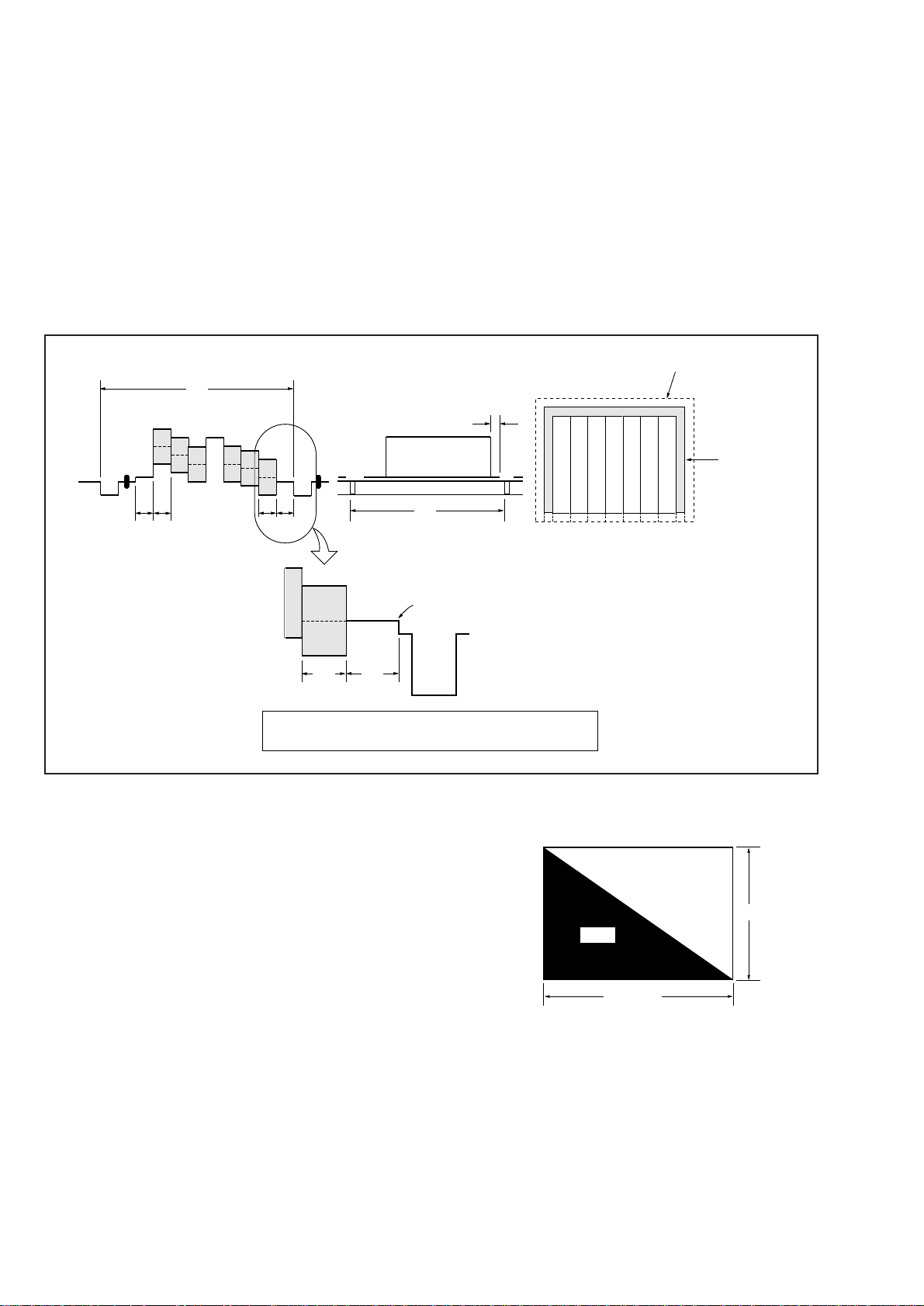
1-1-3.Precaution
e
1. Setting the Switch
Unless otherwise specified, set the switches as follows and perf orm
adjustments without loading cassette.
1. POWER switch (MA-311 board) ...........................CAMERA
2. NIGHT SHOT switch (Lens Block)................................ OFF
(Night shot model)
3. DEMO MODE (Menu display) ....................................... OFF
4. DIGITAL ZOOM (Menu display)................................... OFF
5. STEADY SHOT (Menu display) .................................... OFF
2. Adjusting Procedure
Adjust in the given order.
6. FOCUS switch (MF-8500) .................................... MANUAL
(Manual Focus model)
7. PROGRAM AE (CF-49 board) ....................................... Auto
8. BACK LIGHT (CF-49 board) ......................................... OFF
9. PICTURE EFECT (CF-49 board) ................................... OFF
10. 16 : 9 WIDE (MENU display) ........................................ OFF
Color bar chart standard picture trame
H
Yellow
Cyan
White
Magenta
Green
AB
Fig. a. (Video output terminal
output wavefom)
A=B
Red
Blue
A
B
Enlargement
AB
Adjust the camera zoom and direction to obtain the output wavefom
shown in Fig. a and the TV monitor display shown in Fig. b.
3. Subject
1) Color bar chart (Standard picture frame)
Adjust the picture frame as shown in Fig. 5-1-4. if adjustments
are performed using the color bar chart.
(Standard picture frame)
2) White pattern (Standard picture frame)
Remove the color bar chart from the pattern box, and insert a
clear chart in its place. (Do not perform zoom operations during
this time.)
3) Chart for flange back adjustment
Combine a white A0 size (1189 mm x 841 mm) paper to a black
one, and make the chart shown in Fig. 5-1-5.
0
±
0.1 msec
V
Difference in level
Fig. 5-1-4.
Cyan
Green
Yellow
Fig. b. (TV monitor picture)
Black
White
Magenta
1189 mm
Red
White
Blue
Fig. 5-1-5.
Electronic beam
scanning frame
CRT picture fram
841 mm
Note : Use the non-reflecting and non-glazing vellum paper
whose size is more than A0, and make the boundary
between white and black to be smoothly flat.
5-4
Page 81

1-1-4. Adjusting Remote Commander
The adjusting remote commander is used for changing the
calculation coefficient in signal processing, EVR data, etc. The
adjusting remote commander performs bi-directional
communication with the unit using the remote commander signal
line (LANC). The resultant data of this bi-directional communication
is written in the non-volatile memory.
1. Using the adjusting remote commander
1) Connect the adjusting remote commander to the LANC terminal.
2) Adjust the HOLD switch of the adjusting remote commander to
“HOLD” (SERVICE position).
If it has been properly connected, the LCD on the adjusting remote
commander will display as shown in Fig. 5-1-6.
Page Data
Address
Fig. 5-1-6.
• Changing the address
The address increases when the FF ()) button is pressed,
and decreases when the REW (0) button is pressed. There
are altogether 256 addresses, from 00 to FF.
• Changing the data (Data setting)
The data increases when the PLAY (() button is pressed,
and decreases when the STOP (p) button is pressed.
There are altogether 256 data, from 00 to FF.
• Writing the adjustment data
The PAUSE button must be pressed to write the adjustment
data (D, E, F page) in the nonvolatile memory.
(The new adjustment data will not be recorded in the non volatile
memory if this step is not performed.)
4) Select page: 0, address: 01, and set the data to 01, and enables
Page D and E, F to be adjusted.
5) After completing all adjustments, set data: 00 to page: 0, address:
01 and turn off the main power supply (8.4V) once.
2. Precautions upon using the adjusting remote
commander
Mishandling of the adjusting remote commander may erase the
correct adjustment data at times. T o pr event this, it is recommended
that all adjustment data be noted down before beginning adjustments
and new adjustment data after each adjustment.
3) Operate the adjusting remote commander as follows.
• Changing the page
The page increases when the EDIT SEARCH+ button is
pressed, and decreases when the EDIT SEARCH– button is
pressed. There are altogether 16 pages, from 0 to F.
Hexadecimal
notation
LCD Display
Decimal notation
conversion value
0123456789ABCDEF
0 123456789A b c d E F
0123456789101112131415
Table 5-1-1.
5-5
Page 82
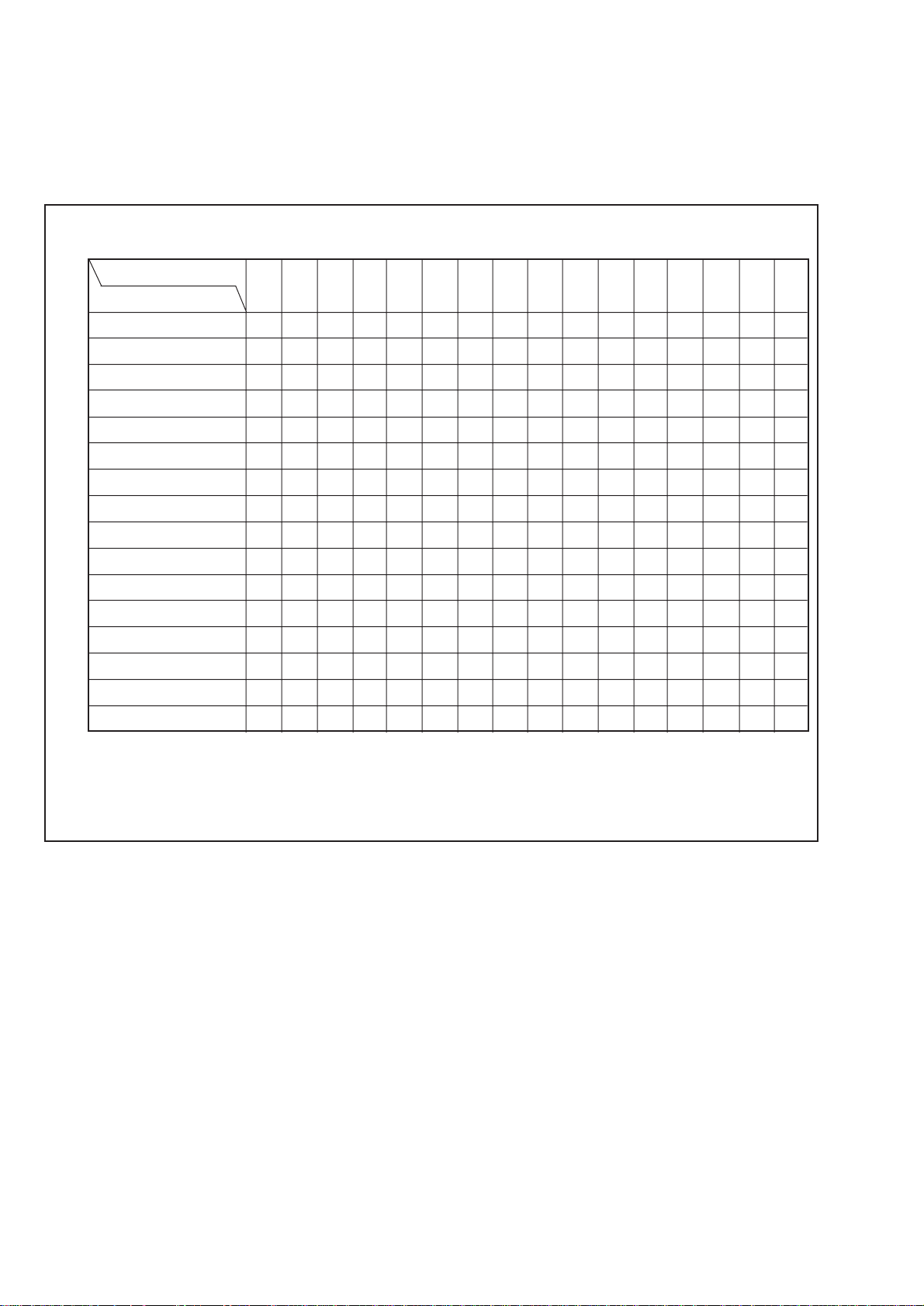
1-1-5. Data Processing
The calculation of the DDS display and the adjusting remote
commander display data (hexadecimal notation) are required for
obtaining the adjustment data of some adjustment items. In this case,
after converting the hexadecimal notation to decimal notation,
calculate and conv ert the result to hexadecimal notation, and use it
as the adjustment data. Table 5-1-2. indicates the hexadecimal
notation-the decimal notation calculation table.
Hexadecimal notation-Decimal notation
The lower digits of the
hexadecimal notation
The upper digits of the
hexadecimal notation
0
1
2
3
4
5
6
7
8
9
A)
A (
1n
B (
C (
D (
E (
F (
b)
c)
d)
E)
F)
0123456789ABCDEF
0123456789101112131415
16 17 18 19 20 21 22 23 24 25 26 27 28 29 30 31
32 33 34 35 36 37 38 39 40 41 42 43 44 45 46 47
48 49 50 51 52 53 54 55 56 57 58 59 60 61 62 63
64 65 66 67 68 69 70 71 72 73 74 75 76 77 78 79
80 81 82 83 84 85 86 87 88 89 90 91 92 93 94 95
96 97 98 99 100 101 102 103 104 105 106 107 108 109 110 111
112 113 114 115 116 117 118 119 120 121 122 123 124 125 126 127
128 129 130 131 132 133 134 135 136 137 138 139 140 141 142 143
144 145 146 147 148 149 150 151 152 153 154 155 156 157 158 159
160 161 162 163 164 165 166 167 168 169 170 171 172 173 174 175
176 177 178 179 180 181 182 183 184 185 186 187 188 189 190 191
192 193 194 195 196 197 198 199 200 201 202 203 204 205 206 207
208 209 210 211 212 213 214 215 216 217 218 219 220 221 222 223
224 225 226 227 228 229 230 231 232 233 234 235 236 237 238 239
240 241 242 243 244 245 246 247 248 249 250 251 252 253 254 255
2
n
(
A)(b)(c)(d)(E)(F)
Note: ( ) indicate the adjusting remote commander display.
(Example) In the case that the DDS display and the adjusting remote commander display are BD (bd).
As the upper digit of the hexadecimal notation is B (b), and the lower digit is D (d), the intersection “189" of the 1
and 2 in the above table is the decimal notation to be calculated.
Table 5-1-2.
5-6
Page 83

1-2. INITIALIZA TION OF D, E, F P AGE DATA
1. Initializing the D,E,F Page Data
Note 1: If “Initializing the D, E, F Page Data” is performed,
all data of the D page, E page and F page will be
initialized. (It is impossible to initialize a single
page.)
Note 2: If the D,E,F page data has been initialized, “Modification
of D, E, F Page Data” and all adjustments need to be
performed again.
Note 3: < > : NTSC model (CCD-TR311)
[ ] : PAL model (CCD-TR311E/TR411E/TR412E/
TR511E/TR512E/TR640E/TR730E/
TR840E/TR845E)
Adjusting page D
Adjusting Address 00 to 6F
Adjusting page F
Adjusting Address 00 to FF
Adjusting page E
Adjusting Address 00 to FF
Initializing Method:
1) Select page: 0, address: 01, and set data: 01.
2) Select page: 2, address: 00, and set data: 55 <NTSC> or
data : 51 [PAL].
3) Select page: 2, address: 01, set data: 55<NTSC> or data : 51
[PAL], and pr ess the PAUSE button of the adjusting remote
commander.
4) Select page: 2, address: 02, and check that the data is 01.
5) Select page: 3, address: 00, and set data: 29.
6) Select page: 3, address: 01, set data: 29, and press the PAUSE
button of the adjusting remote commander.
7) Select page: 0, address: 01, and set data: 00.
8) Perform “Modification of D,E,F Page Data”.
2. Modification of D, E, F Page Data
If the D, E, F page data has been initialized, change the data of the
“Fixed data-2” address shown in the following tables by manual
input.
Modifying Method:
1) Before changing the data, select page: 0, address: 01, and set
data: 01.
2) New data for changing are not shown in the tables because they
are different in destination. When changing the data, copy the
data built in the same model.
Note : If copy the data built in the different model, the camcorder
may not operate.
3) When changing the data, press the P A USE button of the adjusting
remote commander each time when setting new data to write the
data in the non-volatile memory.
4) Check that the data of adjustment addresses is the initial value.
If not, change the data to the initial value.
5) After complea ting “Modification of D, E, F Page Data” select
page: 0, address: 01, and set data: 00. Also perform all
adjustments.
5-7
Page 84
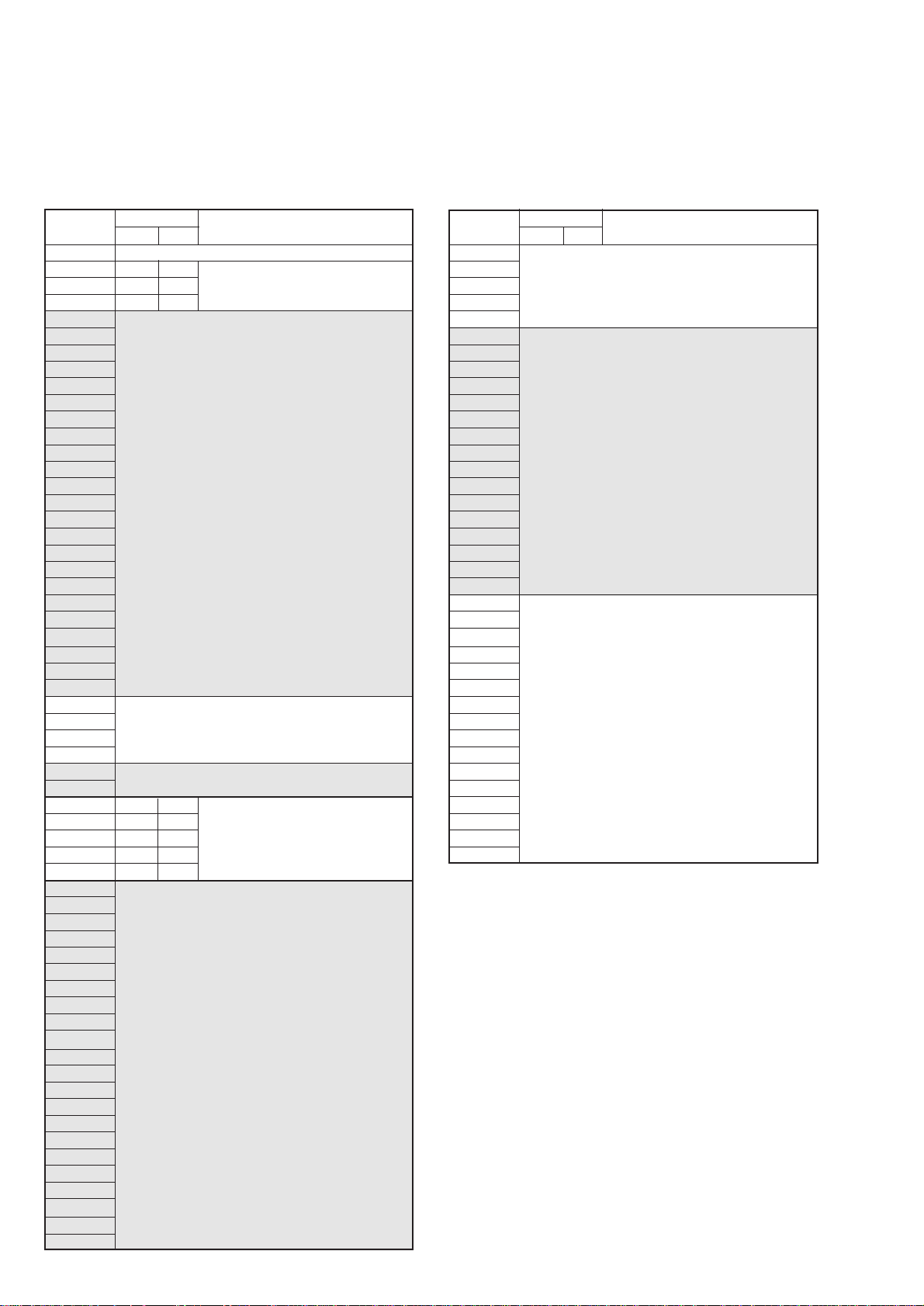
3. D Page T able
Note1 :
Fixed data-1 : Initialized data.
(Refer to “1. Initializing the D,E,F Page Data”.)
Fixed data-2 : Modified data.
(Refer to “2. Modification of D, E, F Page Data”).
Address Initial Value Remark
NTSC P A L
00 to 0F
10 00 00 Fixed data-1
11 00 00 (Initialized data)
12 00 00
13 Fixed data-2
14 (Modified data, copy the data
15 built in the same model.)
16
17
18
19
1A
1B
1C
1D
1E
1F
20
21
22
23
24
25
26
27
28
29
2A Fixed data-1
2B (Initialized data)
2C
2D
2E Fixed data-2
2F
30 88 88 Battery end adj.
31 8D 8D
32 A8 A8
33 BD BD
34 C8 C8
35 Fixed data-2
36 (Modified data, copy the data
37 built in the same model.)
38
39
3A
3B
3C
3D
3E
3F
40
41
42
43
44
45
46
47
48
49
4A
Address Initial V alue Remark
NTSC P A L
4B Fixed data-1
4C (Initialized data)
4D
4E
4F
50 Fixed data-2
51 (Modified data, copy the data
52 built in the same model.)
53
54
55
56
57
58
59
5A
5B
5C
5D
5E
5F
60 Fixed data-1
61 (Initialized data)
62
63
64
65
66
67
68
69
6A
6B
6C
6D
6E
6F
5-8
Page 85
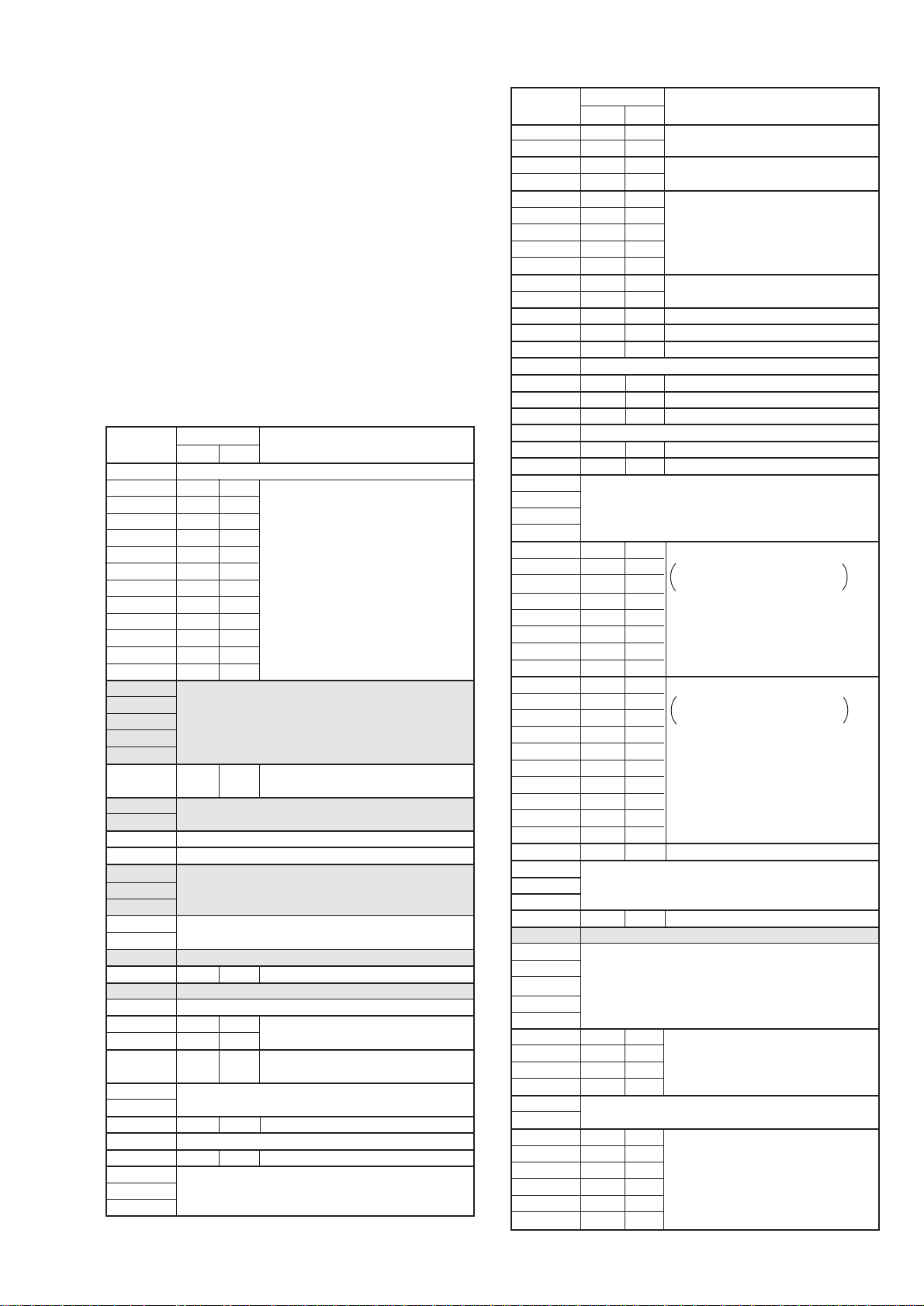
4. F Page table
Note 1:
Fixed data-1 : Initialized data.
( Refer to “1. Initializing the D,E,F Page Data”.)
Fixed data-2 : Modified data.
(Refer to “2. Modification of D, E, F Pa ge Data”).
Note 2: There are three models classif ied by CCD imager types as
shown below , and the initial value of adjustment is dif ferent
according to the model.
NTSC 510H model : CCD-TR311
PAL 510H model : CCD-TR311E/TR411E/TR412E/TR511E/
TR512E
PAL 760H model : CCD-TR640E/TR730E/TR840E/TR845E
Note 3 :There are three models classified by VTR for mats as shown
below, and the initial value of adjustment is different
according to the model.
NTSC Standard8 model : CCD-TR311
PAL Standard8 model : CCD-TR311E/TR411E/TR412E/
TR511E/TR512E/TR640E/TR730E
PAL Hi8 model : CCD-TR840E/TR845E
Address Initial V alue Remark
NTSC P A L
00 to 0F
10 00 00 Emergency memory address
11 00 00
12 00 00
13 00 00
14 00 00
15 00 00
16 00 00
17 00 00
18 00 00
19 00 00
1A 00 00
1B 00 00
1C Fixed data-2
1D
1E
1F
20
21 D2 <D2>, G-CAM flip adj. < > : PAL 760H model
[D0] [ ] : PAL 510H model
22 Fixed data-2
23
24 Fixed data-1
25 (Color reproduction adj.)
26 Fixed data-2
27
28
29 Fixed data-1
2A
2B Fixed data-2
2C A0 A0 28MHz origin osc. adj.
2D Fixed data-2
2E Fixed data-1
2F 80 80 Hall adj.
30 80 80
31 18 18/08 Max gain adj.
Note 2 : 510H model/ 760H model
32 Fixed data-1
33
34 1B 1B Color reproduction adj.
35 Fixed data-1
36 42 42 Color reproduction adj.
37 Fixed data-1
38
39
Address Initial V alue Remark
NTSC P A L
3A 89 89 Auto white balance adj.
3B 59 59
3C 38 38 IRIS IN/OUT adj.
3D 41 41
3E 25 25 Flange back adj.
3F 00 00
40 19 19
41 00 00
42 35 35
43 52 52 Angular velocity sensor
44 52 52 sensitivity adj.
45 7A 7A 1.5MHz deviation adj.
46 8D 8D 1.7MHz deviation adj.
47 7A 7A BPF f0 adj.
48 Fixed data-1
49 6B 6B Y OUT level adj.
4A 40 40 AFC f0 adj.
4B 9A 9A C OUT level adj.
4C Fixed data-1
4D 7B 7B Filter f0 adj.
4E 60 60 RP filter f0 adj.
4F Fixed data-1
50
51
52
53 40 40 REC Y current adj.
54 40 40 Addresses 57 to 5A are fixed
55 5F 40 data addresses.
56 5F 40
57 80 A1/80 Note 3 : Hi8 model/ Standard8 model
58 80 95/80
59 80 A1/80
5A 80 95/80
5B 50 50 REC L level adj.
5C 50 50 Addresses 63 to 64 are fixed
5D 43 50 data addresses.
5E 43 50
5F 66 66
60 66 66
61 67 66
62 67 66
63 80 7A/80 Note 3 : Hi8 model/ Standard8 model
64 80 7A/80
65 80 80 REC C current adj.
66 Fixed data-1
67
68
69 3C 3C CAP FG offset adj.
6A Fixed data-2
6B Fixed data-1
6C
6D
6E
6F
70 3B 3B AWB standard data input adj.
71 FF FF
72 56 56
73 7D 7D
74 Fixed data-1
75
76 1B 1B Flange back adj.
77 54 54
78 25 25
79 80 80
7A 10 10
7B FF FF
5-9
Page 86
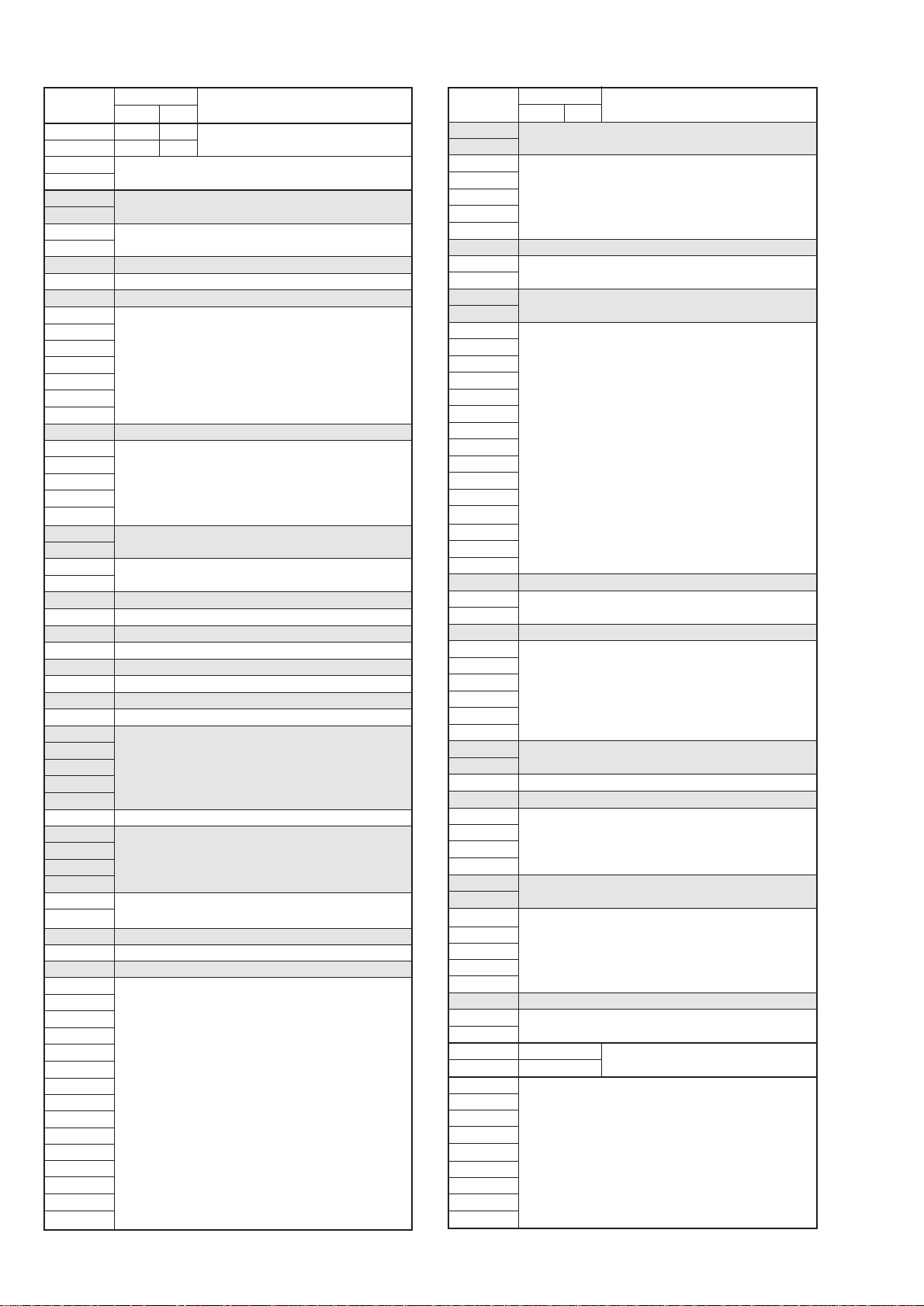
Address Initial V alue Remark
NTSC PAL
7C 0A 0A Switching position adj.
7D 00 00
7E Fixed data-1
7F
80 Fixed data-2
81
82 Fixed data-1
83
84 Fixed data-2
85 Fixed data-1
86 Fixed data-2
87 Fixed data-1
88
89
8A
8B
8C
8D
8E Fixed data-2
8F Fixed data-1
90
91
92
93
94 Fixed data-2
95
96 Fixed data-1
97
98 Fixed data-2
99 Fixed data-1
9A Fixed data-2
9B Fixed data-1
9C Fixed data-2
9D Fixed data-1
9E Fixed data-2
9F Fixed data-1
A0 Fixed data-2
A1
A2
A3
A4
A5 Fixed data-1
A6 Fixed data-2
A7
A8
A9
AA Fixed data-1
AB
AC Fixed data-2
AD Fixed data-1
AE Fixed data-2
AF Fixed data-1
B0
B1
B2
B3
B4
B5
B6
B7
B8
B9
BA
BB
BC
BD
Address Initial V alue Remark
NTSC PAL
BE Fixed data-2
BF
C0 Fixed data-1
C1
C2
C3
C4
C5 Fixed data-2
C6 Fixed data-1
C7
C8 Fixed data-2
C9
CA Fixed data-1
CB
CC
CD
CE
CF
D0
D1
D2
D3
D4
D5
D6
D7
D8
D9 Fixed data-2
DA Fixed data-1
DB
DC Fixed data-2
DD Fixed data-1
DE
DF
E0
E1
E2
E3 Fixed data-2
E4
E5 Fixed data-1
E6 Fixed data-2
E7 Fixed data-1
E8
E9
EA
EB Fixed data-2
EC
ED Fixed data-1
EE
EF
F0
F1
F2 Fixed data-2
F3 Fixed data-1
F4
F5 FF FF Color reproduction adj.
F6 F6 F4
F7 Fixed data-1
F8
F9
FA
FB
FC
FD
FE
FF
5-10
Page 87

5. E Page Table
Note 1:
Fixed data-1 :Initialized data.
( Refer to “1. Initializing the D,E,F Page Data”.)
Fixed data-2 :Modified data.
(Refer to “2. Modification of D, E, F P age Data”).
Address Initial V alue Remark
NTSC PAL
00 Fixed data-1
01
02
03
04
05
06
07
08
09
0A
0B
0C
0D
0E
0F
10
11
12
13
14 Fixed data-2
15 Fixed data-1
16
17
18
19
1A
1B
1C
1D
1E
1F
20
21
22
23
24
25
26
27
28
29
2A
2B Fixed data-2
2C
2D
2E
2F Fixed data-1
30
31
32
33
34
35
36
37
Address Initial V alue Remark
NTSC P A L
38 Fixed data-2
39
3A
3B Fixed data-1
3C
3D
3E
3F
40
41
42
43
44
45
46
47
48
49
4A
4B
4C
4D
4E
4F Fixed data-2
50 Fixed data-1
51 Fixed data-2
52
53 Fixed data-1
54
55
56
57
58
59 Fixed data-2
5A
5B Fixed data-1
5C Fixed data-2
5D Fixed data-1
5E
5F
60 Fixed data-2
61
62
63
64
65
66
67
68 Fixed data-1
69
6A
6B Fixed data-2
6C
6D Fixed data-1
6E Fixed data-2
6F
70
71
72 Fixed data-1
73 Fixed data-2
74 Fixed data-1
75 Fixed data-2
76 to 99 Fixed data-1
5-11
Page 88

Address Initial Value Remark
NTSC PAL
9A Fixed data-2
9B Fixed data-1
9C Fixed data-2
9D Fixed data-1
9E
9F
A0 Fixed data-2
A1
A2
A3
A4 Fixed data-1
A5
A6
A7
A8
A9
AA
AB
AC
AD
AE
AF
B0
B1
B2
B3
B4
B5
B6
B7
B8
B9
BA
BB
BC Fixed data-2
BD
BE
BF Fixed data-1
C0
C1
C2 B0 B0 VCO adj. (Color EVF)
C3 80 80 Bright adj. (Color EVF)
C4 77 77 Contrast adj. (Color EVF)
C5 80 80 White balance adj. (Color EVF)
C6 80 80
C7 Fixed data-2
C8
C9
CA
CB
CC B0 B0 Backlight consumption current adj.
(Color EVF)
CD Fixed data-1
CE
CF
D0
D1
D2
D3
D4
D5
D6
D7
D8
Address Initial V alue Remark
NTSC P A L
D9 Fixed data-1
DA
DB
DC
DD
DE
DF
E0
E1
E2
E3
E4
E5
E6
E7
E8
E9
EA Fixed data-2
EB
EC Fixed data-1
ED
EE
EF Fixed data-2
F0 Fixed data-1
F1
F2
F3 Fixed data-2
F4 Fixed data-1
F5
F6
F7
F8
F9
FA
FB
FC to FF
5-12
Page 89

1-3. CAMERA SYSTEM ADJUSTMENTS
Before perform the camera system adjustments, Check that the
specified value of “28MHz Origin Oscillation Adjustment”, “Y OUT
level Adjustment” and “C OUT level Adjustment” of “VIDEO
SYSTEM ADJUSTMENT” are satisfied.
1. G-CAM flip Adjustment
Set the color reproduction conditions to optimum.
Subject Color bar chart standard picture frame
Measurement Point Display data of page 1 of the adjusting
remote commander (Note 1)
Measuring Instrument
Adjustment Page F
Adjustment Address 21
Note 1. Displayed data of page 1 of the adjusting remote
commander.
XX : XX
1 :
n S2
n S1
Note 2. [ ] : CCD-TR311/TR640E/TR730E/TR840E/TR845E
< > : CCD-TR311E/TR411E/TR412E/TR511E/TR512E
Adjusting method:
1) Select page: 0, address: 01, and set data: 01.
2) Select page: 0, address: 03, and set data: 16.
3) Select page: F, address: 21, set data: [D2] <D0>, and press the
PAUSE button of the adjusting remote commander.
4) Select page 1 of the adjusting remote commander, and compare
the higher 2 digits (S1) and lower 2 digits (S2) of the 4-degits
display data.
When S1<S2
Perform steps 5) onwards.
When S1 S2
Perform steps “Processing after Completing Adjustments”.
5) Select page: F, address: 21, set data: [52] <50>, and press the
PAUSE button of the adjusting remote commander.
Processing after Completing Adjustments
1) Select page: 0, address: 03, and set data: 00.
2) Select page: 0, address: 01, and set data: 00.
5-13
Page 90

2. HALL Adjustment
For detecting the position of the lens iris, adjust the hall AMP gain
and offset.
Subject Not required
Measurement Point DDS display data of EVF or TV monitor
(Note 3)
Measuring Instrument
Adjustment Page F
Adjustment Address 2F , 30
Specified Value 90 to 94 during IRIS OPEN (Note 1)
19 to 1D during IRIS CLOSE (Note 2)
Note 1: Select page: 2, address: 01, set data: 01, and press the
PAUSE button of the adjusting remote commander.
Note 2: Select page: 2, address: 01, set data: 03, and press the
PAUSE button of the adjusting remote commander.
Note 3: DDS display data of EVF or TV monitor.
00 00XX
n Object data
Adjusting method:
1) Select page: 0, address: 01, and set data: 01.
2) Select page: 0, address: 03, and set data: 03.
3) Select page: D, address: 11, set data: 02, and press the PAUSE
button of the adjusting remote commander.
4) Select page: 2, address: 01, set data: 03, and press the PAUSE
button.
5) Select page: F, address: 30, set data: 80, and press the PAUSE
button.
6) Select page: F, address: 2F, set data: 40, and press the PAUSE
button.
7) Read the DDS display data (the bottom two digits of the displa y
data at the bottom right of the EVF display or the TV monitor),
and this data is named K2.
8) Select page: F, address: 2F, set data: 30, and press the PAUSE
button.
9) Read the DDS display data, and this data is named K
1.
10)Select page: 2, address: 01, set data: 01, and press the PAUSE
button.
11)Read the DDS display data, and this data is named W
1.
12) Select page: F, address: 2F, set data: 40, and press the PAUSE
button.
13)Read the DDS display data, and this data is named W
14)Con vert W
W
2' , K1' , K2'. (Refer to Table 5-1-2. “Hexadecimal notation -
1, W2, K1, K2, to decimal notation, and obtain W1' ,
2.
decimal notation conversion table”.)
15) Calculate X
1' using the following equations (decimal notation
calculation).
2'+ K1'– W1'– K2' Equation 1
A’= W
B’= W
1' – K1' Equation 2
X
1'=[1904+(48 x A’)–(16 x B’)] / A’ Equation 3
16)Convert X
1' to hexadecimal notation, and obtain X1.
(Round off to one decimal place)
17)Select page: F, address: 2F, set data: X
1, and press the PAUSE
button.
18)Select page: 2, address: 01, and set data: 01, and press the P A USE
button.
19)Select pa ge: F , address: 30, change the data and adjust the DDS
display data to “92”.
20)Press the PAUSE button of the adjusting remote commander.
21)Select page: 2, address: 01, and set data: 03, and press the P A USE
button.
22)Read the DDS display data, and this data is named K0. If K0 lies
within the “19” to “1D” range, perform “Processing after
completing adjustments”. If it is lies outside the range, perform
the following adjustments.
23)Convert K
24)Calculate X
0 to decimal notation, and obtain K0'.
2' using the following equations (decimal notation
calculation).
C’= 146 – B’– K
2'=[(119 – B’) x ( X1' – 48)+(48 x C’)] / C’
X
0' Equation 4
Equation 5
1' and B’ are values obtained from equations 2) and 3) )
( X
25)Convert X
2' to hexadecimal notation, and obtain X2.
(Round off to one decimal place)
26)Select page: F, address: 2F, set data: X
2, and press the PAUSE
button.
27)Select page: 2, address: 01, set data: 03, and press the PAUSE
button.
28)Select page: F, address: 30, change the data and adjust the DDS
display data to “1B”.
29)Press the PAUSE button of the adjusting remote commander.
30)Select page: 2, address: 01, set data: 01, and press the PAUSE
button.
31)Check the DDS display data lies within the “90” to “94” range.
Processing after Completing Adjustments
1) Select page: D, address: 11, and set data: 00, and press the PA USE
button.
2) Select page: 0, address: 01, and set data: 00.
3) Select page: 2, address: 01, and set data: 00, and press the P A USE
button.
4) Select page: 0, address: 03, and set data: 00.
5-14
Page 91
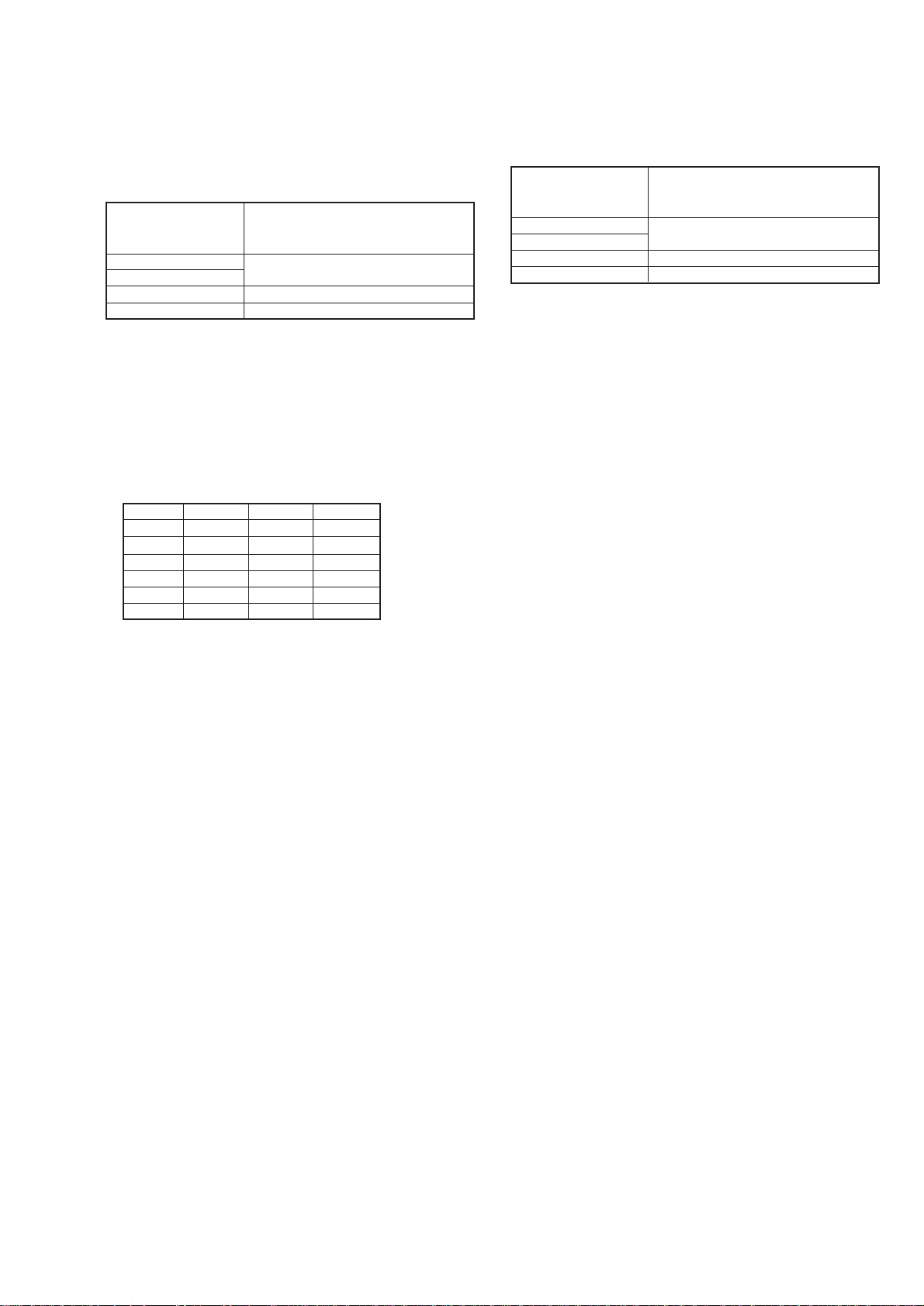
3. Flange Back Adjustment
The inner focus lens flange back adjustment is carried out
automatically. In whiche ver case, the focus will be de viated during
auto focusing/manual focusing.
3-1. Flange Back Adjustment(1)
Subject Flange back adjustment chart
(2.0 m from the front of the lens)
(Luminance: 300 ± 50 lux)
Measurement Point Check operation on TV monitor
Measuring Instrument
Adjustment Page F
Adjustment Address 3E to 42, 76 to 7B
Switch setting:
1) NIGHT SHOT switch...................................................... OFF
Adjusting method:
1) Check that at both the zoom lens TELE end and WIDE end, the
center of the chart for the flange back adjustment and center of
the exposure screen coincide.
2) Select page: 0, address: 01, and set data: 01.
3) Check that the data of page: F , address: 3E to 42, 76 to 7B is the
initial value (See table below).
Address Data Address Data
3E 25 77 54
3F 00 78 25
40 19 79 80
41 00 7A 10
42 35 7B FF
76 1B
4) Select page: 2, address: 02, and check that the data is “00 “.
5) Select page: 2, address: 01, set data: 13, and press the PAUSE
button of the adjusting remote commander.
6) Select page: 2, address: 01, set data: 15, and press the PAUSE
button of the adjusting remote commander.
(The adjustment data will be automatically input to page: F,
addresses: 3E to 42, 76 to 7B.)
7) Select page: 2, address: 02, and check that the data is „01“.
3-2. Flange Back Adjustment (2)
Perform this adjustment after performing “Flange Back Adjustment
(1)”.
Subject Subject more than 500m away
(Subjects with clear contrast such as
buildings, etc.)
Measurement Point Check operation on TV monitor
Measuring Instrument
Adjustment Page F
Adjustment Address 3E to 42, 76 to 7B
Switch setting:
1) NIGHT SHOT switch ...................................................... OFF
Adjusting method:
1) Set the zoom lens to the TELE end and expose a subject that is
more than 500 m away (subject with clear contrast such as
building, etc.). (Nearby subjects less than 500 m away should
not be in the screen.)
2) Select page: 0, address: 01, and set data: 01.
3) Select page: 2, address: 02, and check that the data is “00”.
4) Select pa ge: 2, address: 01, set data: 13, and press the PAUSE
button of the adjusting remote commander.
5) Place a ND filter on the lens so that the optimum image is obtain.
6) Select pa ge: 2, address: 01, set data: 29, and press the PAUSE
button of the adjusting remote commander.
(The adjustment data will be automatically input to page: F,
addresses: 3E to 42, 76 to 7B.)
7) Select page: 2, address: 02, and check that the data is “01”.
Processing after Completing Adjustments
1) Select page: 0, address: 01, and set data: 00.
2) Turn OFF the main power supply (8.4V).
3) Perform “Flange Back Check”.
Processing after Completing Adjustments
1) Turn OFF the main power supply (8.4V).
2) Perform “Flange Adjustment (2)”.
5-15
Page 92
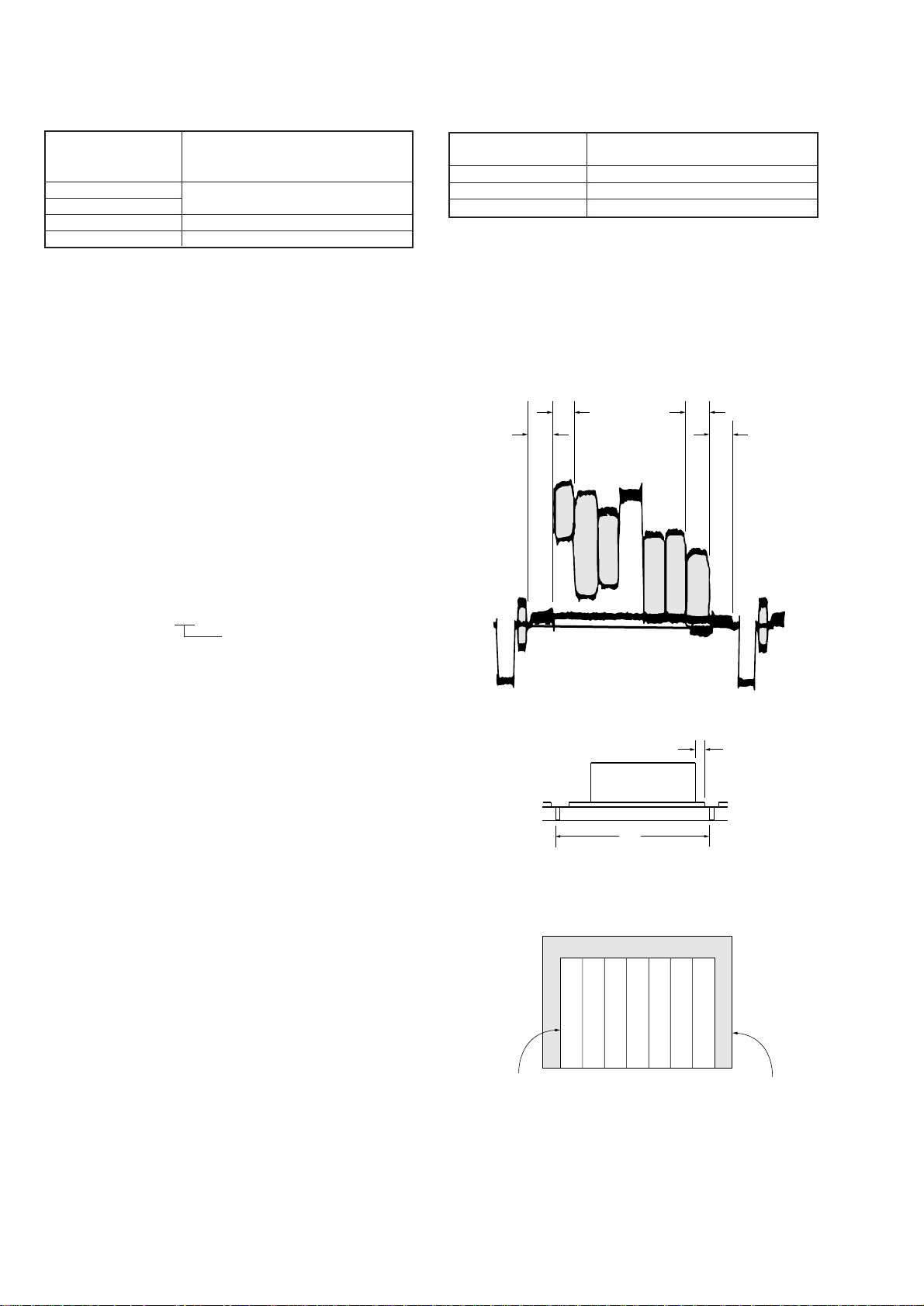
4. Flange Back Check
t=0 ± 0.1mesc
v
e
Subject Siemens star
(2.0 m from the front of the lens)
(Luminance: approx. 200 lux)
Measurement Point Check operation on TV monitor
Measuring Instrument
Adjustment Page F
Adjustment Address 3E to 42, 76 to 7B
Switch setting:
1) NIGHT SHOT switch...................................................... OFF
Checking method:
1) Place the Siemens star 2.0m from the front of the lens.
2) To open the IRIS, decr ease the luminous intensity to the Siemens
star up to a point before noise appear on the image.
3) Select page: 2, address: 40, and set data: 02.
4) Select page: 2, address: 41, and set data: 01.
5) Shoot the Siemens star with the zoom TELE end.
6) Turn on the auto focus.
7) Check that the lens is focused (Note1).
8) Select page: 2, address: 21, and set data: 10.
9) Shoot the Siemens star with the zoom WIDE end.
10) Observe the TV monitor and check that the lens is focused.
Note 1: When the auto focus is ON, the lens can be checked if it is
focused or not by observing the data on the page 1 of the
adjusting remote commander.
1) Select page: 0, address: 03, and set data: 0F.
2) Page 1 shows the state of the focus.
1 : 00 :
XX
n Odd: Focused
Even: Unfocused
5. Picture Frame Setting
Subject Color bar chart standard picture frame
(1.5m from the front of the lens)
Measurement Point Video output terminal
Measuring Instrument Oscilloscope and TV monitor
Specified Value A=B, C=D, t=0 ± 0.1msec
Setting method:
1) Adjust the zoom and the camera direction, and set to the specified
position.
2) Mark the position of the pictur e frame on the monitor display,
and adjust the picture frame to this position in following
adjustments using “Color bar chart standard picture frame”.
1. Horizontal period
A=B
B
A
C=D
C
D
Processing after Completing Adjustments
1) Select page: 2, address: 21, and set data: 00.
2) Select page: 0, address: 03, and set data: 00.
3) Select page: 2, address: 40, and set data: 00.
4) Select page: 2, address: 41, and set data: 00.
2. V ertical period
Color bar chart picture frame
Fig. 5-1-7.
TV monitor picture fram
Fig. 5-1-8.
5-16
Page 93
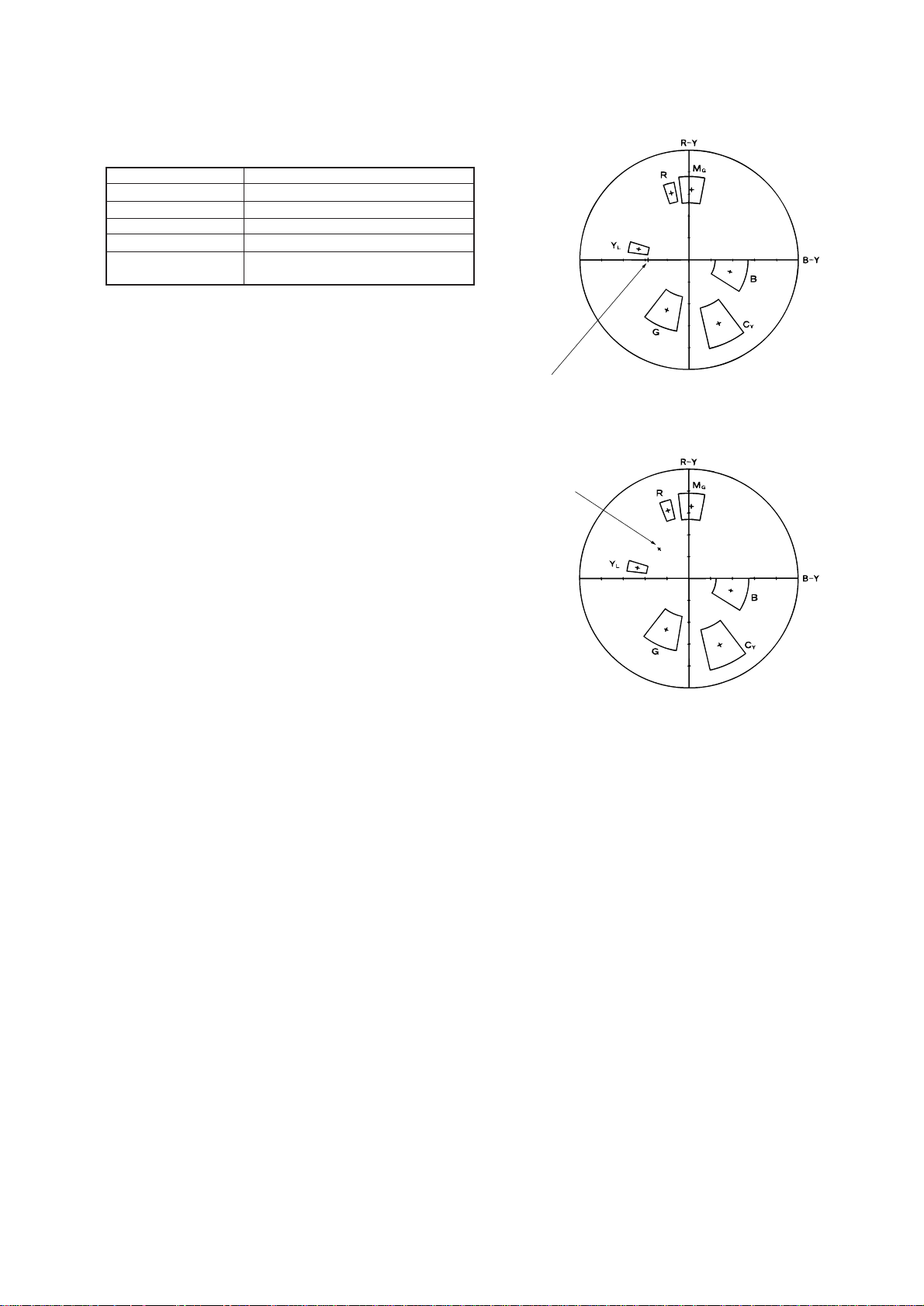
6. Color Reproduction Adjustment
Burst position
For NTSC 510H model
Burst position
For PAL 510H/PAL 760H model
Adjust the color Separation matrix coefficient so that proper color
reproduction is produced.
Subject Color bar chart standard picture frame
Measurement Point Video output terminal
Measuring Instrument V ectorscope
Adjustment Page F
Adjustment Address 34, 36, F5, F6
Specified Value All color luminance points should settle
within each color reproduction frame.
Note1: NTSC 510H model (CCD-TR311)
PAL 510H model (CCD-TR311E/TR411E/TR412E/
TR511E/TR512E)
PAL 760H model (CCD-TR640E/TR730E/TR840E/
TR845E)
Switch setting:
1) NIGHT SHOT switch...................................................... OFF
Adjusting method:
1) Select page: 0, address: 01, and set data: 01.
2) Select page: 2, address: 01, set data: 3D, and press the PAUSE
button of the adjusting remote commander.
3) Select page: F, address: 25, set data: 3F, and press the PAUSE
button of the adjusting remote commander.
4) Adjust the GAIN and PHASE of the vectorscope, and adjust the
burst luminance point to the burst position of the color
reproduction frame.
5) Change the data of page: F, address: 34, 36, F5 and F6, and
settle each color luminance point in each color reproduction
frame.
Note 2: Be sure to press the P A USE button of the adjusting r emote
commander before changing the of addresses. If not, the
new data will not be written to the memory.
6) Press the PAUSE button of the adjusting remote commander.
Processing after Completing Adjustments
1) Select page: 2, address: 01, and set data: 00, and press the PA USE
button of the adjusting remote commander.
2) Select page: 0, address: 01, and set data: 00.
Fig. 5-1-9.
5-17
Page 94

7. IRIS IN/OUT Adjustment
For the unit to judge if the white balance is indoors or outdoors in
auto white balance operations, measure the light level and write it
in the EEPROM.
If the level is not correct, the white balance will not be accurate.
Subject Clear chart
(Color bar standard picture frame)
Measurement Point DDS display of EVF or TV monitor
Measuring Instrument (Note 1)
Adjustment Page F
Adjustment Address 3C, 3D
Note 1: The right four digits of the display data at the right bottom side
of the EVF and TV monitor is the LIGHT LEVEL data.
XX XX
00
n Lower two digits
n Upper two digits
Switch setting:
1) STEADY SHOT (Menu display) .................................... OFF
2) NIGHT SHOT switch...................................................... OFF
Adjusting method:
1) Select page: 0, address: 01, and set data: 01.
2) Select page: 0, address: 03, and set data: 06.
3) Select page: D, address: 11, and set data: 02, and press the
PAUSE button of the adjusting remote commander.
4) Select page: 2, address: 40, and set data: 02.
5) Select page: 2, address: 01, set data: 0B, and press the PAUSE
button of the adjusting remote commander.
6) Read the DDS display data (Note 1), and take the upper two
digits as D
7) Conv ert D
1 and the lower two as D2.
1 to decimal notation, and obtain D1'. (Refer to T able
5-1-2. “Hexadecimal notation - decimal notation conversion
table” of “Service mode”.)
8) Calculate D
3' using the following equations. (Equations 1 and
2 are for decimal notation calculation).
When D
When D
9) Convert D
10) Select page: F, address: 3C, set data: D
2 D0
D
3' = D1' - 21 ................................................... Equation 1
2 < D0
3' = D1' - 22 ................................................... Equation 2
D
3' to hexadecimal notation, and obtain D3.
3, and press the PAUSE
button of the adjusting remote commander.
11) Select page: 2, address: 01, set data: 09, and press the PAUSE
button of the adjusting remote commander.
12) Read the DDS display data (Note 1), and take the upper two
digits as D4 and the lower two as D5.
13) Convert D
4 to decimal notation, and obtain D4'. (Refer to T able
5-1-2. “Hexadecimal notation - decimal notation conversion
table”.)
14) Calculate D
6' using the following equations. (Equations 3 and
4 are for decimal notation calculation).
When D
When D
15) Convert D
16) Select page: F, address: 3D, set da ta: D
5 F0
D
6' = D4' - 13 ................................................... Equation 3
5 < F0
D
6' = D4' - 14 ................................................... Equation 4
6' to hexadecimal notation, and obtain D6.
6, and press the PAUSE
button of the adjusting remote commander.
8. MAX GAIN Adjustment
Setting the minimum illumination.
If it is not consistent, the image lev el required for taking subjects in
low illuminance will not be produced (dark).
Subject Clear chart
(Color bar standard picture frame)
Measurement Point DDS display of EVF or TV monitor
Measuring Instrument (Note 1)
Adjustment Page F
Adjustment Address 31
Specified Value C0 to FF
Note 1: The right two digits of the display data at the right bottom
side of the EVF and TV monitor is the object data.
00 00 XX
n Object data
Note 2: NTSC 510H model (CCD-TR311)
PAL 510H model (CCD-TR311E/TR411E/TR412E/
TR511E/TR512E)
PAL 760H model (CCD-TR640E/TR730E/TR840E/
TR845E)
Switch setting:
1) STEADY SHOT (Menu display)...................................... OFF
2) NIGHT SHOT switch....................................................... OFF
Adjusting method:
1) Select page: 0, address: 01, and set data: 01.
2) Select page: D, address: 11, and set data: 02, and press the P A USE
button of the adjusting remote commander.
3) Select of page: 0, address: 03, and set data: 01.
4) Select page: 2, address: 40, and set data: 02.
5) Select page: 2, address: 56, and set data: 40.
6) Select pa ge: 2, address: 01, set data: 19, and press the PAUSE
button of the adjusting remote commander.
7) Select pa ge: F, address: 31, set data: [18] <08>, and press the
PAUSE button of the adjusting remote commander.
Note : [ ] : 510H model
< > : 760H model
8) Check that the DDS display data (Note 1) lies within the specified
value.
Processing after Completing Adjustments
1) Select page: D, address: 11, and set data: 00, and press the P A USE
button of the adjusting remote commander.
2) Select page: 0, address: 01, and set data: 00.
3) Select page: 2, address: 01, and set data: 00, and press the P A USE
button of the adjusting remote commander.
4) Select page: 2, address: 40, and set data: 00.
5) Select page: 2, address: 56, and set data: 00.
6) Select page: 0, address: 03, and set data: 00.
Processing after Completing Adjustments
1) Select page: D, address: 11, and set data: 00, and press the PA USE
button of the adjusting remote commander.
2) Select page: 0, address: 01, and set data: 00.
3) Select page: 2, address: 01, and set data: 00, and press the PAUSE
button of the adjusting remote commander.
4) Select page: 2, address: 40, and set data: 00.
5) Select page: 0, address: 03, and set data: 00.
5-18
Page 95

9. Auto White Balance Standard Data Input
Subject Clear chart
(Color bar standard picture frame)
Adjustment Page F
Adjustment Address 70 to 73
Note 1: Perf orm “Color Reproduction Adjustment” before this
adjustment.
Note 2: Check that the data of page: 2, address: 02 is 00. If not,
turn the power of the unit OFF/ON.
Switch setting:
1) NIGHT SHOT switch...................................................... OFF
Adjusting method:
1) Select page: 0, address: 01, and set data: 01.
2) Wait for 2 seconds.
3) Select page: 2, address: 01, and set data: 11, and press the PA USE
button of the adjusting remote commander.
4) Select page: 2, address: 01, and set data: 0D, and press the PA USE
button of the adjusting remote commander.
(When the standard data is take in, the data will be automatically
input to page: F, address: 70 to 73.)
5) Select page: 2, address: 02, and check that the data is “01”.
6) Perform “Auto White Balance Adjustment”.
Processing after Completing Adjustments
1) Select page: 2, address: 01, and set data: 00, and press the P A USE
button of the adjusting remote commander.
2) Select page: 0, address: 01, and set data: 00.
10. Auto White Balance Adjustment
Adjust to the proper auto white balance output data.
If it is not correct, auto white balance and color reproducibility will
be poor.
Subject Clear chart
(Color bar standard picture frame)
Filter Filter C14 for color temperature
correction
Measurement Point DDS display of EVF or TV monitor
Measuring Instrument (Note 1)
Adjustment Page F
Adjustment Address 3A, 3B
Specified Value R ratio: 2B40 to 2BC0
B ratio: 5E40 to 5EC0
Note 1: Perf orm “ Auto White Balance Standard Data Input” before
this adjustment.
Note 2: The right four digits of the display data at the right bottom
side of the EVF and TV monitor is the object data.
XXXX
00
n Object data
Switch setting:
1) NIGHT SHOT switch ...................................................... OFF
Adjusting method:
1) Place the C14 filter for color temperature correction on the lens.
2) Select page: 0, address: 01, and set data: 01.
3) Select page: D, address: 11, and set data: 02, and press the
PAUSE button of the adjusting remote commander.
4) Select page: 2, address: 01, and set data: 3F, and press the P A USE
button of the adjusting remote commander.
5) Select page: 0, address: 03, and set data: 04.
6) Select page: F, address: 3A, and c hange the data, and adjust the
average value of the DDS display data(Note 2) to the R ratio
specified value.
7) Press the PAUSE button of the adjusting remote commander.
8) Select page: 0, address: 03, and set data: 05.
9) Select page: F, address: 3B, and change the data, and adjust the
average value of the DDS display data(Note 2) to the B ratio
specified value.
10) Press the PAUSE button of the adjusting remote commander.
Processing after Completing Adjustments
1) Select page: D, address: 11, and set data: 00, and press the
PAUSE button of the adjusting remote commander.
2) Select page: 0, address: 01, and set data: 00.
3) Select page: 2, address: 01, and set data: 00, and press the PAUSE
button of the adjusting remote commander.
4) Select page: 0, address: 03, and set data: 00.
5-19
Page 96
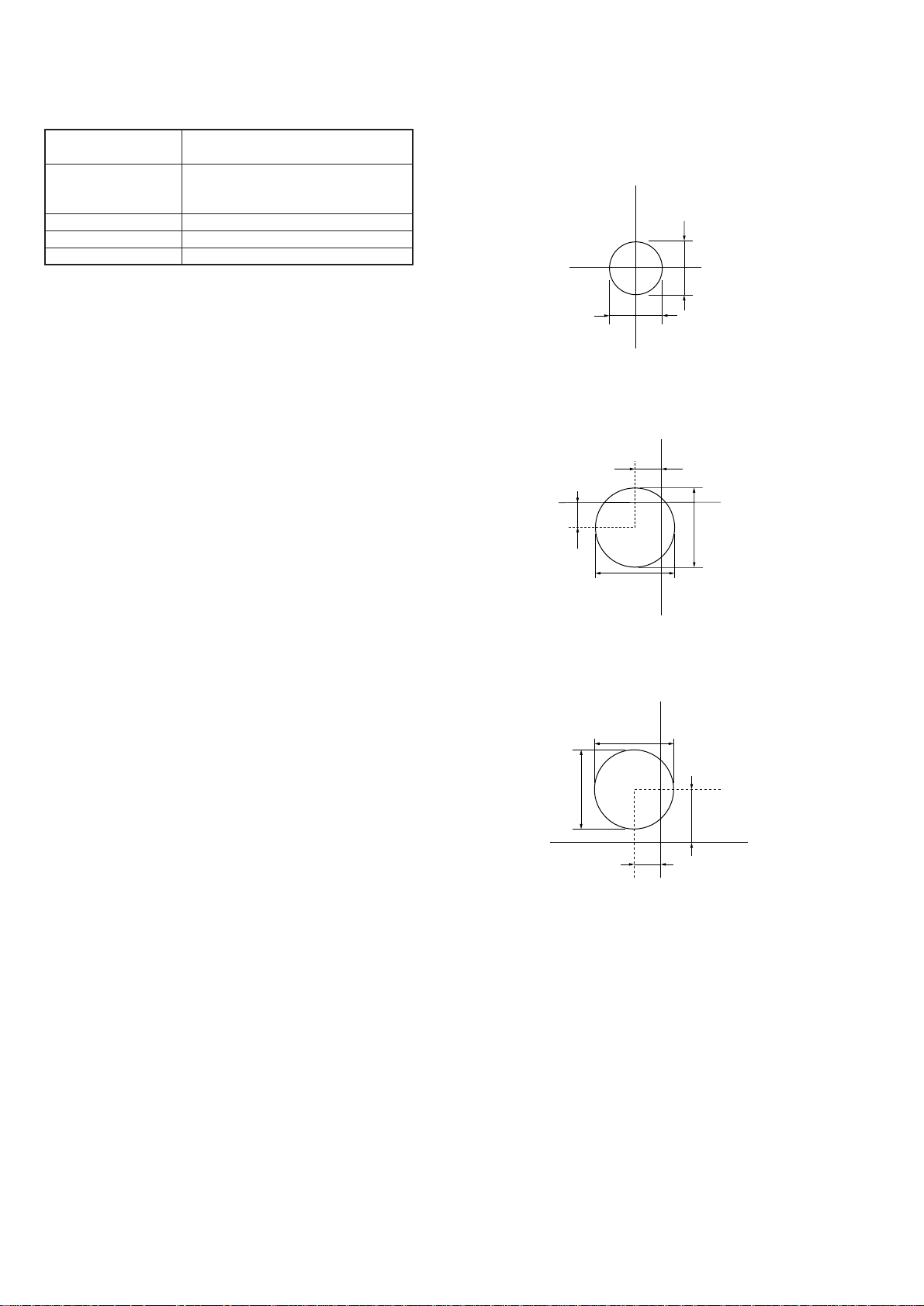
11. White Balance Check
1.0 mm
1.0 mm
B-Y
R-Y
3 mm
3 mm
Subject Clear chart
(Color bar standard picture frame)
Filter Filter C14 for color temperature
correction
ND filter 1.0 and 0.3
Measurement Point video output terminal
Measuring Instrument V ectorscope
Specified Value Fig. 5-1-10. A to C
Switch setting:
1) NIGHT SHOT switch...................................................... OFF
Checking method:
1) Check that the lens is not covered with either filter.
2) Select page: 2, address: 01, set data: 0F, and press the PAUSE
button of the adjusting remote commander.
3) Check that the center of the white luminance point is within the
circle shown Fig. 5-1-10.A.
4) Select page: 2, address: 01, set data: 00, and press the PAUSE
button of the adjusting remote commander.
5) Select page: 2, address: 01, set data: 23, and press the PAUSE
button of the adjusting remote commander.
6) Place the C14 filter on the lens.
7) Check that the center of the white luminance point settles in the
circle shown Fig. 5-1-10.B.
8) Remove the C14 f ilter, and place the ND filter 1.3 (1.0 +0.3) on
the lens.
9) Check that the white luminance point stopped moving, and then
remove the ND filter 1.3.
10) Check that the center of the white luminance point settles within
the circle shown Fig. 5-1-10.C.
Processing after Completing Adjustments
1) Select page: 2, address: 01, and set data: 00, and press the PA USE
button of the adjusting remote commander.
R-Y
2 mm
B-Y
2 mm
Fig.5-1-10. A
Fig.5-1-10. B
R-Y
3 mm
2.0 mm
3 mm
B-Y
1.0 mm
Fig.5-1-10. C
5-20
Page 97

12. Angular Velocity Sensor Sensitivity Adjustment
(CCD-TR640E/TR730E/TR840E/TR845E)
• This adjustment is performed only when replacing the angular
velocity sensor.
Although this adjustment need not be performed when the circuit
is damaged, etc., check the operations.
• Note down the sensitivity displayed on the angular velocity sensor
of the repair parts. At this time, note down also to which board it
was attached to.
Be sure to check because if attached incorrectly, the screen will
vibrate up and down or left and right during hand-shake correction
operations.
Precautions on the Parts Replacement
There are two types of repair parts.
Type A : ENC03EA or ENC 03JA
Type B : ENC03EB or ENC 03JB
Replace the broken sensor with a same type sensor. If replace with
other parts, the image will vibrate up and down or left and right
during hand-shake correction operations. After replacing, re-adjust
according to the adjusting method after replacement.
Precautions on Angular Velocity Sensor
The sensor incorporates a precision oscillator. Handle it with care
as if it dropped, the balance of the oscillator will be disrupted and
operations will not be performed properly.
Adjustment page F
Adjustment Address 43, 44
Note: The sensor sensitivity of SE451 and SE452 of the SE-65
board is written only on the repair parts.
Adjusting method:
1) Select page: 0, address: 01, and set data: 01.
2) Read the sensor sensitivity written on SE451 of the SE-65 board,
and take this as S
451.
3) Read the sensor sensitivity written on SE452 of the SE-65 board,
and take this as S
4) Calculate D
452.
43' and D44' using the following equation (decimal
calculation).
43' = 118 / S451
D
D44' = 106 / S452
5) Convert D43' and D44' into hexadecimal digits, to obtain D43 and
D
44. (Round off decimal points)
6) Select page: F, address: 43, set data: D
43, and press the PAUSE
button of the adjusting remote commander.
7) Select page: F, address: 44, set data: D
44, and press the PAUSE
button of the adjusting remote commander.
Processing after Completing Adjustments
1) Select page: 0, address: 01, and set data: 00.
2) Check that the steady shot operations have been performed
normally.
5-21
Page 98
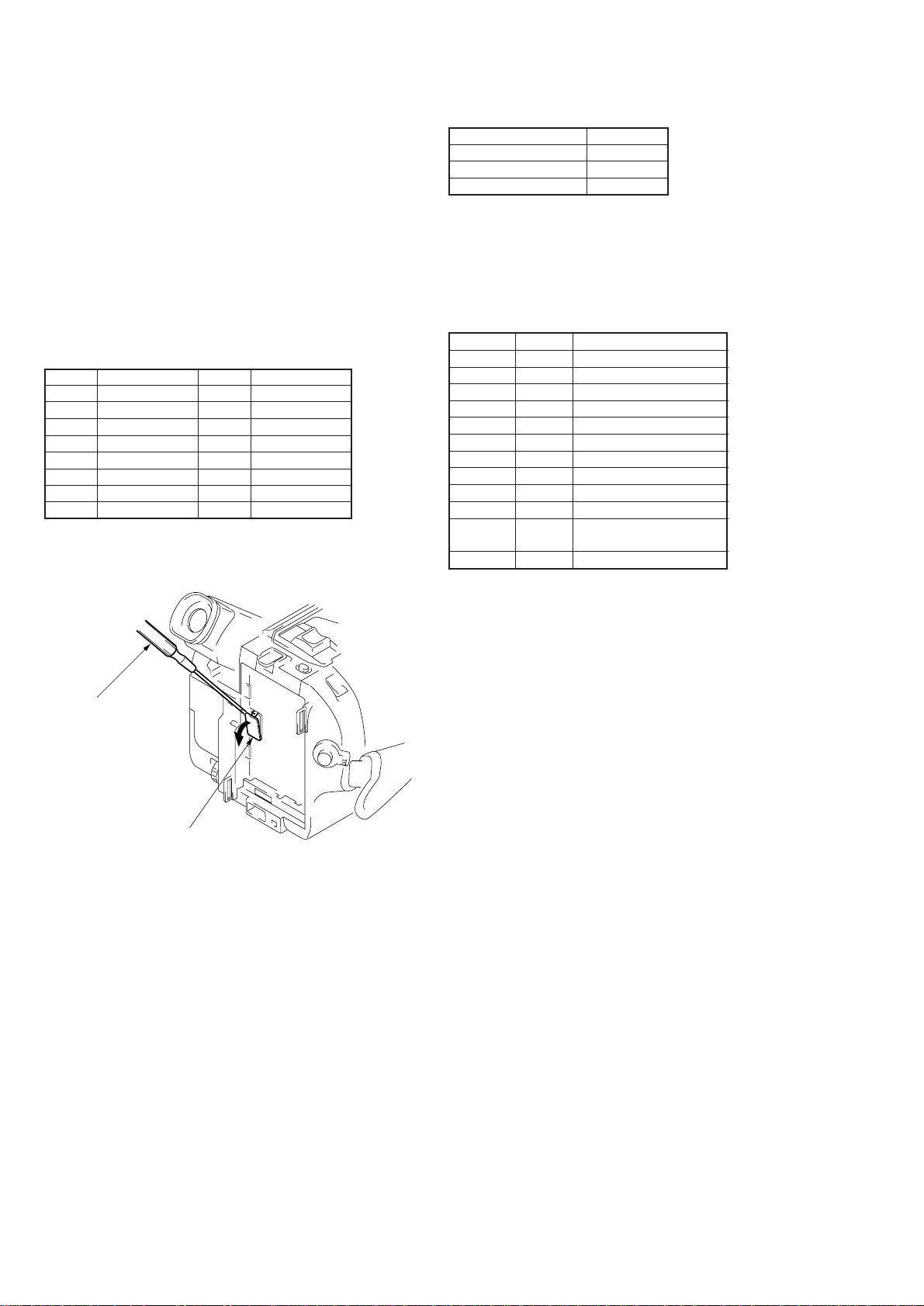
1-4. COLOR ELECTRONIC VIEWFINDER SYSTEM
ADJUSTMENT
(CCD-TR512E/TR730E)
Note 1: The back light (fluorescent tube) is dri ven by a high voltage
AC power supply. Therefore, do not touch the back light
holder to avoid electrical shock.
Note 2: When re placing the LCD unit, be careful to prevent
damages caused by static electricity.
[Adjusting connector]
Most of the measuring points for adjusting the viewfinder system
are concentrated in CN910 of the VC-195 board.
Connect the measuring instruments via the CPC-7 jig (J-6082-382A).
The following table shows the Pin No. and signal name of CN910.
Pin No. Signal Name Pin No. Signal Name
1 LANC SIG 9 RF AGC OUT
2 XCPC IN 10 REC RF
3 IR VIDEO 11 RF SWP
4 AFC F0 12 CAP FG
5 BPF MONI 13 EVF BL
6 PB RF 14 EVF BL 4.75V
7 RF AGC IN 15 VCO
8 REG GND 16 EVF VG
1. EVF Initial Data Input
Mode VTR stop
Signal No signal
Adjustment Page E
Adjusting Address C2 to CD
Adjusting method:
1) Select page: 0, address: 01, and set data: 01.
2) Select page: E, and input the data in the following table.
Note: To wr ite in the non-volatile memory (EEPROM), press
the P A USE button of the adjusting remote commander each
time to set the data.
3) Select page: 0, address: 01, and set data: 00.
Address Data Remark
C2 B0 VCO adjustment
C3 80 Bright adjustment
C4 77 Contrast adjustment
C5 80 White balance adjustment
C6 80 White balance adjustment
C7 68 Fixed value
C8 50 Fixed value
C9 F8 Fixed value
CA A8 Fixed value
CB 3C Fixed value
CC B0 Backlight Consumption
Current Adjustment
CD 70 Fixed value
Screw driver (–)
Cover
Fig.5-1-11.
5-22
Page 99
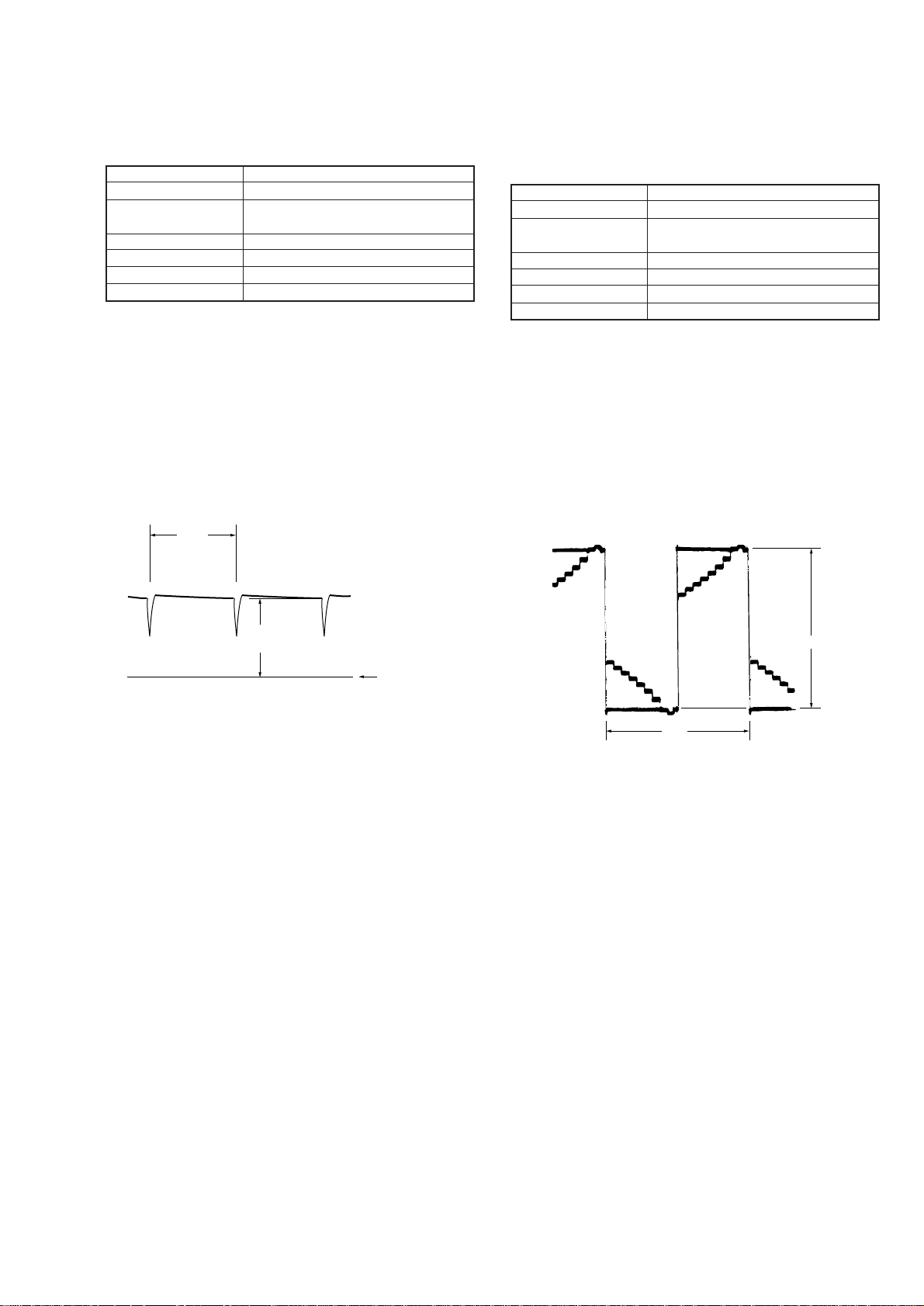
2. VCO Adjustment (VF-1 19 board)
Set the VCO free-run frequenc y . If deviated, the EVF screen will be
blurred.
Mode VTR stop
Signal No signal
Measurement point Pin !∞ of CN910 (VCO) on VC-195
board
Measuring instrument Oscilloscope (DC range)
Adjustment page E
Adjustment address C2
Specified value A = 1.8 ± 0.1Vdc
Adjusting method:
1) Select page: 0, address: 01, and set data: 01.
2) Select page: 3, address: 01, set data: 55, and press the PAUSE
button of the adjusting remote commander.
3) Check the GND level of the oscilloscope.
5) Select page: E, address: C2, change the data and set the VCO
output voltage (A) to the specified value.
4) Press the PAUSE button of the adjusting remote commander.
5) Select page: 3, address: 01, set data: 00, and press the PAUSE
button of the adjusting remote commander.
6) Select page: 0, address: 01, and set data: 00.
H
3. Bright Adjustment (VF-119 board)
Set the level of the VIDEO signal for driving the LCD to the specif ied
value. If deviated, the screen image will be blackish or saturated
(whitish).
Mode VTR stop
Signal No signal
Measurement point Pin !§ of CN910 (EVF VG) on VC-195
board
Measuring instrument Oscilloscope
Adjustment page E
Adjustment address C3
Specified value A = 7.2 ± 0.1 V
Adjusting method:
1) Select page: 0, address: 01, and set data: 01.
2) Select page: 3, address: 01, set data: 55, and press the PAUSE
button of the adjusting remote commander.
3) Select page: E, address: C3, change the data and set the voltage
(A) between the reversed waveform pedestal and non-reversed
waveform pedestal to the specified value.
4) Press the PAUSE button of the adjusting remote commander.
5) Select page: 3, address: 01, set data: 00, and press the PAUSE
button of the adjusting remote commander.
6) Select page: 0, address: 01, and set data: 00.
A
Fig. 5-1-12.
A
GND level
(0 Vdc)
2H
Fig. 5-1-13.
5-23
Page 100
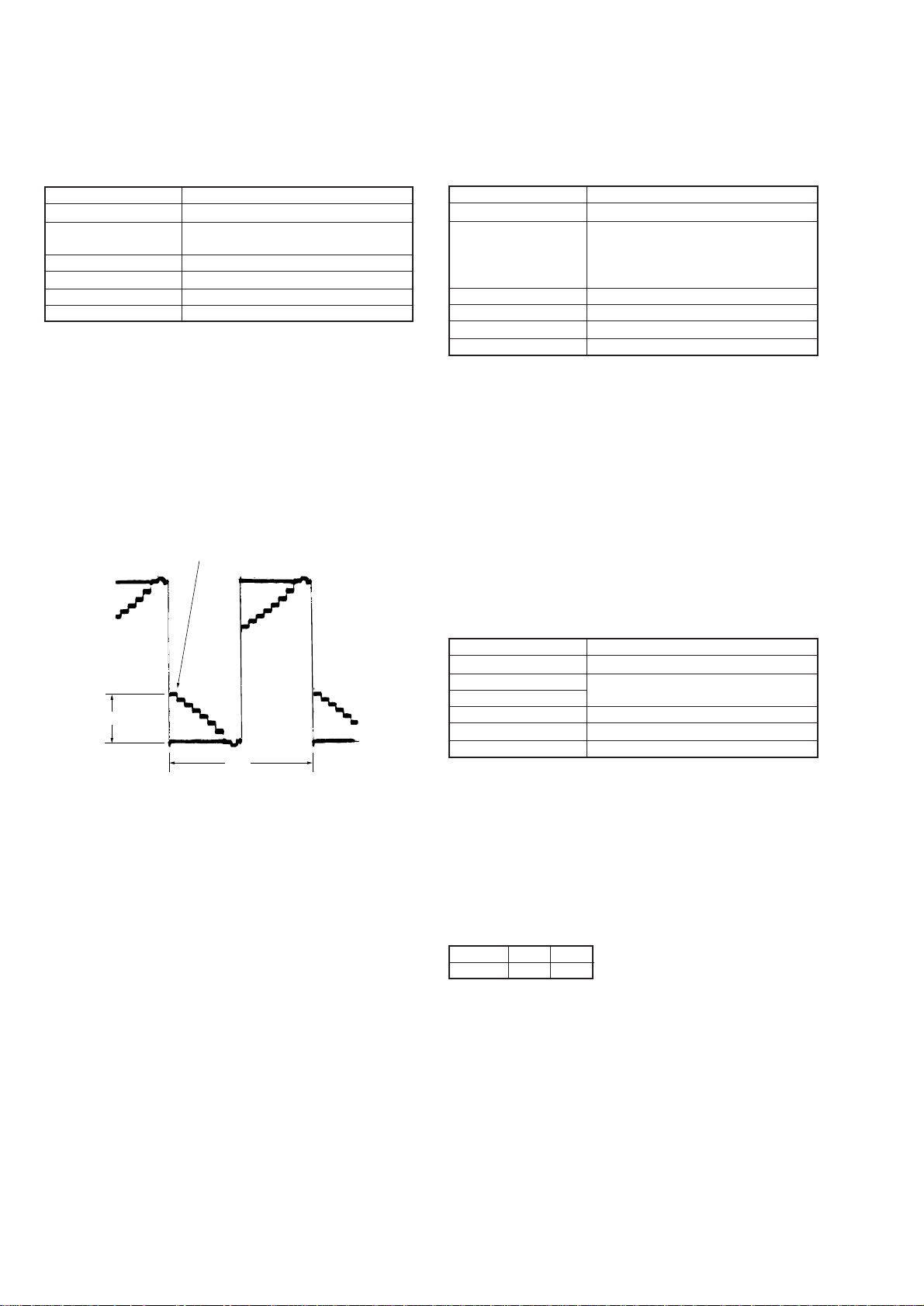
4. Contrast Adjustment (VF-119 board)
Set the level of the VIDEO signal for driving the LCD to the specified
value. If deviated, the screen image will be blackish or saturated
(whitish).
5. Backlight Consumption Current Adjustment (VF-120
board)
Set the backlight luminance and color temperature.
If deviated, the image may become dark or bright.
Mode VTR stop
Signal No signal
Measurement Point Pin !§ of CN910 (EVF VG) on
VC-195 board
Measuring Instrument Oscilloscope
Adjustment Page E
Adjustment Address C4
Specified Value A = 2.0 ± 0.1V
Adjusting method:
1) Select page: 0, address: 01, and set data: 01.
2) Select page: 3, address: 01, set data: 55, and press the PAUSE
button of the adjusting remote commander.
3) Select page: E, address: C4, change the data and set the voltage
(A) between the 7 step peak and the pedestal to the specified
value.
4) Press the PAUSE button of the adjusting remote commander.
5) Select page: 3, address: 01, set data: 00, and press the PAUSE
button of the adjusting remote commander.
6) Select page: 0, address: 01, and set data: 00.
7 step peak
A
2H
Fig. 5-1-14.
Mode VTR stop
Signal No signal
Measurement Point + Probe: Pin !¢ of CN910
(EVF BL 4.75V) on VC-195 board
– Probe: Pin !£ of CN910 (EVF BL)
on VC-195 board
Measuring Instrument Digital voltmeter
Adjustment Page E
Adjustment Address CC
Specified Value A = 21.0 ± 1.0 mVdc
Note: Adjust 30 seconds after running on the power supply.
Adjusting method:
1) Select page: 0, address: 01, and set data: 01.
2) Select pa ge: 3, address: 01, set data: 55, and press the PAUSE
button of the adjusting remote commander.
3) Select page: E, address: CC, change the data and set the voltage
difference (A) between Pin !¢ of CN910 (EVF BL 4.75V) and
Pin !£ of CN910 (EVF BL) to the specified value.
4) Press the PAUSE button of the adjusting remote commander.
5) Select pa ge: 3, address: 01, set data: 00, and press the PAUSE
button of the adjusting remote commander.
6) Select page: 0, address: 01, and set data: 00.
6. White Balance Adjustment (VF-119 board)
Correct the white balance.
If deviated, the reproduction of the EVF screen may degenerate.
Mode VTR stop
Signal No signal
Measurement Point Check on EVF screen
Measuring Instrument
Adjustment Page E
Adjustment Address C5, C6
Specified Value The EVF screen should not be colored.
Adjusting method:
1) Select page: 0, address: 01, and set data: 01.
2) Select pa ge: 3, address: 01, set data: 51, and press the PAUSE
button of the adjusting remote commander.
3) Select page: 2, address: 7D, and set data: 03.
4) Select page: E, address: C5 and C6, set the data to the initial
value.
Note: To wr ite in the non-volatile memory (EEPROM), press
the P A USE button of the adjusting remote commander each
time to set the data.
Address C5 C6
Data 80 80
5) Check that the LCD screen is not colored. If colored, change the
data of page: E, address: C5 and C6 so that the EVF screen is
not colored.
Note: To wr ite in the non-volatile memory (EEPROM), press
the P A USE button of the adjusting remote commander each
time to set the data.
6) Select page: 2, address: 7D, and set data: 00.
7) Select pa ge: 3, address: 01, set data: 00, and press the PAUSE
button of the adjusting remote commander.
8) Select page: 0, address: 01, and set data: 00.
5-24
